A Preliminary Assessment of Specular Radar Cross Section Performance in the Chengdu J-20 Prototype
Air Power Australia Analysis 2011-03
4th July 2011
| A Monograph by
Dr Michael J Pelosi, MBA, MPA,
Dr Carlo Kopp, SMAIAA, SMIEEE, PEng
Text, computer graphics © 2011 Michael Pelosi, © 2011 Carlo Kopp
|
| 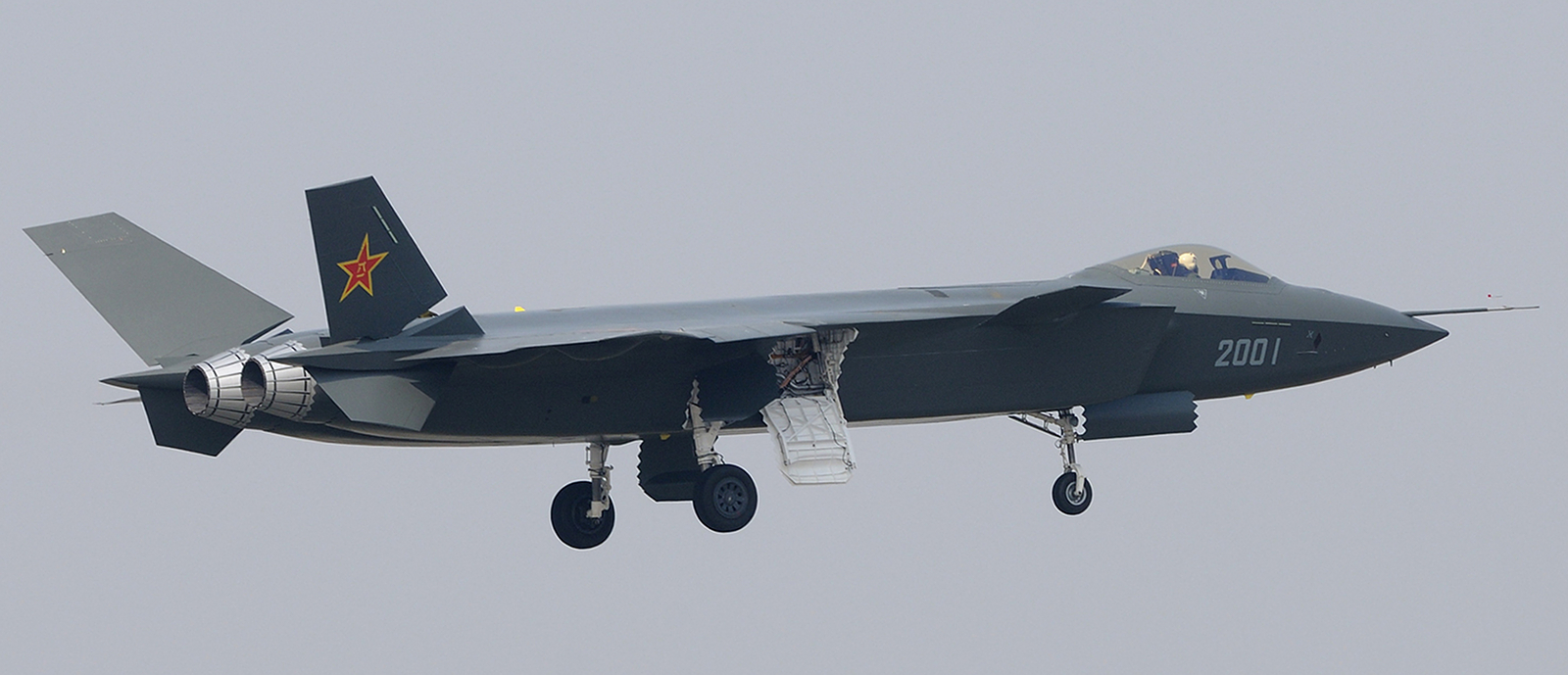
First public flight of the Chengdu J-20 prototype, 11th January, 2011 [click to enlarge]. The shaping design of the J-20 presents no fundamental obstacles to its development into a genuine Very Low Observable design (Chinese Internet).
|
| Abstract
|
|
| This study has explored the specular Radar Cross Section of the Chengdu J-20 prototype aircraft shaping design. Simulations using a Physical Optics simulation algorithm were performed for frequencies of 150 MHz, 600 MHz, 1.2 GHz, 3.0 GHz, 6.0 GHz, 8.0 GHz, 12.0 GHz, 16.0 GHz and 28 GHz without an absorbent coating, and for frequencies of 1.2 GHz, 3.0 GHz, 6.0 GHz, 8.0 GHz, 12.0 GHz, 16.0 GHz with an absorbent coating, covering all angular aspects of the airframe. In addition, the performance of a range of Chinese developed radar absorbers was modelled, based on a reasonable survey of unclassified Chinese research publications in the area. None of the surveyed materials were found to be suitable for use as impedance matched specular radar absorbers. Modelling has determined, that if the production J-20 retains the axisymmetric nozzles and smoothly area ruled sides, the aircraft could at best deliver robust Very Low Observable performance in the nose aspect angular sector. Conversely, if the production J-20 introduces a rectangular faceted nozzle design, and refinements to fuselage side shaping, the design would present very good potential for robust Very Low Observable performance in the S-band and above, for the nose and tail aspect angular sectors, with good performance in the beam aspect angular sector. This study has therefore established through Physical Optics simulation across nine radio-frequency bands, that no fundamental obstacles exist in the shaping design of the J-20 prototype precluding its development into a genuine Very Low Observable design.
|
|
|
|
|
|
| |
Introduction
There has been extensive media speculation about the Radar Cross Section [RCS] of the J-20 stealth fighter, since the PLA-AF first exposed the prototype to the public in late December, 20104. Sadly much of this speculation has no valid scientific basis, yet appears to be regarded seriously enough to have influenced public statements by numerous senior officials in Western defence departments.
Performing a full assessment of the RCS of any Low Observable [LO / -10 to -30 dBSM, Refer Table A.1] or Very Low Observable [VLO / -30 to -40 dBSM, Refer Table A.1] aircraft is not a trivial task, as due consideration needs to be given to all major and minor RCS contributors in the design.
Moreover, such an assessment, if it is to be useful, must consider the RCS from a range of different angular aspects, this encompassing azimuthal sectors and also elevation or depression angles characteristic of the surface and airborne threat systems the LO/VLO design is intended to defeat [Refer Figures A.3 and A.4].
The assessment of RCS must also be performed at the operating wavelengths typical of the surface and airborne threat systems the LO/VLO design is intended to defeat [Refer Table A.2].
Definitions of these and other terms employed in this document are summarised in Annex E. Reference data for RCS scales, radio-frequency bands, engagement geometries, and representative threat systems are summarised in Annex A.
If the RCS assessment does not consider angular and wavelength dependencies properly, it will be almost meaningless, in terms of providing a means of determining or estimating the survivability of the LO/VLO design. The common practice of providing a single RCS value for a single aspect at a single frequency yields little information about the actual effectiveness of the design. Such a single point figure permits at best a detection range estimate for a known radar operating at the specified wavelength and aspect.
The PLA's J-20 prototype is an important development in terms of grand strategy, as well as technological strategy, and basic technology. It shows that PLA thinking at the strategic level is focussed on defeating opposing IADS [Integrated Air Defence System] and fighter forces. In the domain of technological strategy, it shows a robust grasp of the limitations of Western technology deployed in Asia. In terms of basic technology, it shows that China's academic research and industrial base has mastered advanced LO/VLO shaping techniques.
The intent of this study is to perform a preliminary assessment of the RCS of the J-20 prototype, to establish the potential of the aircraft to be fully developed as an LO/VLO combat asset.
The assessment cannot be more than preliminary for a number of good reasons:
The final airframe shaping remains unknown, and changes may arise through the development cycle, to improve aerodynamic performance, operational characteristics, and LO/VLO performance; The state of Chinese Radar Absorbent Materials (RAM), Radar Absorbent Structures (RAS) and radar absorbent coatings technology is not well understood in the West; The state of Chinese technologies for sensor aperture (radar, EO, passive RF) structural mode RCS reduction is not well understood in the West; The state of Chinese technologies for RCS flare spot reduction, in areas such as navigation/communications antennas, seals, panel joins, drain apertures, cooling vents, and fasteners is not well understood in the West.
Achievement of credible LO or VLO performance is the result of a design having intended RCS characteristics in all of these categories1.
The relative importance of the respective categories should be discussed.
Sound airframe shaping is a necessary prerequisite for good LO or VLO performance. If shaping is poor, no amount of credible materials application and detail flare spot reduction will overcome the RCS contributions produced by the airframe shape, and genuine VLO performance will be unattainable.
If airframe shaping is sound, then careful and well considered application of Radar Absorbent Materials (RAM), Radar Absorbent Structures (RAS), radar absorbent coatings, aperture RCS reductions, and minor flare spot reductions techniques will yield a VLO design.
As a result, modelling of the shape related RCS contributions of any VLO design is of very high value, as it determines not only whether the aircraft can achieve credible VLO category performance, but also where the designers will be investing effort in RAS, RAM and coating application to achieve this effect.
This paper will focus mostly on shape related RCS contributions, due to the uncertainties inherent in estimating the performance of unknown technologies for RAS, RAM, coatings, aperture RCS reductions, and minor flare spot reduction. Where applicable, reasonable assumptions will be made as to the performance of absorbent material related RCS reduction measures. Some tentative modelling of published Chinese RAM coatings will be performed.
|
J-20 Prototype Very Low Observable Airframe Shaping Design Features
The J-20 prototype designs displays a number of VLO design features, generally based on design rules developed for and employed in the construction of United States VLO combat aircraft. These display a good theoretical and practical understanding of the VLO design rules developed by US researchers in industry and US government research laboratories, between 1975 and 2000.
Overall, the stealth shaping of the J-20 prototype design is without doubt considerably better than that seen in the Russian T-50 PAK-FA prototypes and, even more so, than that seen in the intended production configuration of the United States' F-35 Joint Strike Fighter2,3.
The J-20 design appears to be mostly constructed around the stealth shaping design rules employed in the US Air Force F-22A Raptor4:
The chined J-20 nose section and canopy are close in appearance to the F-22, yielding similar specular RCS performance in a mature design. The J-20 trapezoidal edge aligned engine inlets are closest to the F-22, though they appear to be larger and employ an F-35 style DSI (Diverterless Supersonic Inlet) design, obviously intended to improve on F-22 inlet leading edge signature. The J-20 wing fuselage join, critical for beam and all aspect stealth, is in shaping and angle very similar to the F-22, and clearly superior to both the T-50 PAK-FA prototypes and the F-35 Joint Strike Fighter. The J-20 flat lower fuselage is optimal for all aspect wideband stealth, and emulates the F-22 design closely. It can produce a significant ground bounce return in some geometries, especially at lower altitudes, or angles approaching the normal.
Planform alignment of the J-20 shows exact angular alignment between canard and delta leading edges, and exact crossed (starboard to port, port to starboard) angular edge alignment between canard and delta trailing edges. Leading edge sweep is ~43°, clearly intended for efficient supersonic flight. The J-20 nose and main undercarriage, and cheek weapon bay doors employ C-band through Ku-band optimised edge serration technology, based on F-117A and F-22 design rules. The aft fuselage, tailbooms, fins/strakes and axi-symmetric nozzles are not compatible with high stealth performance, but may only be stop-gap measures to expedite flight testing of a prototype. Performance is notably poorer in the H polarisation.
The airframe configuration and aft fuselage shape would be compatible with an F-22A style 2D TVC nozzle design, or a non-TVC rectangular nozzle designed for controlled infrared emission patterns and radio-frequency stealth. Infrared signature will be influenced by other considerations, especially engine bypass ratio. The choice of all moving slab stabilators and canards will impact RCS at deflection angles away from the neutral position. If large control deflections are produced in flight regimes other than close combat manoeuvring, the specular RCS of the all moving slab controls would need to be considered.
A qualitative assessment of the J-20 prototype clearly shows that the design has the potential for VLO capability, certainly in the very important forward hemisphere.
Available imagery from similar or identical aspects permits direct comparisons between the J-20 and the United States F-22A and F-35 designs.
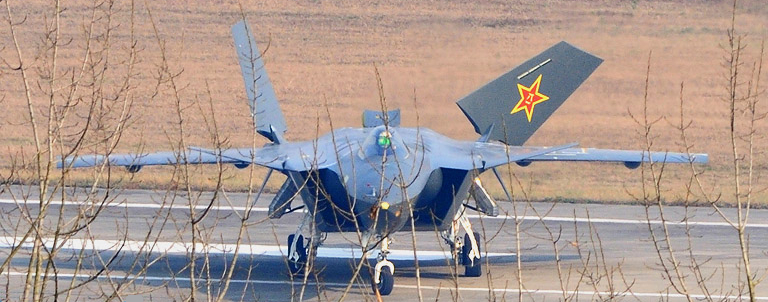
Elevated head on view of J-20 prototype showing the trapezoidal edge aligned inlet geometry, combining features of the F-22A Raptor and F-35 JSF inlet. Both aircraft share shallow wing/fuselage join angles and a flat lower fuselage (Chinese Internet).
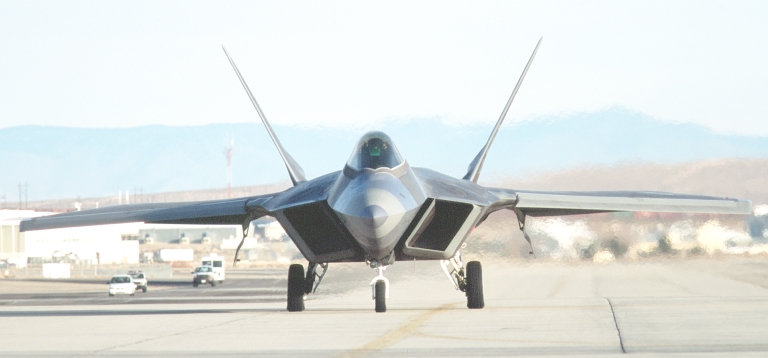
Head on view of F-22A Raptor showing the trapezoidal edge aligned inlet geometry (US Air Force).
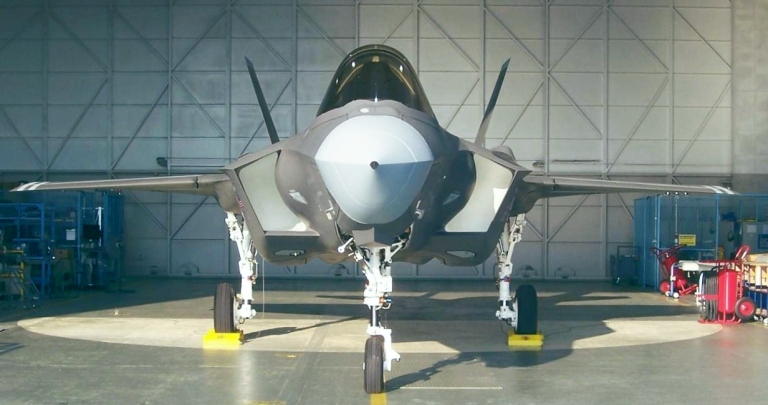
The shaping features of the inlet area and unique lower fuselage are prominent on this image of F-35A SDD prototype AA-1 (Image via Air Force Link).
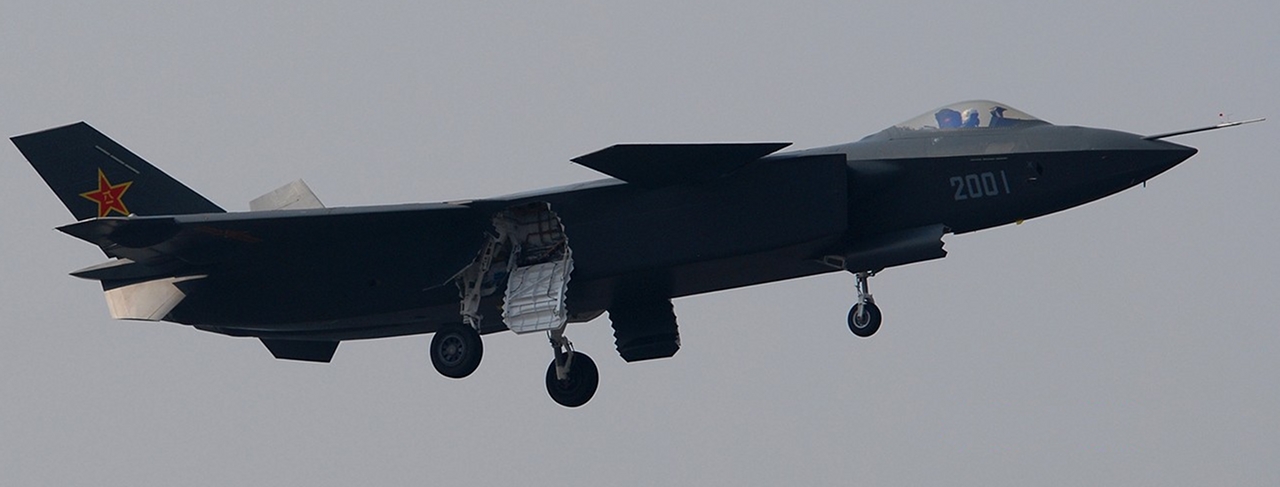
This J-20 view shows the chine geometry, and generous use of X-band serrations on the undercarriage doors (Chinese Internet).
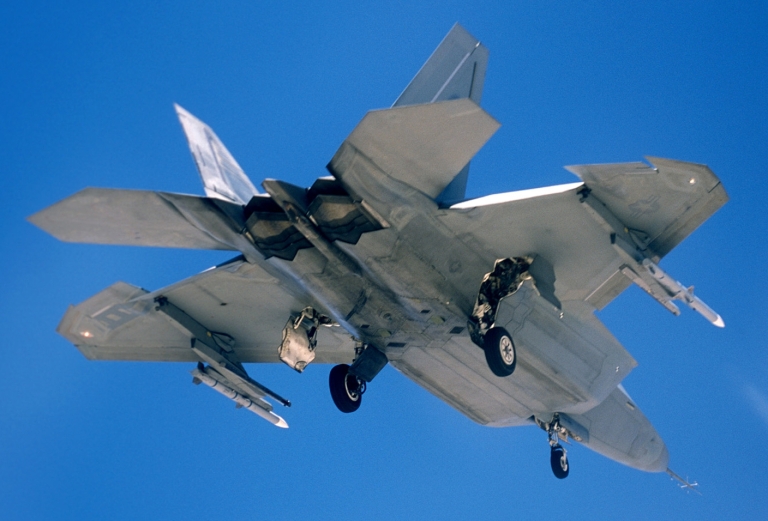
Ventral view of F-22A Raptor with undercarriage extended (US Air Force).
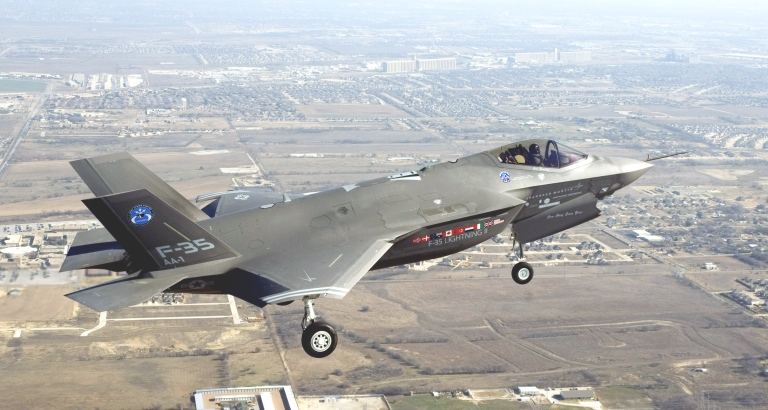
F-35 JSF SDD airframe in flight showing chine angles and upper fuselage curvature (U.S. Air Force photo).
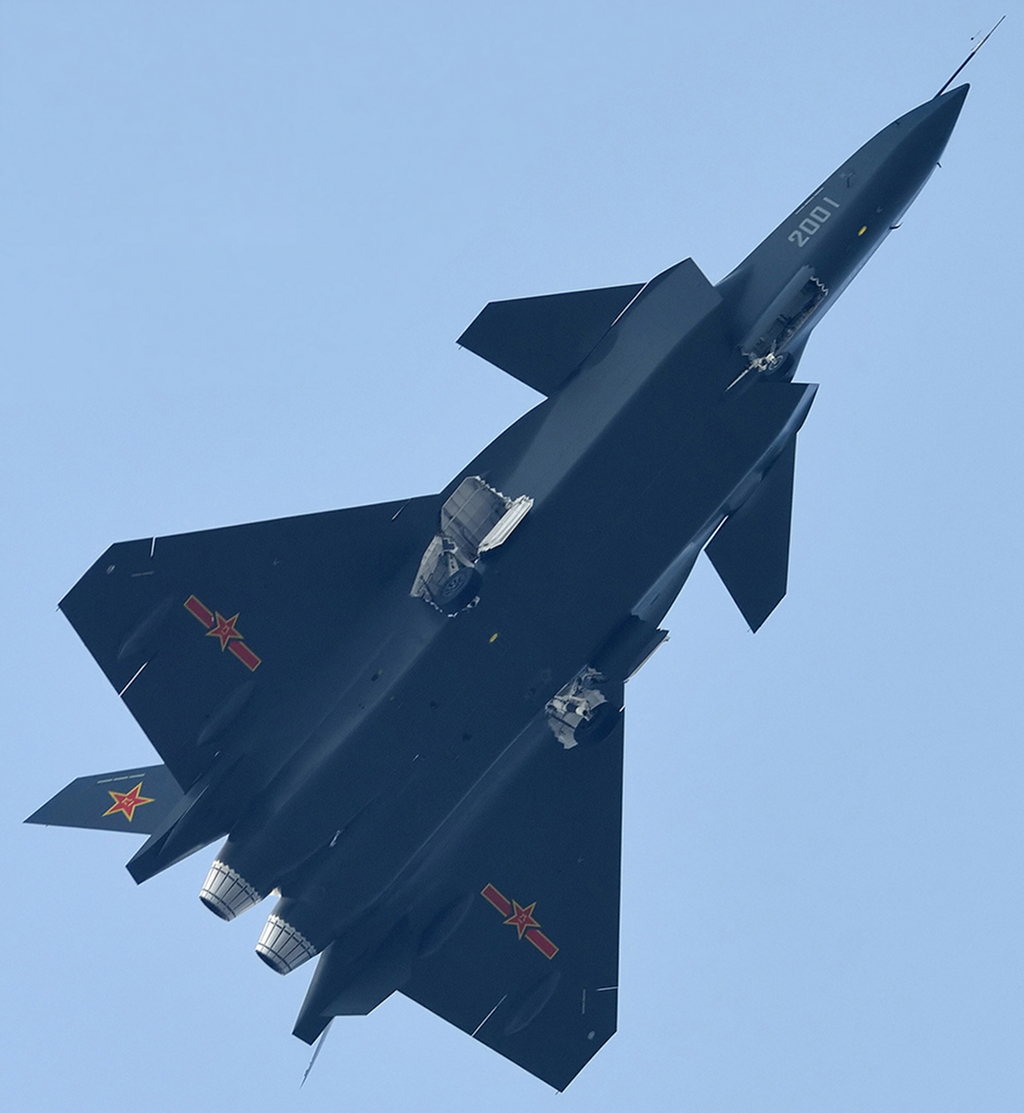
Ventral view of J-20 prototype showing the flat lower fuselage, flat facet fuselage sides, and shallow join angle between the wings, canards and fuselage sides. The aft ventral strakes are undesirable from an RCS perspective (Chinese Internet).
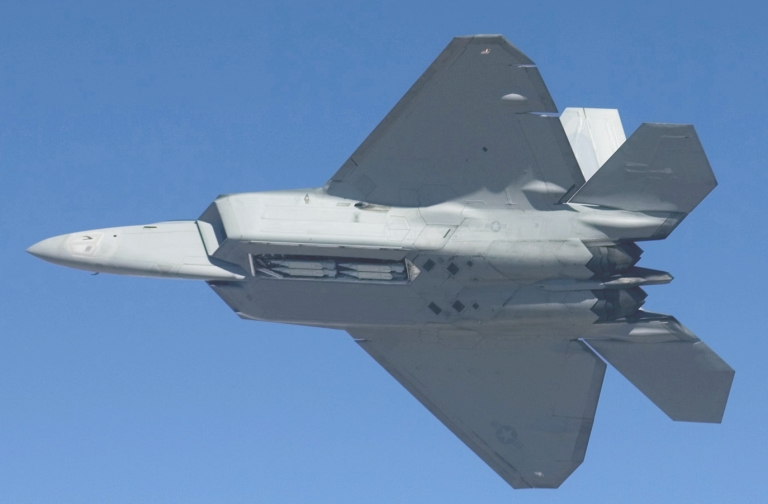
Ventral view of F-22A Raptor showing the flat lower fuselage, flat facet fuselage sides, and shallow join angle between the wings, horizontal tails and fuselage sides (U.S. Air Force photo).

Ventral view of F-35A SDD aircraft showing the deeply sculpted lower fuselage, doubly curved fuselage sides, and steep angle multiple step join between the wings and fuselage sides (U.S. Air Force photo).
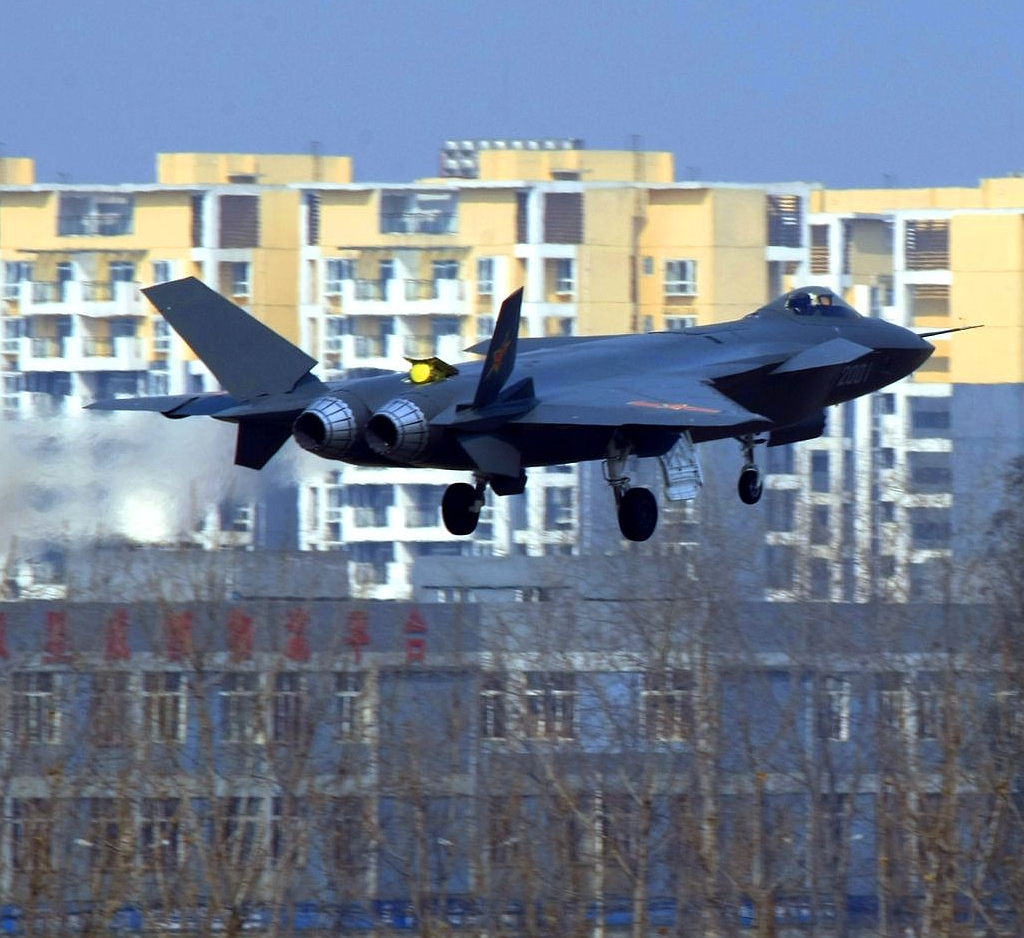
Aft view of J-20 prototype showing the serrated axi-symmetric nozzles, modelled on the F-35 JSF design, the strakes and all moving tails, and deflected canards (Chinese Internet).
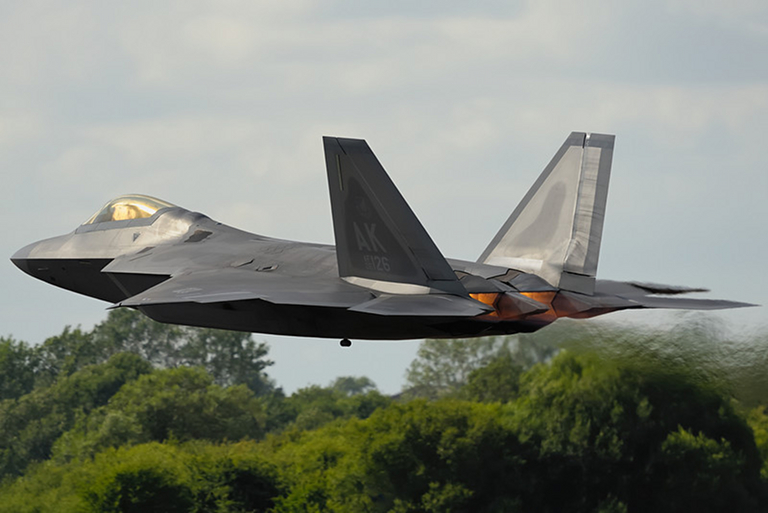
Aft view of F-22A Raptor displaying the rectangular TVC nozzles (© 2010, Jeroen Oude Wolbers).
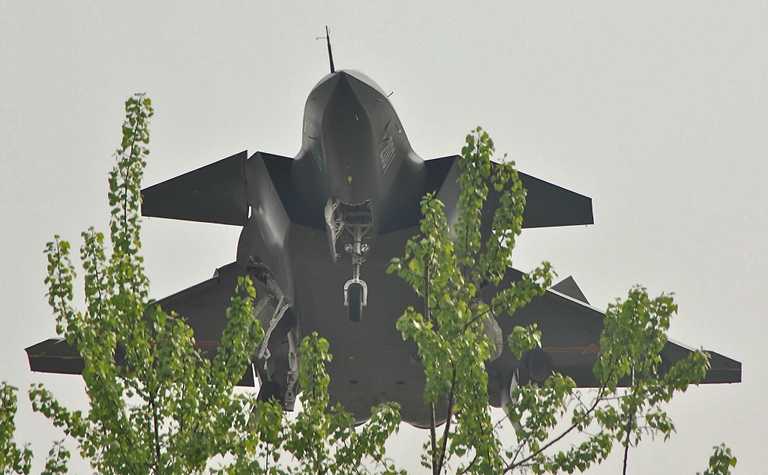
Forward ventral view of J-20 prototype showing the flat lower fuselage, flat facet fuselage sides, and shallow join angle between the wings, canards and fuselage sides. Note the detail of the inlet geometry (Chinese Internet).
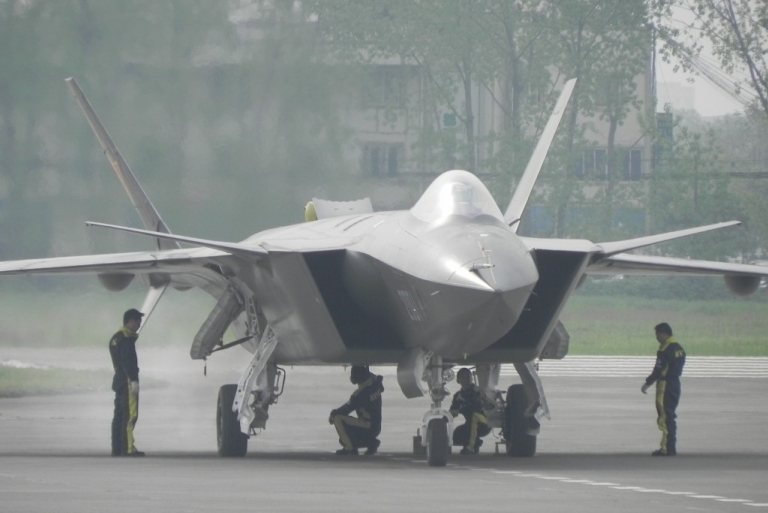
Near head on view of J-20 prototype showing the trapezoidal edge aligned inlet geometry , wing/fuselage join, and flat lower fuselage (Chinese Internet).
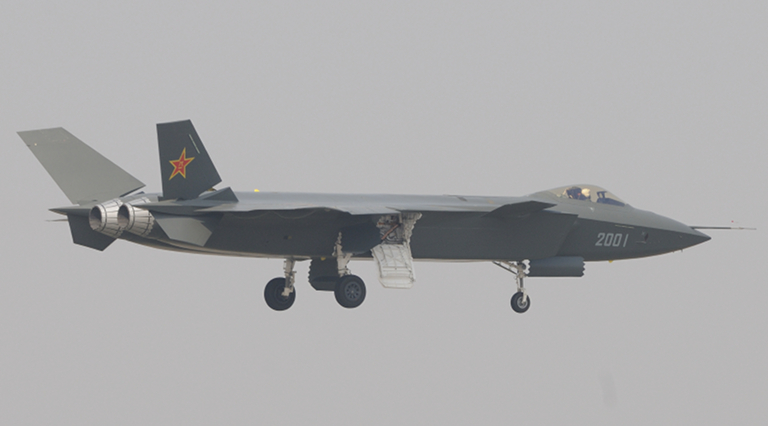
Rear quarter view of J-20 prototype showing the axi-symmetric nozzles and strakes (Chinese Internet).
|
Chinese Absorbent Materials Technology
The state of Chinese research in low observables absorbent materials technology is not well understood in Western nations, as there have been no substantial official disclosures to date. The absence of disclosures, physical samples, or even viable imagery presents numerous challenges in determining what materials are intended for use in the J-20 design, or even what options are available to the Chengdu designers.
While official disclosures on production technologies are absent, these is a surprising number of recent unclassified basic research publications available, produced by Chinese researchers, dealing with the materials science of absorbers, especially Carbon Nano-Tube (CNT) absorbers, including absorbers loaded with conductive or magnetic materials. The number of papers and abstracts identified in this and related areas was of the order of thirty, mostly authored over the last several years, and published in English language journals and conferences. No attempt was made to survey Mandarin language publications.
Chinese research in RCS reduction is not confined to materials alone. A recent paper by Zhenghong and Mingliong details a derived Method of Moments algorithm for RCS computations6. Work by Jiang et al details the use of genetic algorithms for the optimal design of complex multilayer absorber structures7. Earlier research in conventional RCS modelling for design was produced by Cao et al8.
Most of the materials research papers and abstracts surveyed were experimental, involving the fabrication and subsequent performance parameter testing of the fabricated material. The deeper theoretical analysis of loss mechanisms, and theoretical study of material behaviour in production applications, are uncommon in openly published work from China. This in many respects emulates the pattern observed in many Soviet unclassified basic research publications during the Cold War period.
Annex B outlines the basic theoretical and practical concepts underpinning the design of absorbent materials.
Of specific interest in the context of Chinese stealth design is the respectable volume of high quality academic research performed on CNT, ferrite loaded epoxy, or other materials for use as the absorbent or lossy component in epoxy or other polymer matrix absorbent or lossy coatings, laminates, panels or radar absorbent structures9 - 30.
In CNT/epoxy materials a powder filler comprising CNT is loaded into an epoxy matrix, in a manner similar to traditional inclusion methods for powdered materials intended to alter the dielectric and magnetic properties of the resin. Epoxy resins in the microwave bands exhibit εr~ 3.0 - 4.6 and δ ~ 0.01, making them a viable matrix for many applications, due to the toughness and durability of the material, and its relative ease of application.
Chinese research in CNT/epoxy absorbers seems to be mostly focussed on lossy dielectrics, rather than magnetically loaded materials intended as impedance matched coatings. Such materials are more useful as components in multilayered absorbent coatings or structures, rather than for applications such as control of specular skin reflections in aircraft, where exactly controlled impedance matching of the single layer coating strongly influences the performance of the coating.
There is no evidence in the open literature of a coordinated or focussed effort to develop thin lightweight impedance matched absorbent coatings for specular backscatter control in aircraft applications.
No effort was made to assess the performance of the surveyed materials as surface travelling wave absorbers. While numerical modelling of surface travelling wave absorption performance was feasible, without experimental data, calibration of any such simulation model was not possible40.
As a result, most of the English language published Chinese materials research would yield products possibly suitable for other applications, but mostly not suitable for high performance coatings useful in aircraft microwave band specular RCS reduction.
|
Radar Cross Section Simulation Method / Simulator Design and Capabilities
The Physical Optics (PO) method is used to predict the RCS of complex targets, in this instance the Chengdu J-20 prototype. The three dimensional model for any such target comprises a collection of triangular facets, with shared edges.
The scattered field from each and every visible facet, for a given angle pair {θ, Φ} in elevation and azimuth, is computed using the far field radiation integrals. It is assumed that the wavefront is planar and no parallax errors arise. The contributions from each of the facets are then summed to produce a total RCS for the angle pair {θ, Φ} in question. This method is a high frequency approximation that provides the best results for electrically large targets, and performs well in the specular direction.
The simulation uses geometric self-shadowing of facet calculations, such that RCS contributions hidden by shadowing airframe features are removed. This mechanism does not implement diffraction effects at larger wavelengths.
The PO RCS simulation program implementation has manageable run–times because it requires minimum computer resources. It is implemented in C++ language to provide shorter computation times than earlier Physical Optics simulators, such as the NPS POFacets code, which is implemented in the interpreted Matlab language5.
At this time the simulator does not implement surface travelling wave modelling and associated edge or gap backscatter modelling, or edge diffraction scattering effect modelling. As the backscatter from these, in real aircraft, depends upon leading and trailing edge absorbent treatments, it is a reasonable assumption that in a production design these RCS contributions would be strongly suppressed as a result of effective treatments, and thus the magnitude of these RCS contributions would be smaller than specular returns, from angles other than the peak mainlobes.
The PO RCS simulator generates a raw data output as RCS magnitude values for a specified operating frequency, polarisation, and aspect angle pair {θ, Φ}, in ASCII text format.
The integrity of the PO RCS simulation program was validated by modelling a range of basic shapes and materials coated panels, and comparing against published experimental third party results. The simulator generally displayed very low errors compared to published measurements, typically of the order of the error produced by digitising printed hard copy plots of experimental measurement results.
Postprocessing tools were developed and employed to generate two different representations of the RCS data.
The first representation devised was labelled as the PolyChromatic Spherical Representation (PCSR), in which a translucent sphere is rendered around a two-dimensional rendering of the aircraft, where the surface of the sphere is divided into tiles by aspect angle pair {θ, Φ}. The colour of each tile represents the RCS from the angular direction determined by the path between the tile and the centroid of the aircraft. The colour encoding of RCS employs the same ordered colour sequence as is employed by US Government and other agencies for weather radar rainfall density representation, as this is a well understood and intuitive encoding scheme.
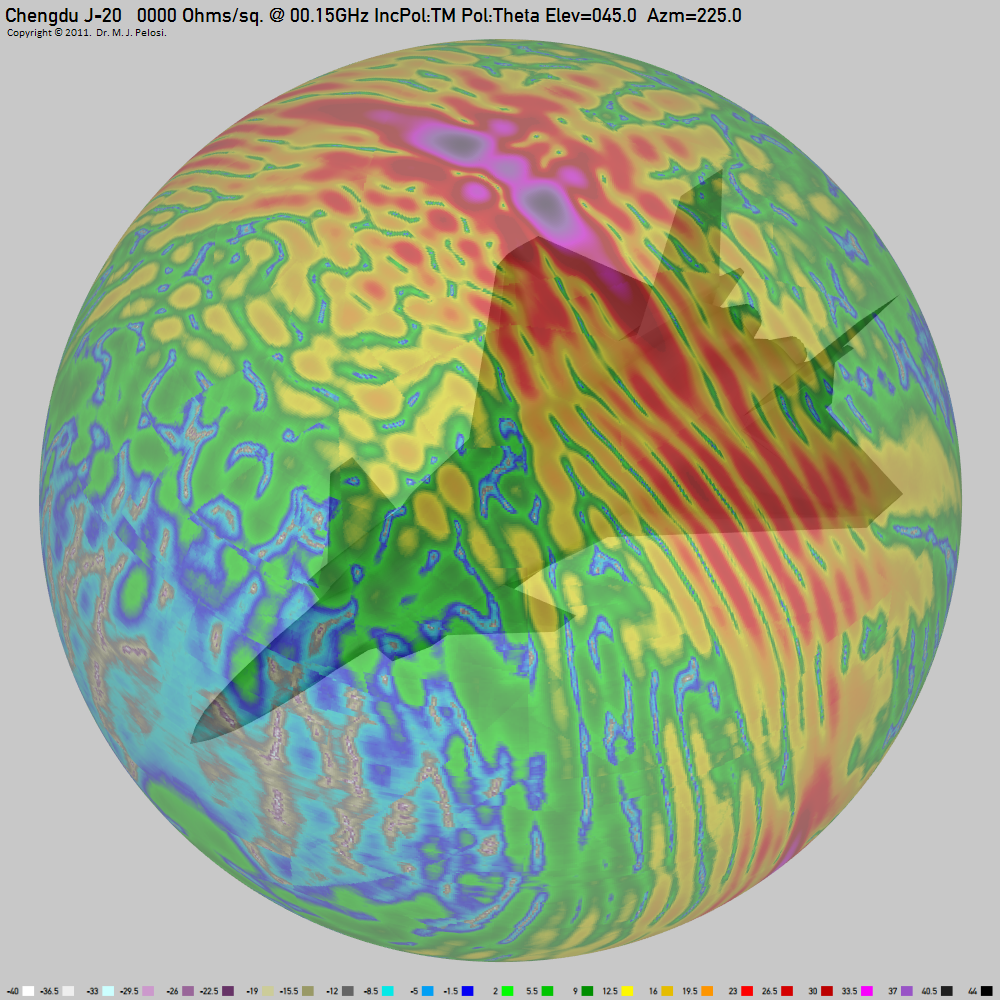
Example PolyChromatic Spherical Representation (PCSR) of J-20 specular RCS at 150 MHz. The dBSM value is represented by the colour scale at the bottom of the plot [Click to enlarge].
The second representation devised was labelled as the PolyChromatic Planar Representation(PCPR), in which a rectangular area is divided into tiles by aspect angle pair {θ, Φ}. The colour of each tile represents the RCS from the angular direction determined by the path between the tile and the centroid of the aircraft. The colour encoding of RCS employs the same ordered colour sequence as is employed in the PCSR scheme. All PCPR charts are further enhanced by the addition of rulers which separate the most critical azimuthal sectors, and elevation/depression angles.
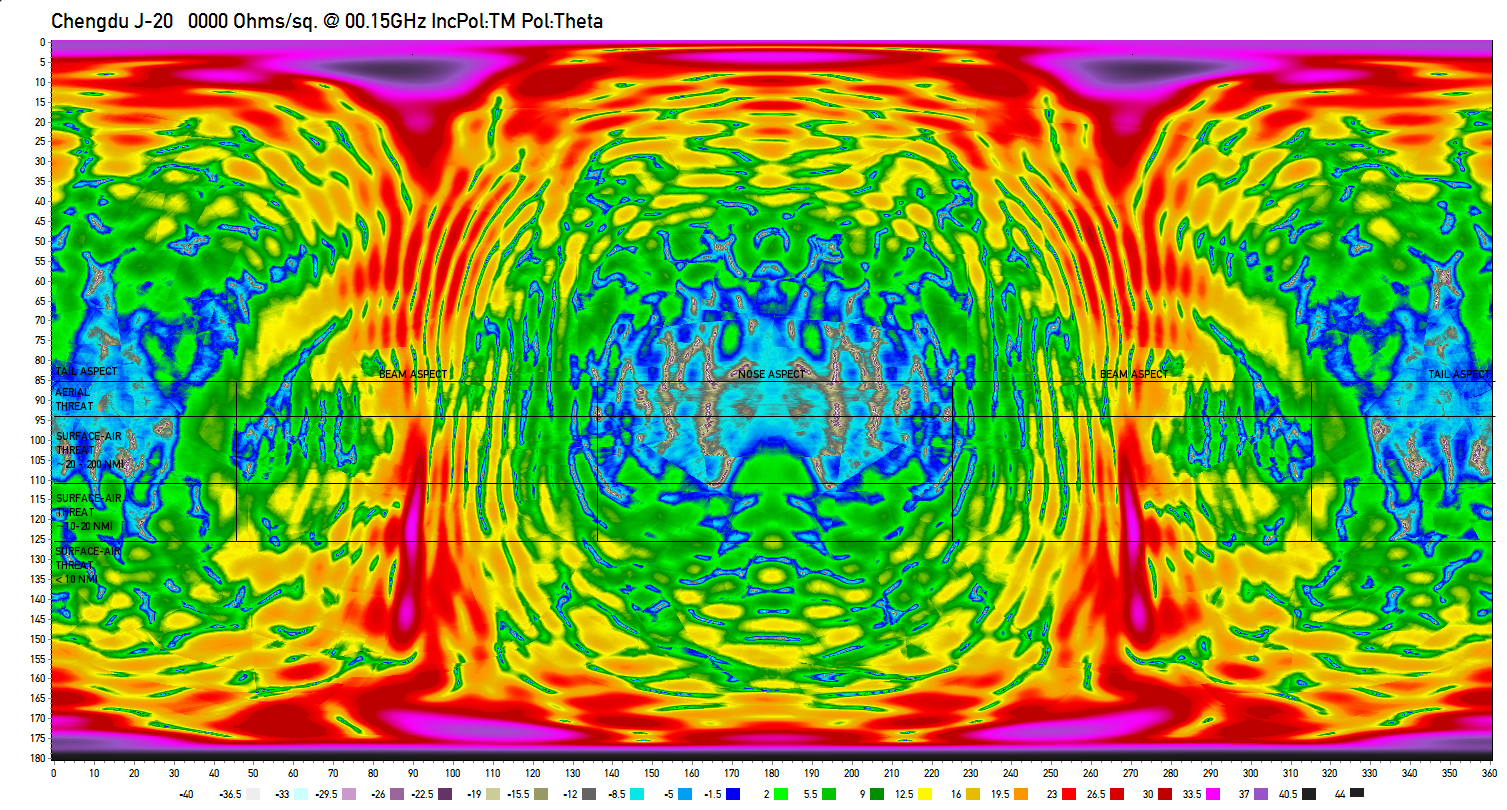
Example PolyChromatic Planar Representation (PCSR) of J-20 specular RCS at 150 MHz. The dBSM value is represented by the colour scale at the bottom of the plot. The rulers outline angular sectors of specific importance, from a survivability perspective [Click to enlarge].
Aircraft Model Features and Limitations
The model used was an extant public domain 3,343 facet representation constructed from publicly available high and medium resolution photographic imagery of the J-20 prototype, observed in December, 2010, and January, 2011.
Two variants of the model were tested and one then employed. One model used axisymmetric exhaust nozzles fully open, and the other used axisymmetric exhaust nozzles fully closed. This was necessary to capture the specular returns from the nozzle exterior in the aft hemisphere of the aircraft, which vary strongly with nozzle position. As the nozzles open, the principal lobes of the specular returns rotate forward, and in the fully open position contribute mostly to the beam aspect RCS, where not shielded by the aft fuselage structure. Nozzle RCS from the forward and aft aspects varies weakly with nozzle position. Therefore all simulations presented are for a closed nozzle, which is the most frequent case in operational use of such aircraft, and thus of most interest. The nozzle rim includes serrations as observed on the prototype. The intent behind the use of serrations could be rim RCS reduction in the upper bands, but could also be to promote vortex generation and plume mixing to increase plume dissipation and thus reduce blackbody radiation from the plume in the near infrared bands.
The primary nose mounted radar antenna radome is assumed to be a bandpass design, emulating United States fighter designs, and was assumed to be fully opaque at all frequencies of interest. The model assumes an insignificant structural mode RCS contribution from the radar antenna face and radar bay bulkhead, consistent with a properly designed bandpass radome in its stopband region. Given the absence of any useful data on the internal configuration of the radome and antenna bay, a more elaborate model would be speculative, unavoidably. Imagery of the prototypes does not show any evidence of the radome join to the fuselage, possibly reflecting the absence of a radome on airframes built to validate aerodynamics, shaping and flight systems. In a production design the radome seam / join to the fuselage can produce significant RCS contributions if poorly implemented.
The engine inlet tunnels were modelled as Perfect Electrical Absorbers (PEA; Refer Annex E). Given the absence of any useful data on the internal configuration of the inlets and tunnels, a more elaborate model would again be entirely speculative. This is consistent with an ideal S-bend inlet tunnel clad with ideal RAM on its interior walls, and the use of an ideal engine face blocker. This is an optimistic assumption given historically observed difficulties in inlet tunnel signature reduction, as in many designs the inlet tunnel cavity RCS is a dominant wideband contributor in the forward aspect.
The exhaust tailpipe RCS contributions were also modelled as Perfect Electrical Absorbers (PEA). Given the absence of any useful data on the internal configuration of the tailpipes, a more elaborate model would be as before entirely speculative. The PEA model is consistent with an ideal tailpipe internally clad with ideal heat resistant RAM, and the use of an ideal turbine face and afterburner fuel spraybar blocker. This is an inherently optimistic assumption, as can be shown by employing an approximate model for an untreated tailpipe cavity, accounting for the reduction in projected nozzle area. This is detailed in Annex C.
The cockpit canopy transparency was modelled as a Perfect Electrical Conductor (PEC; Refer Annex E), to emulate the effect of a gold or other highly conductive plating layer in the polycarbonate laminate structure.
The closed axisymmetric exhaust nozzle employs a stacked serrated trailing edge in the manner of the F-35 nozzle, reflecting photographic imagery of the prototype. As the structural shape of the gaps between nozzle petals is not known at this time, we modelled the open nozzle as simple cylinder.
The photographic imagery of the J-20 prototypes was not of sufficient quality to incorporate any useful detail of panel join boundaries, door boundaries, and other surface features which produce RCS contributions due to surface travelling waves coupled to the aircraft skin. Even were such detail available, there is no guarantee production aircraft would retain the prototype configuration, reducing the value of any such results.
The position of the canards, delta wing leading and trailing edge surfaces, and fully moving tail surfaces was set to neutral, reflecting an optimal cruise configuration at nominal supercruise altitudes and airspeeds. Large deflections by these control surfaces in flight would produce large but transient increases in specular backscatter.
The geometrical fidelity of the model was assessed by comparison with high resolution imagery released in January, 2011, specifically by comparing the shape of the model from the same aspect as the photograph. Particular attention was paid to the fidelity of angles, especially in the chines, engine inlet exterior, planform and wing/fuselage joins, as these determine the {θ, Φ} directions of the mainlobes and sidelobes in the specular returns.
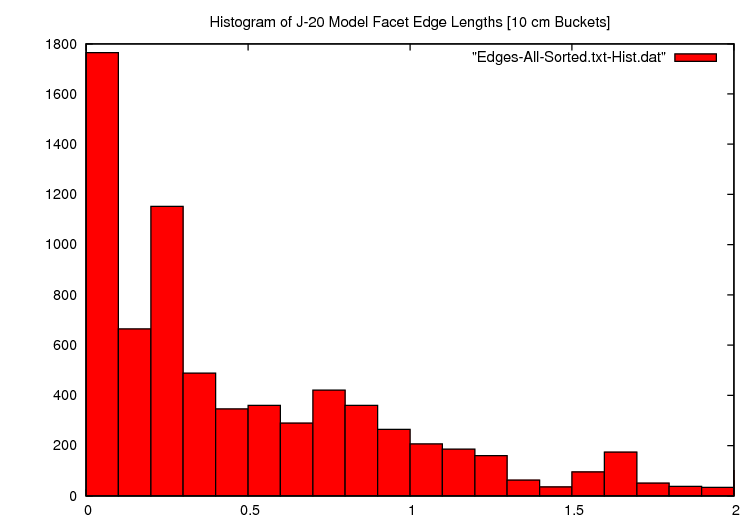
To establish the robustness of the 3D model for physical optics modelling, we explored the statistical distribution of edge lengths [x-axis] in the facet population [y-axis]. A substantial fraction of the facets are sufficiently large to yield good accuracy through most of the frequency bands being modelled for.
What the Simulation Does Not Demonstrate
The simulator at this time does not model backscatter from edge diffraction effects, although the resulting error will be mitigated by the reality that in a mature production design these RCS contributions are reduced by edge treatments; The simulator at this time does not model backscatter from surface travelling wave effects. In the forward and aft hemispheres these can be dominant scattering sources where specular contributions are low. The magnitude of these RCS contributions is reduced by edge treatments, lossy surface coatings, gap treatments, and panel serrations; The simulator at this time does not model backscatter from the AESA bay in the passband of a bandpass radome, due to the absence of any data on the intended design of same, the resulting error will be mitigated by the reality that in a mature production design much effort will be expended in suppressing passband RCS contributions; The simulator at this time does not model backscatter from the engine inlet tunnels or engine exhaust tailpipes, due to the absence of any data on the intended design of same. In the forward and aft hemispheres these can be dominant scattering sources where specular contributions are low. The magnitude of these RCS contributions is reduced by suppressing these RCS contributions with absorbers, and in the case of inlet tunnels, by introducing a serpentine geometry to increase the number of bounces; The simulator at this time does not model structural mode RCS contributions from antenna and EO apertures, panel joins, panel and door gaps, fasteners and other minor contributors; although the resulting error will be mitigated by the reality that in a mature production design these RCS contributions are reduced by RCS reduction treatments. The PO computational algorithm performs most accurately at broadside or near normal angles of incidence, with decreasing accuracy at increasingly shallow angles of incidence, reflecting the limitions of PO modelling. The simulator does not implement the Mitzner/Ufimtsev corrections for edge currents. While a number of test runs with basic shapes showed good agreement between the PO simulation and backscatter peaks in third party test sample measurements, even at incidence angles below 10°, characteristically PO will underestimate backscatter in nulls. This limitation must be considered when assessing results for the nose and tail aspects, where most specular RCS contributions arise at very shallow angles39. The PO computational algorithm performs best where the product of wave number and dimension ka ≥ 5, where k ≈ 2πf [Table 5.1 in (1)], yielding errors much less than 1 dB. Knott cites good agreement for cylinders as small as 1.5 wavelengths in diameter1. The simulator does not account for a number of environmental factors, such as air density profile at the aircraft skin boundary layer, thermal variations in absorbent material properties, and moisture precipitation. RCS contributions from these sources are negligible for the principal lobe magnitudes studied.
In practical terms, the combination of the J-20 aircraft geometry and the use of the PO method without the Mitzner/Ufimtsev edge current corrections will yield errors at the frequencies of interest of less than 1 dB for the beam aspect and tail aspect sectors, which both have dominant specular scatterers. The nose aspect angular sector results will underestimate RCS, in part due to the absence of shallow angle specular contributions not modelled by the Mitzner/Ufimtsev edge current corrections, and by the absence of surface travelling wave backscatter contributions from surface features, gaps and trailing edges.
In all instances, the errors arising from the limitations of the PO computation method all fall into areas where well established RCS reduction treatments using RAS, RAM or coatings would be used, thus reducing the relative magnitude of the errors in the resulting RCS result for angles other than the peak mainlobes produced by these backscatter sources.
Importantly, even were the simulator capable of modelling shallow angle specular and non-specular RCS contributors, the PLA would not permit sufficiently detailed disclosures on the RCS reduction treatments applied to the airframe design, as a result of which reasonable assumed parameters would have to be applied instead of actual values.
The latter underscores the difficulty in attempting to perform highly accurate numerical RCS modelling of foreign airframe designs, where access to high fidelity shaping data, surface feature data, and materials type and application is actively denied.
What the Simulation Does Demonstrate
The simulation can accurately capture the direction of mainlobes and sidelobes produced by specular backscatter returns, especially where major specular reflectors produce strong contributions; this includes broadside and lesser specular returns from the wings, control surfaces and major reflecting areas of the fuselage, inlet exteriors and nozzles; For an untreated PEC skin, the simulation can accurately capture the absolute and relative magnitudes of mainlobes and sidelobes produced by specular backscatter returns, especially where major specular reflectors produce strong contributions; this includes broadside and lesser specular returns from the wings, control surfaces and major reflecting areas of the fuselage, inlet exteriors and nozzles; In capturing mainlobes and sidelobes of major specular scatterers it permits an assessment of the angular extent in the nose and tail sectors where diffraction and surface travelling wave backscatter is dominant, and can still be suppressed effectively;
Where a RAM surface treatment is applied in the model, it will present inferior RCS reduction performance to an actual treatment; so results produced will present a worst case performance result, to an order of magnitude.
In summary, if the results of the Physical Optics specular return modelling yield RCS values from key aspects, at key frequencies, which are consistent with stated VLO performance values in US designs, to an order of magnitude, it is reasonable to conclude that a mature J-20 design will qualify as a genuine VLO design.
|
Specular Radar Cross Section Simulation Results
Specular RCS was modelled for full spherical all-aspect coverage, for nine frequencies of interest. Frequencies were carefully chosen to match likely threat systems the J-20 would be intended to defeat in an operational environment. There are:
150 MHz to defeat Russian built VHF band Counter-VLO radars such as the Nebo UE, Nebo SVU and Nebo M series, or the Rezonans N/NE series;
600 MHz to defeat UHF band radars such as those carried by the E-2C/D AEW&C system, or the widely used Russian Kasta 2/2E and P-15/19 Flat Face / Squat Eye series;
1.2 GHz to defeat L-band surface based search, acquisition and GCI radars, and the Northrop-Grumman MESA AEW&C radar;
3.0 GHz to defeat widely used S-band acquisition radars, and the E-3 APY-1/APY-2 AWACS system;
6.0 GHz to defeat C-band Surface-Air-Missile engagement radars such as the MPQ-53/65 Patriot system;
8.0 GHz to defeat a range of X-band airborne fighter radars, Surface-Air-Missile engagement radars such as the 30N6E Flap Lid / Tomb Stone, and 92N6E Grave Stone, and a range of Western and Russian Surface-Air-Missile seekers;
12.0 GHz to defeat a range of X-band airborne fighter radars, Surface-Air-Missile engagement radars, and Surface-Air-Missile and Air-Air-Missile seekers;
16.0 GHz to defeat a range of Ku-band airborne fighter radars, and Surface-Air-Missile engagement radars, and Surface-Air-Missile and Air-Air-Missile seekers;
28.0 GHz to defeat a range of K-band missile seekers, and Surface-Air-Missile engagement radars;
RCS simulation results are presented in PCSR and PCPR formats. The latter includes rulers to show the most important elevation/depression angle rings/zones, and the four azimuthal quadrants.
Analysis of Shape Related Specular Radar Cross Section
The results of the physical optics simulation modelling of specular RCS for the J-20 shape, using an idealised PEC skin for all external surfaces, are displayed in Tables 1 and 2, for a vertically polarised E component. An additional simulation was performed at 150 MHz, or a horizontally polarised E component, with results in Tables 1A and 2A.
Results have been plotted in PCSR format for nine different aspects, and nine different frequencies. PCPR format plots have been produced for nine different frequencies.
Table 1. J-20 Specular RCS Model Results PEC [V-Pol]
[Click Thumbnail to Enlarge]
| Frequency
| 150
MHz
| 600
MHz
| 1.2
GHz
| 3.0
GHz
| 6.0
GHz
| 8.0
GHz
| 12.0
GHZ
| 16.0
GHz
| 28.0
GHz
| | θ | Φ | PEC Skin [Baseline]
| | 0 | 0 |  |  |  |  |  |  |  |  |  | | 180 | 180 |  |  |  |  |  |  |  |  |  | | 090 | 180 |  |  |  |  |  |  |  |  |  | | 090 | 0 |  |  |  |  |  |  |  |  |  | | 090 | 270 |  |  |  |  |  |  |  |  |  | | 045 | 225 |  |  |  |  |  |  |  |  |  | | 135 | 225 |  |  |  |  |  |  |  |  |  | | 045 | 315 |  |  |  |  |  |  |  |  |  | | 135 | 315 |  |  |  |  |  |  |  |  |  |
dBSM Scale
|  |
Notation: The POFACETS simulator labels V-pol as “TM-z”, i.e. the magnetic H vector is transverse to the z-axis or vertical. This convention was retained for consistency in these simulation plots, with plots labelled TM being V-pol and plots labelled TE being H-pol5.
|
Table 2. J-20 Specular RCS Model Results PEC [V-Pol]
[Click Chart to Enlarge]
| | 150 MHz | 
| | 600 MHz | 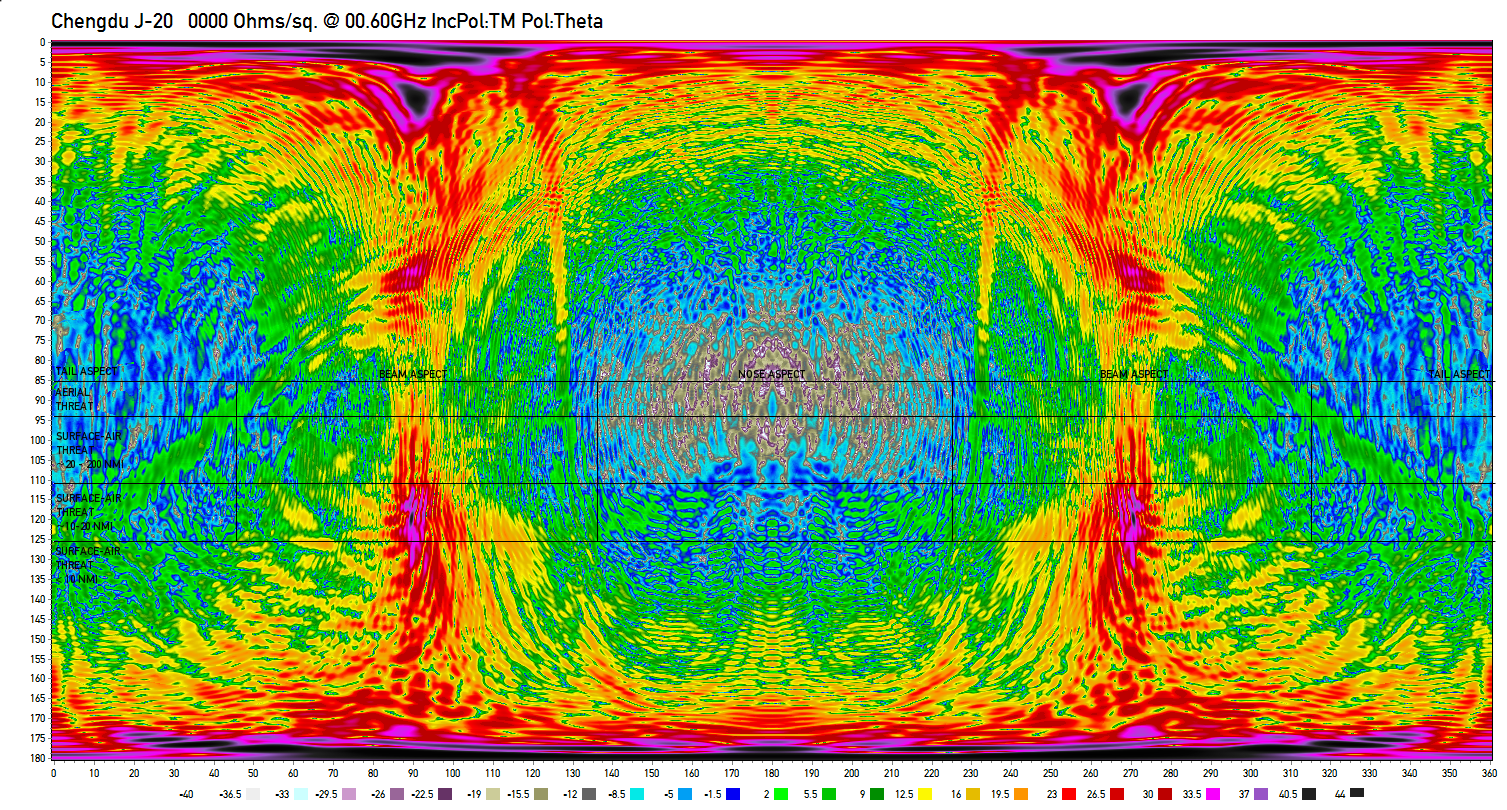
| | 1.2 GHz | 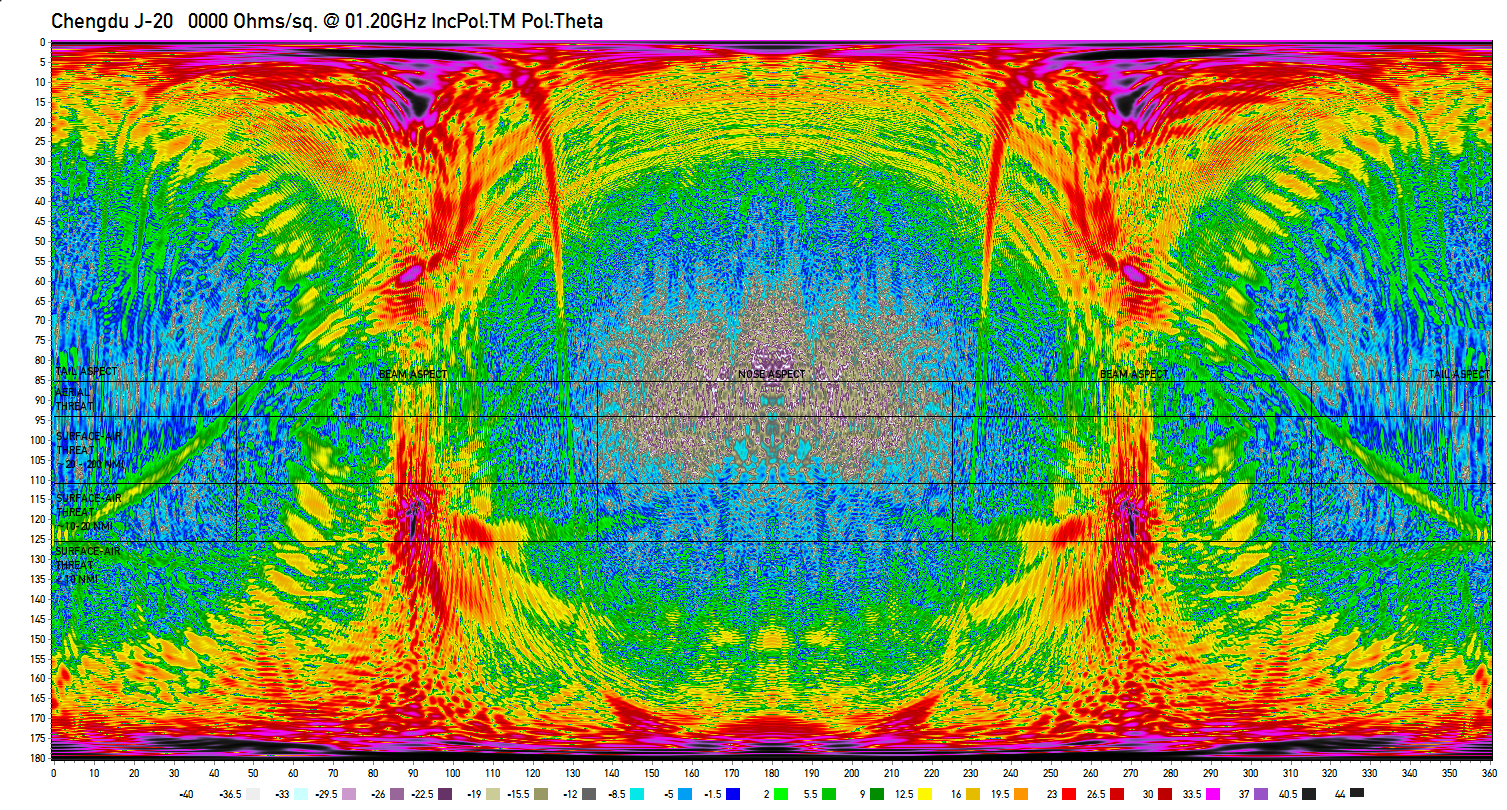
| | 3.0 GHz | 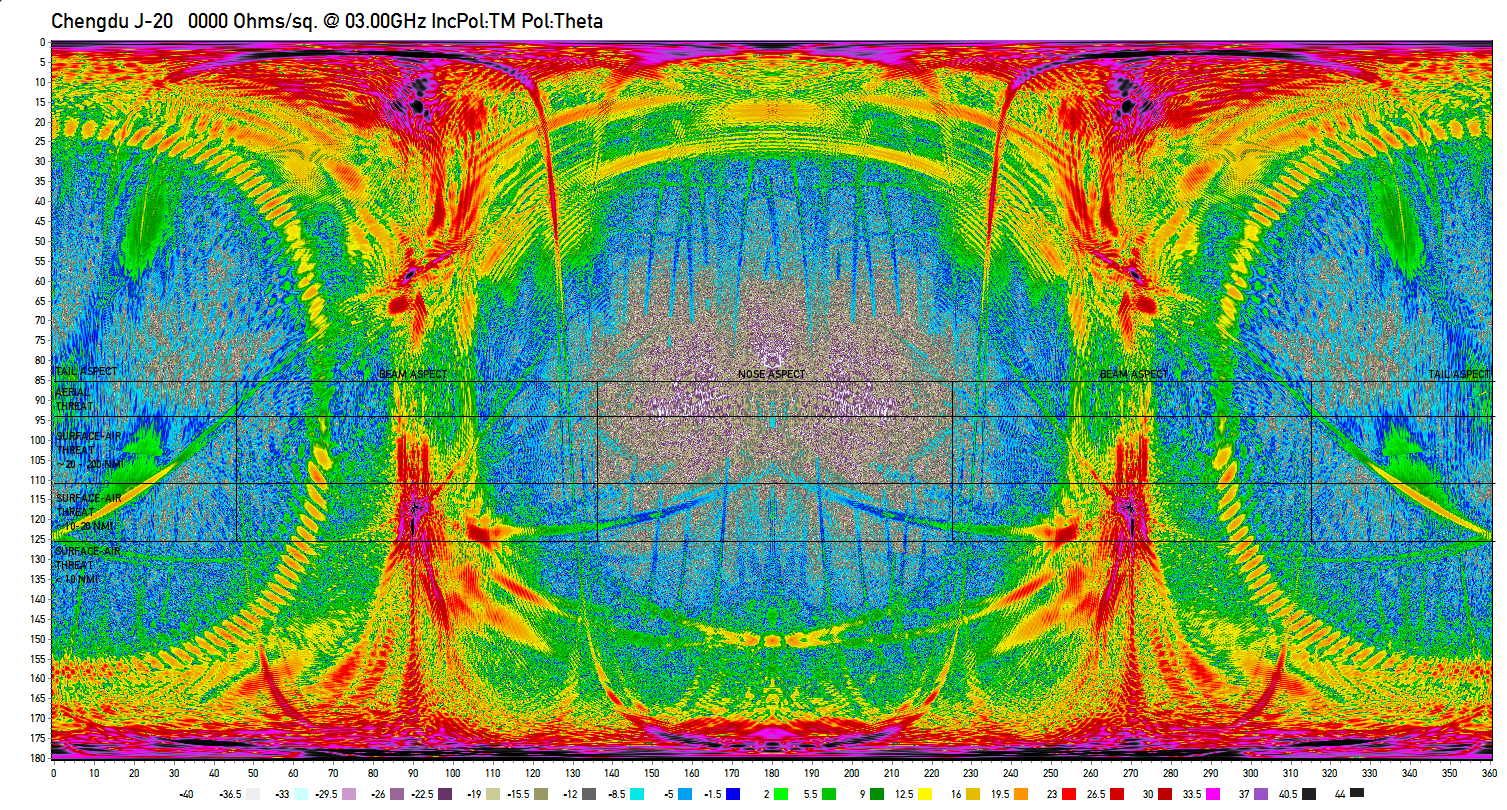
| | 6.0 GHz | 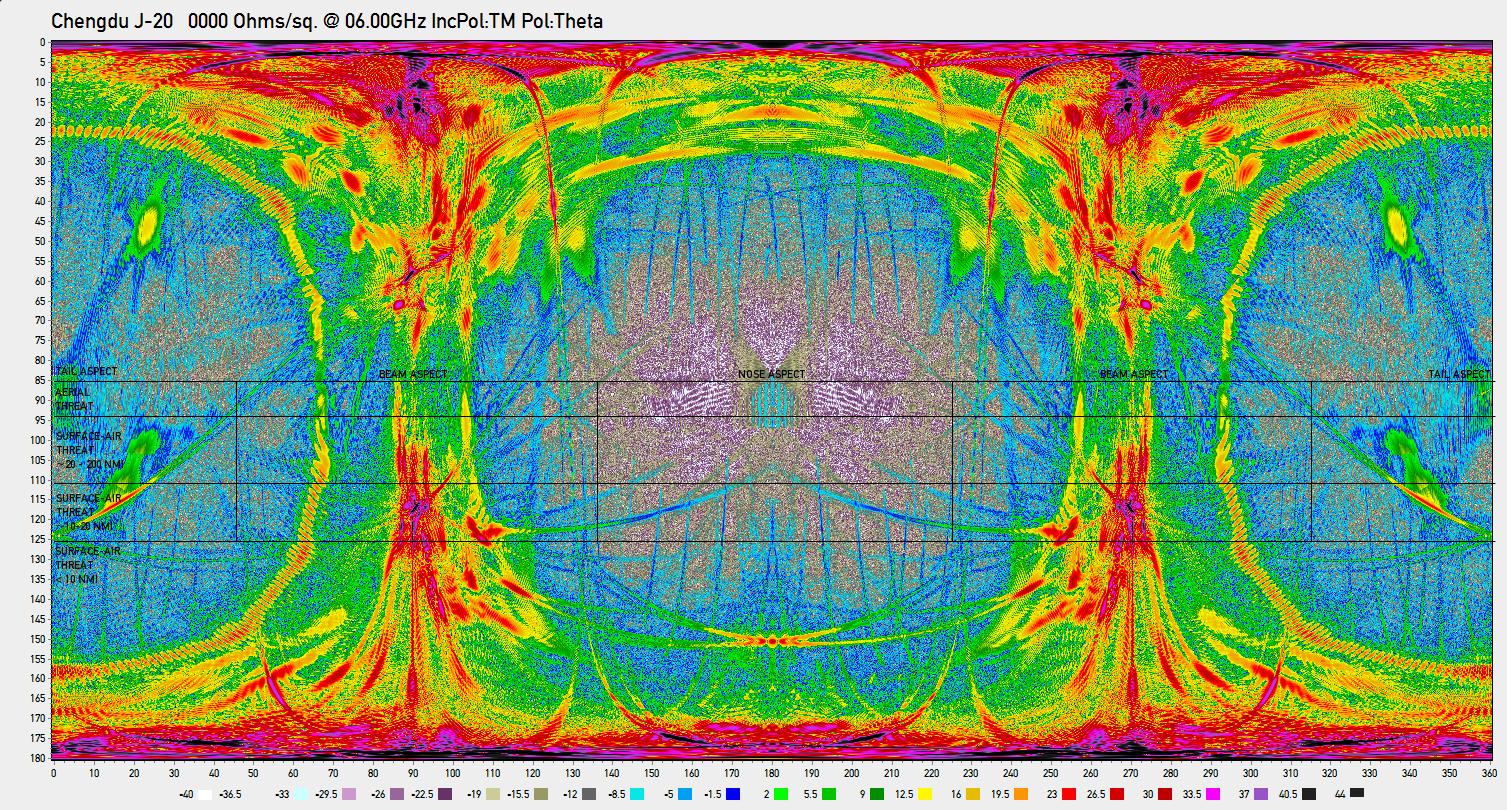
| | 8.0 GHz | 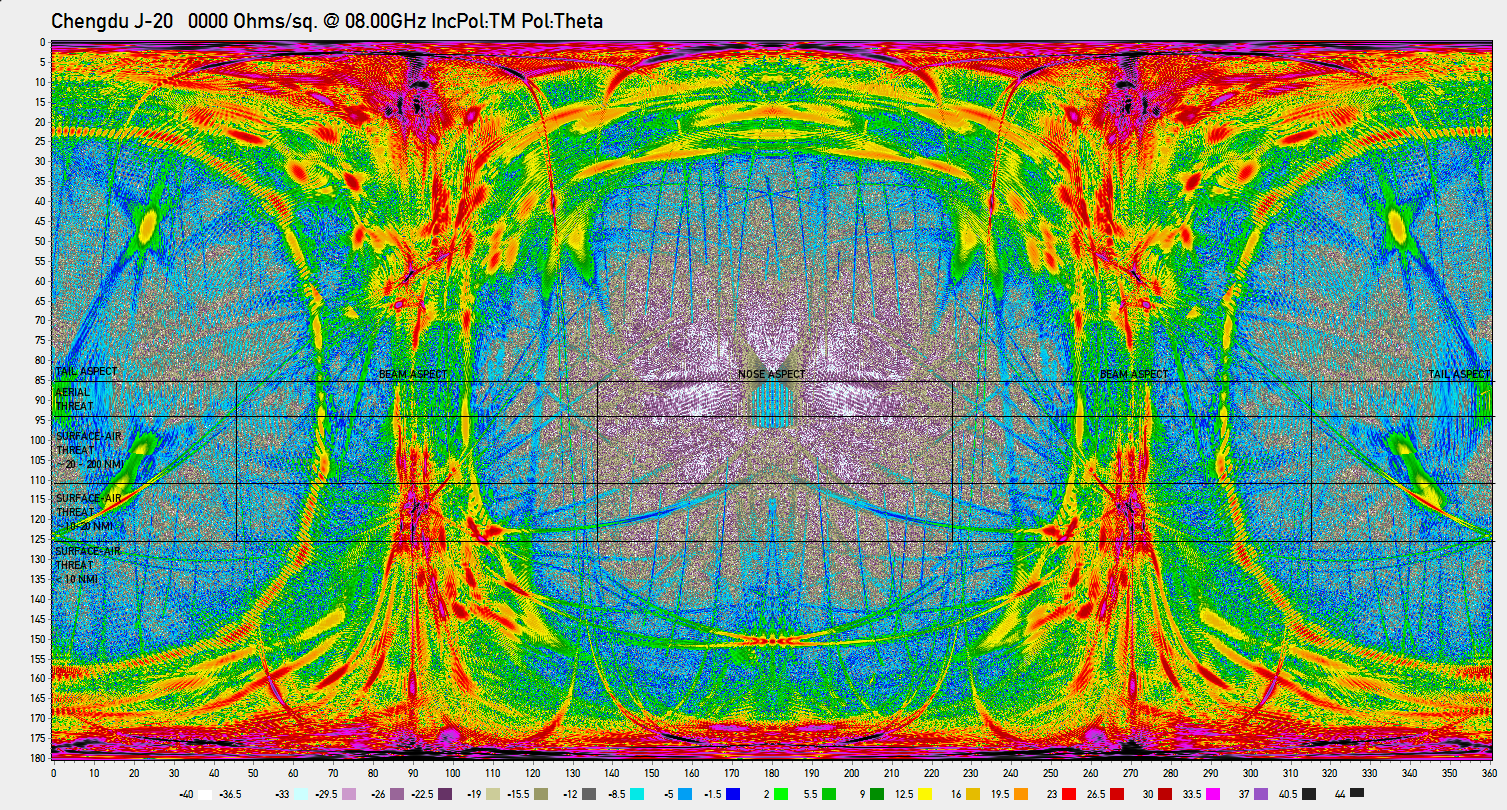
| | 12.0 GHZ | 
| | 16.0 GHz | 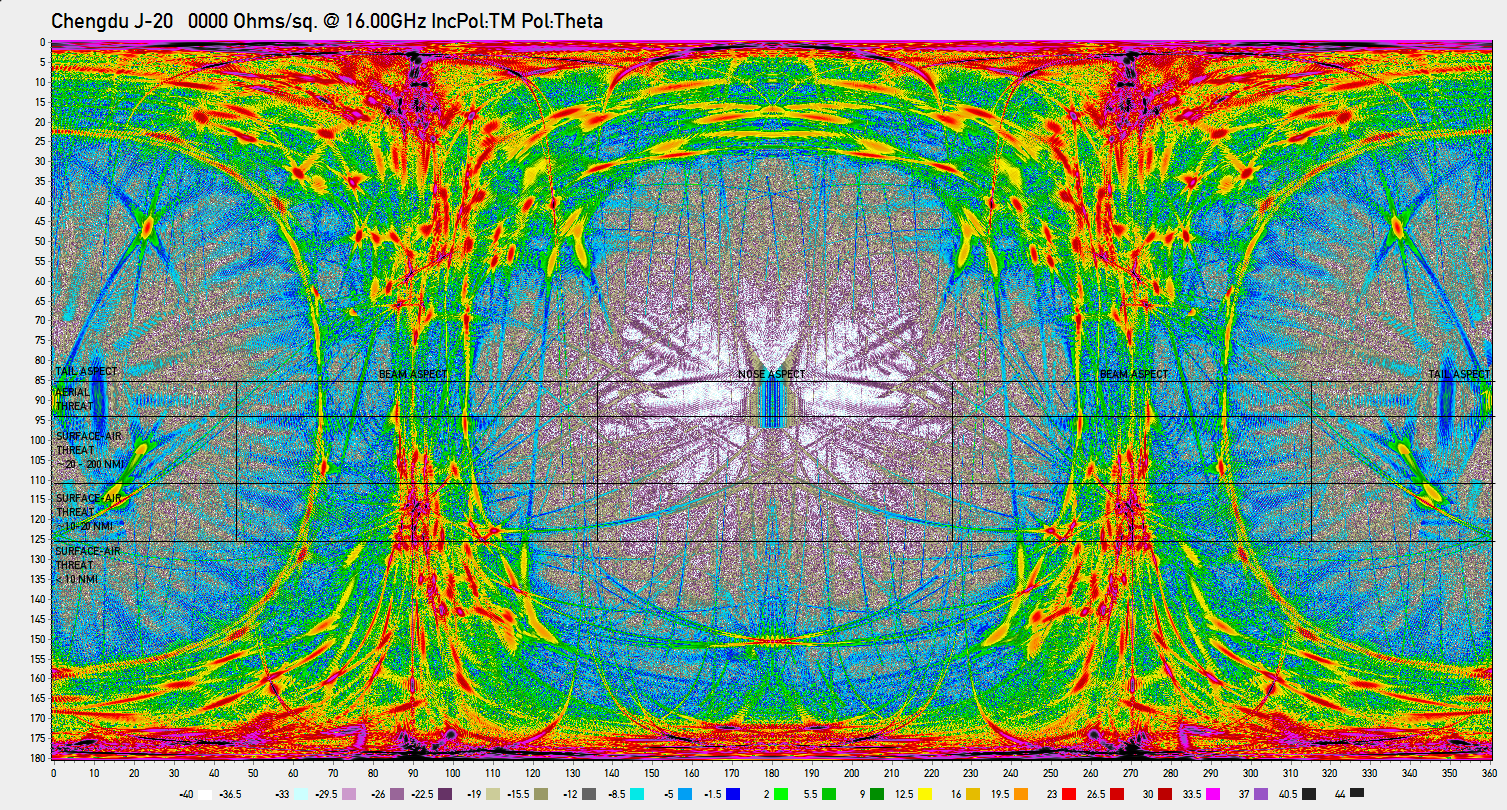
| | 28.0 GHz | 
|
| | Table 2 Legend: |
|
| | NOSE ASPECT | Azimuthal Sector | 90° centred on aircraft nose | | TAIL ASPECT | Azimuthal Sector | 90° centred on aircraft tail | | BEAM ASPECT | Azimuthal Sector | 90° centred on aircraft side | AERIAL THREAT
| Depression Angle Ring | -5° - 3.7° aircraft at similar altitudes
| SURFACE-AIR THREAT ~20 - 200 NMI
| Depression Angle Ring | ~3.7° - 20° SAM at 200 down to 20 NMI
| | SURFACE-AIR THREAT ~10 - 20 NMI | Depression Angle Ring | ~20° - 36° SAM at 20 down to 10 NMI | | SURFACE-AIR THREAT <10 NMI | Depression Angle Ring
| ~36° SAM inside 10 NMI | Assumptions:
A.Distant threats CRPL exponential refractive atmospheric model;
B.Near threats SBF refractive atmospheric model;
C.Spherical earth model;
D.Assumed aircraft altitude 36 kft;
E.For higher aircraft altitudes the depression angles increase for nearer threats.
|
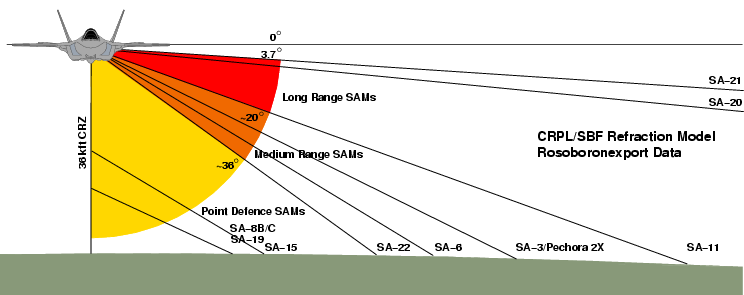
Threat depression angles as a function of type and missile kinematic range, for various contemporary and legacy SAM systems of Russian/Soviet manufacture (C. Kopp).
|
Table 1A. J-20 150 MHz Specular RCS Model Results PEC [H-Pol]
[Click Thumbnail to Enlarge]
| θ/Φ
| 0/0
| 180/180
| 090/180
| 090/000
| 090/270
| 045/225
| 135/225
| 045/315
| 135/315
|
| ![Chengdu_J-20_[PEC].mdb-00.15GHz-Rs0000-IncPol-TE-Pol-Phi-[E=000.0_A=000.0] Chengdu_J-20_[PEC].mdb-00.15GHz-Rs0000-IncPol-TE-Pol-Phi-[E=000.0_A=000.0]](http://www.ausairpower.net/PLA-VLO/.thumb_Chengdu_J-20_%5BPEC%5D.mdb-00.15GHz-Rs0000-IncPol-TE-Pol-Phi-%5BE=000.0_A=000.0%5D.png) | ![Chengdu_J-20_[PEC].mdb-00.15GHz-Rs0000-IncPol-TE-Pol-Phi-[E=180.0_A=180.0] Chengdu_J-20_[PEC].mdb-00.15GHz-Rs0000-IncPol-TE-Pol-Phi-[E=180.0_A=180.0]](http://www.ausairpower.net/PLA-VLO/.thumb_Chengdu_J-20_%5BPEC%5D.mdb-00.15GHz-Rs0000-IncPol-TE-Pol-Phi-%5BE=180.0_A=180.0%5D.png) | ![Chengdu_J-20_[PEC].mdb-00.15GHz-Rs0000-IncPol-TE-Pol-Phi-[E=090.0_A=180.0] Chengdu_J-20_[PEC].mdb-00.15GHz-Rs0000-IncPol-TE-Pol-Phi-[E=090.0_A=180.0]](http://www.ausairpower.net/PLA-VLO/.thumb_Chengdu_J-20_%5BPEC%5D.mdb-00.15GHz-Rs0000-IncPol-TE-Pol-Phi-%5BE=090.0_A=180.0%5D.png) | ![Chengdu_J-20_[PEC].mdb-00.15GHz-Rs0000-IncPol-TE-Pol-Phi-[E=090.0_A=000.0] Chengdu_J-20_[PEC].mdb-00.15GHz-Rs0000-IncPol-TE-Pol-Phi-[E=090.0_A=000.0]](http://www.ausairpower.net/PLA-VLO/.thumb_Chengdu_J-20_%5BPEC%5D.mdb-00.15GHz-Rs0000-IncPol-TE-Pol-Phi-%5BE=090.0_A=000.0%5D.png) | ![Chengdu_J-20_[PEC].mdb-00.15GHz-Rs0000-IncPol-TE-Pol-Phi-[E=090.0_A=270.0] Chengdu_J-20_[PEC].mdb-00.15GHz-Rs0000-IncPol-TE-Pol-Phi-[E=090.0_A=270.0]](http://www.ausairpower.net/PLA-VLO/.thumb_Chengdu_J-20_%5BPEC%5D.mdb-00.15GHz-Rs0000-IncPol-TE-Pol-Phi-%5BE=090.0_A=270.0%5D.png) | ![Chengdu_J-20_[PEC].mdb-00.15GHz-Rs0000-IncPol-TE-Pol-Phi-[E=045.0_A=225.0] Chengdu_J-20_[PEC].mdb-00.15GHz-Rs0000-IncPol-TE-Pol-Phi-[E=045.0_A=225.0]](http://www.ausairpower.net/PLA-VLO/.thumb_Chengdu_J-20_%5BPEC%5D.mdb-00.15GHz-Rs0000-IncPol-TE-Pol-Phi-%5BE=045.0_A=225.0%5D.png) | ![Chengdu_J-20_[PEC].mdb-00.15GHz-Rs0000-IncPol-TE-Pol-Phi-[E=135.0_A=225.0] Chengdu_J-20_[PEC].mdb-00.15GHz-Rs0000-IncPol-TE-Pol-Phi-[E=135.0_A=225.0]](http://www.ausairpower.net/PLA-VLO/.thumb_Chengdu_J-20_%5BPEC%5D.mdb-00.15GHz-Rs0000-IncPol-TE-Pol-Phi-%5BE=135.0_A=225.0%5D.png) | ![Chengdu_J-20_[PEC].mdb-00.15GHz-Rs0000-IncPol-TE-Pol-Phi-[E=045.0_A=315.0] Chengdu_J-20_[PEC].mdb-00.15GHz-Rs0000-IncPol-TE-Pol-Phi-[E=045.0_A=315.0]](http://www.ausairpower.net/PLA-VLO/.thumb_Chengdu_J-20_%5BPEC%5D.mdb-00.15GHz-Rs0000-IncPol-TE-Pol-Phi-%5BE=045.0_A=315.0%5D.png) | ![Chengdu_J-20_[PEC].mdb-00.15GHz-Rs0000-IncPol-TE-Pol-Phi-[E=135.0_A=315.0] Chengdu_J-20_[PEC].mdb-00.15GHz-Rs0000-IncPol-TE-Pol-Phi-[E=135.0_A=315.0]](http://www.ausairpower.net/PLA-VLO/.thumb_Chengdu_J-20_%5BPEC%5D.mdb-00.15GHz-Rs0000-IncPol-TE-Pol-Phi-%5BE=135.0_A=315.0%5D.png) |
Table 2A. J-20 150 MHz Specular RCS Model Results PEC [H-Pol]
[Click Chart to Enlarge]
| 
|
dBSM Scale
|  |
The starting point for any forensic analysis of the RCS of a new and hitherto unknown aircraft type is the study of the RCS of its shape, assuming a perfectly electrically conductive surface. This will permit identification of mainlobes and sidelobes, and their respective angular locations.
As the simulation technique is confined to the Physical Optics method, care must be taken in the interpretation of results, as at grazing or shallow angles of incidence the method will usually underestimate the magnitude of the RCS. In the most critical nose and tail aspect angular sectors, a good design will have no major scattering sources producing specular returns captured by the simulation, and the RCS will be dominated by nonspecular mechanisms, primarily diffraction and surface travelling waves, engine inlet and exhaust backscatter, as well as the structural mode RCS of antennas, panel join gaps, or other electrical apertures35.
Behaviour in the nose aspect angular sector, defined as ±45° in azimuth left and right of the nose, and between +5° in elevation, and -36° in depression, is generally very good across all bands simulated. No scattering sources producing significant specular RCS are observed at 3 GHz or any higher frequencies. The RCS performance will thus satisfy the Very Low Observable requirement that strong specular returns are absent. In this angular and frequency domain, the actual RCS performance of the design will be dominated by edge alignment to control diffracting edge mainlobe directions, and applied RAM and RAS. As the simulation cannot capture the behaviour of the inlet edges and tunnels, these peaks are absent.
At L-band and below, there is a pronounced increase in the calculated RCS within the nose aspect angular sector. This is a byproduct of the breakdown of the directional effect produced by smaller shaping features, which lose their ability to concentrate backscatter into narrow mainlobes. Indeed many physically smaller specular and diffractive regime optimised shaping features fall into the Raleigh scattering regime and lose effect wholly.
Behaviour in the tail aspect angular sector, defined as ±45° in azimuth left and right of the tail, and between +5° in elevation, and -36° in depression, is dominated by the scattering behaviour of the pair of axisymmetric nozzles, which has major specular, cavity and diffractive contributors, detailed in Annex C. The large diffraction backscatter from the nozzle rims below X-band is not captured in the Physical Optics simulation, the tailpipe cavity backscatter is not represented, and the distinctive lobing structure of the nozzle petals above X-band is also not visible.
There are two prominent mainlobes at ~±15° in azimuth left and right of the tail, centred at a depression angle of ~20° to ~40°, produced by the vertical tails which are not shadowed by a horizontal stabilator as would be employed in a conventional airframe design. While these produce strong specular returns, the depression angle through the centre of these mainlobes varies strongly with changing azimuth angle, and thus would present at any fixed depression angle only a narrow transient flash for a single azimuth.
Behaviour in the left and right beam aspect angular sectors, defined as ±45° in azimuth left and right of the beam, and between +5° in elevation, and -36° in depression, is dominated by the scattering behaviour of the almost flat slab sides, canted vertical tail surfaces, strakes, and specular return from the nozzles. This could be described as classical “bowtie” lobing behaviour.
The specular return from the nozzles produces a pronounced mainlobe at 20° to 25° aft of the airframe beam, through most of the elevation band, with most of the mainlobe contained within a 10° degree width. There is a strong interference pattern discernable in the mainlobe, as the backscatter from the paired nozzles constructively and destructively interferes with changing aspect angle.
The primary mainlobe produced by the slab fuselage sides is unusually wide in the azimuthal dimension at ~20° below the S-band as a result of the complex side curvature introduced by area ruling, for aerodynamic reasons. In the Ku-band the mainlobe separates into multiple closely spaced peaks, each associated with a particular extent of the fuselage side.
The extent to which the specular mainlobes in a ventral slab sided design, these including the J-20, T-50 PAK-FA, F-35 and F-22, should be made as narrow as possible, depends primarily on whether the aircraft is intended to penetrate an IADS deeply or not. The wider these lobes are, the greater the exposure time of the aircraft to a distant beam aspect threat, such as a missile battery.
The overall conclusions which can be drawn from a forensic analysis of the shape of the J-20 prototype across the bands of interest are as follows:
The nose aspect sector has excellent potential for achieving Very Low Observable performance due to the absence of any major specular scatterers; The tail aspect sector is largely degraded in RCS performance by the use of axi-symmetric nozzles which introduce strong specular and diffraction returns; the nozzles destroy the otherwise very reasonable behaviour of the rest of the airframe in this angular sector; the tail surface geometry introduces a further degradation in performance, but constrained to narrow lobes; The beam aspect sector shows classical “bowtie” lobing behaviour, but the lobe widths are wider than otherwise necessary due to the use of smooth area ruling rather than discrete geometrically flat area segments.
If the production J-20 retains the axisymmetric nozzles and smoothly area ruled sides, the aircraft could at best deliver robust Very Low Observable performance in the nose aspect angular sector.
If the production J-20 introduces a rectangular faceted nozzle design, and refinements to fuselage side shaping, the design would present very good potential for robust Very Low Observable performance in the S-band and above, in the nose and tail aspect angular sectors, and viable Low Observable performance above the S-band in the beam aspect angular sector.
|
Analysis of Specular RCS with a Representative RAM Coating
The results of the physical optics simulation modelling of specular RCS for the J-20 shape, using a RAM coating model for all external surfaces, are displayed in Tables 3 and 4. The RAM coating parameters are discussed below.
Modelling a RAM coated J-20 presents a number of interesting challenges, especially since so little is known about the materials available to Chengdu engineers, and the construction technique used on the airframe. It is not yet known with any confidence whether the J-20 is covered with metal alloy skin panels, carbon fibre composite skin panels, or some combination of the two. Moreover, if we consider the Russian Flanker as a case study, metal skin panels were progressively replaced with composite panels in later variants, so it is entirely conceivable that a metal skinned J-20 prototype could evolve over time into a composite skinned production vehicle.
Aircraft built for VLO will employ a range of specialised materials, applied to specific portions of the airframe to achieve very specific loss characteristics at specific frequencies. Unique materials would be employed to control specular returns, surface travelling wave returns, and edge returns, all from specific key aspects.
A Physical Optics simulator can model specular returns, but the simulator employed for this study does not at this time incorporate surface travelling wave effects, and edge diffraction effects. Therefore a materials model which addressed the latter two scattering mechanisms would only impact a specular RCS model through the behaviour of these otherwise optimised materials in a specular scattering regime at larger angles of incidence.
At this time there are two well known strategies for the application of absorbers to aircraft.
The first strategy is to construct the aircraft with skin panels comprising different, structurally optimised materials, then coat the whole airframe with a highly conductive coating, such as a silver suspension in epoxy, and then robotically apply one or more coats of an epoxy or urethane matrix based RAM material. Weight will constraint coating thickness, for large areas, to as little as ~1 mm.
The advantage of this approach is simplicity, and considerable freedom in choices of skin materials, which are effectively hidden by the conductive substrate to the absorber. The disadvantage of this approach is that a very high performance absorber is required, which presents a range of challenges in achieving concurrently impedance matching to ~377 Ω, high permittivity and permeability, and low thickness and thus weight.
Corrosion and abrasion of coatings, resulting from handling damage, exposure to dust or sand particles, insects, rain droplets and hailstones at high velocities, and the permeability of coatings to water with concomitant electrolytic effects, can increase operational and maintenance costs strongly through the resulting need for post flight inspections and coating repairs. Paint or surface treatment erosion or damage through these mechanisms is a well established problem in conventional aircraft where the surface material is primarily used for optical and infrared band camouflage and skin protection. Where the coating must meet a challenging broadband complex impedance specification, resilience to damage and erosion is a much more demanding design requirement.
The second strategy is to construct the aircraft with composite skin panels either loaded with RAM, or laminated in production with a RAM sheet.
The advantage of this approach is that greater RAM depth can be achieved, and that the RAM is inherently more mechanically robust and durable compared to a coating, yielding lower operational and maintenance costs. The disadvantages of this approach are several. The RAM must provide some measure of impedance matching to a high permittivity and low impedance carbon-fibre or other composite skin; the airframe designers lose freedom in choosing skin panel materials for mechanical properties alone; and finally improvements in available RAM can only be accommodated by replacing most or all of the aircraft skin panels, rather than stripping and reapplying coatings during periodic depot maintenance cycles.
Two strategies are typically pursued in the design of absorbers for specular signature control.
The first strategy is usually termed the “matched characteristic impedance” approach, in which a material is employed with “balanced” permittivity and permeability values, to produce an impedance match to free space at Z0 ≈ 377. The loss tangents of the dielectric and magnetic materials in the absorber then result in attenuation of the signal as it penetrates into the coating. The effectiveness of the absorber then depends on the magnitude of the complex permeability and permittivity of the absorber, and its thickness. This strategy would be employed with a metal skinned aircraft, or an aircraft coated with a conductive undercoat.
The second strategy is usually termed the “matched wave impedance” approach, which is typically employed when the substrate, such as an aircraft skin, is a non-conductive material such as a composite, with complex impedance properties. In this strategy, the coating applied over the skin is designed to have such dielectric and magnetic properties, such that the nett impedance of the coating and skin together approaches, ideally, free space at Z0 ≈ 377.
The effectiveness of this strategy depends on finding a coating material with properties complementary to the substrate. It has the advantage of both layers attenuating the signal.
It is important to note that if an absorber presents a strong impedance mismatch to free space, the reflection from the mismatch will set an asymptotic bound on achievable RCS reduction of specular returns. Increasing material loss performance or thickness will not improve performance beyond this asymptotic bound.
No attempt was made to model treatments for surface travelling wave backscatter, as insufficient data was available on the geometry of panel and control surface boundaries, and as noted earlier, the choice of skin materials is unknown. The intent behind such treatments is to minimise the impedance mismatch at a panel boundary, or trailing edge, seen by a surface travelling wave attached to the skin of the aircraft40.
Where disimilar skin materials are employed without substantial absorbent coatings, for instance, matching the impedance at the boundary between two panels of strongly differing impedance, would require a low impedance coating on the higher impedance panel, which would be far from the optimum required for broadside specular backscatter reduction. Treatment of trailing edges typically requires materials with high permeability, also suboptimal for specular backscatter reduction40.
Stability of surface materials with changing temperature is a major consideration, given the wide operating temperature range experienced by supersonic gas turbine powered military aircraft. Stability with surface materials age is also important, especially for the second implementation strategy where an age related degradation in material performance incurs a very high cost in skin panel replacement. Neither of these considerations were addressed in this study.
The final choice in modelling the J-20 was to employ the second implementation strategy where the aircraft is assumed to be constructed with composite skin panels either loaded with RAM, or laminated in production with a RAM sheet. The “matched wave impedance” approach was assumed, although none of the published Chinese materials possessed the required properties.
This choice of using the second strategy was made as the intent of this study was to explore the long term potential for good Very Low Observable performance in the J-20 design. Composite skins with embedded absorbers provide greater RAM depth and thus better performance with a less mature RAM technology base. They are also less demanding in terms of handling in an operational environment, a major advantage for an operator reliant on less experienced conscript maintenance personnel.
A question of interest which arose during this effort was that of which frequency bands the designers of the J-20 might optimise the design of a specular RAM coating for. Prima facie this may appear to be a simple question, but it is not.
If we assume that combat attrition is a serious consideration in PLA-AF planning and design definition, then the two most obvious choices in optimisation are thus:
L-band through S-band - most suited for a design intended to penetrate deep into an opposing IADS, the intent of the RAM being to defeat early warning and acquisition radars; X-band through Ku-band - most suited for a design intended to fight inside its own supporting IADS, the intent of the RAM being to defeat X-band fighter radars, and Ku-band missile seekers.
Unfortunately, PLA-AF reasoning in this area is not well understood in the West, given the limited disclosures made to date. In turn, application of Western design priorities may not yield an accurate estimation of the PLA-AF's relative priorities in the design.
A complicating factor is uncertainty surrounding the choice of axi-symmetric exhaust nozzle geometry and ventral strakes in the long term. It is entirely conceivable that a mature production J-20 might employ a faceted rectangular nozzle in the manner of the F-22, and be completed without the strakes. Were the latter to prove true, the more likely RAM optimisation would be L-band through S-band, conversely, if the axi-symmetric exhaust nozzle is retained to production, then an X-band through Ku-band optimisation would be more likely.
The final material combination employed was essentially “generic”, with an outer 2 mm epoxy layer loaded with a soft Ni-Zn ferrite (Configuration C, below), laminated with a 4 mm carbon fibre epoxy composite skin32.
Due to limited frequency coverage in data characterising the modelled RAM coating, simulations were performed only for six frequencies, from the L-band through to the Ku-band.
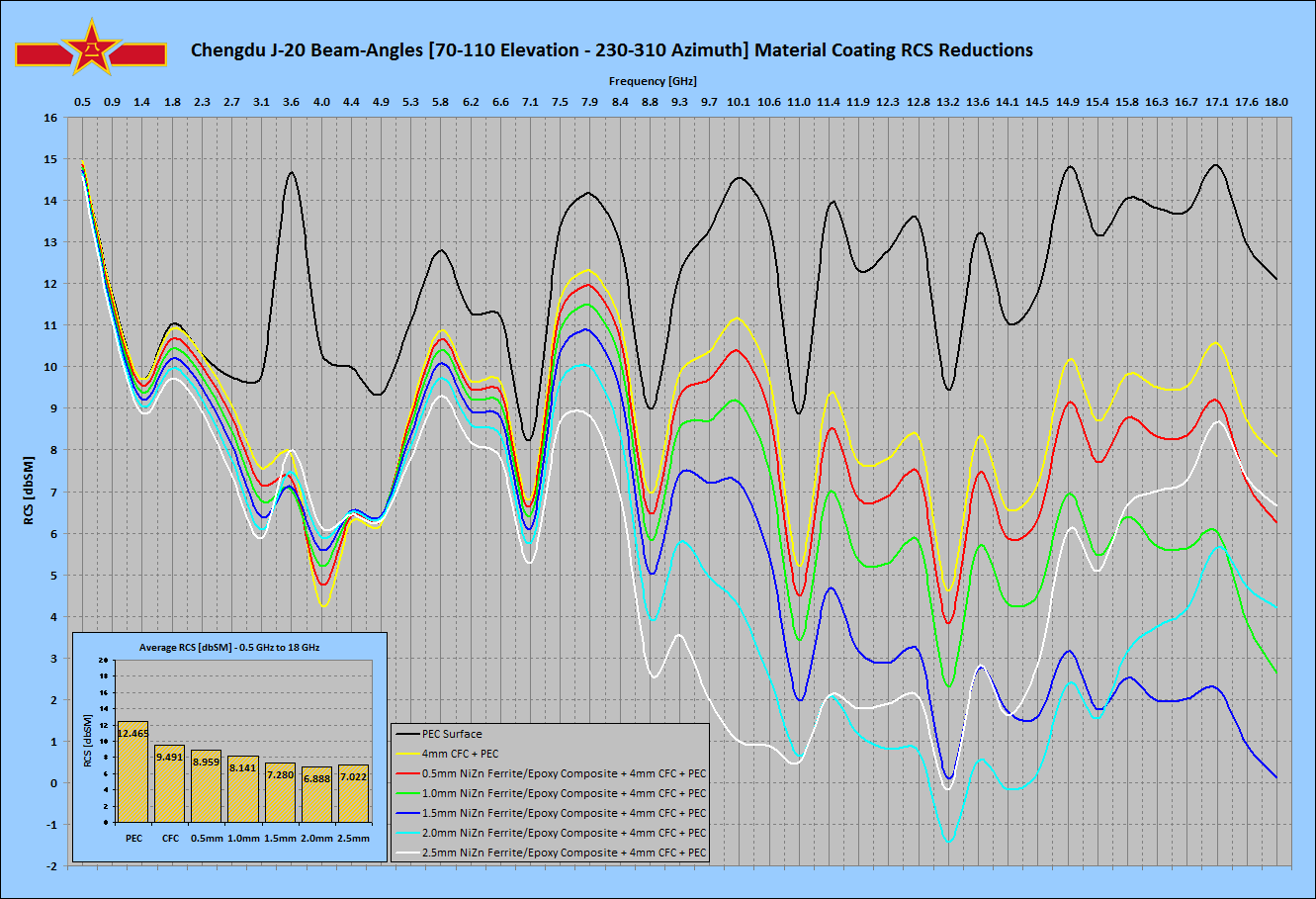
Some measure of the performance improvement achieved can be determined from the preceding chart, which shows specular RCS averaged across an angular extent in the beam aspect, across a range of frequencies. The beam aspect was chosen due to the dominant specular scatterers in this angular region. For a 2 mm ferrite loaded epoxy layer thickness laminated into a CFC panel, the absorber produces observable effect between S-band and Ku-band, improving with frequency. Best effect was achieved in the region of 12 GHz, of the order of 10 dB compared to PEC, all averaged across the same angular extent.
The variations in RCS behaviour observed with changing aspect reflect closely the behaviour observed with the PEC model simulation, detailed above. In particular, the RAM reduces the peak magnitude of and narrows the mainlobes in the specular return. This effect is most pronounced in the upper X-band and Ku-band, and weakest in the L-band.
In assessing what materials strategy to apply, several experimental simulations were performed to observe actual effectiveness, and the extent to which impedance mismatch impacted achievable RCS reduction.
The well characterised CNT/epoxy matrix RAM, by Zhang et al., was applied to a model of Zhang's test article used for measurement, and then as a 1 mm RAM coating over a PEC airframe skin, to establish whether this high permittivity material would be viable. The results reflected the strong impedance mismatch observed with the simulation of the initial test article, and this model was not pursued further. The material parameters are detailed in Table 5.
The more refined ferrite loaded Fe-filled CNT/epoxy matrix RAM by Gui et al., was not well characterised, so the published performance curves were employed to reverse engineer the complex permeability and permittivity values, using an RCS simulation of the test article employed by Gui et al., and an iterated guessing algorithm. This material also provided very poor impedance matching, reflected in a reduced resolution simulation of the airframe with a 1 mm coating over PEC. It was also not pursued further.
While the basic theoretical constraints for an impedance matched thin specular RAM coating predicted that neither material would be viable, it was nevertheless of interest to perform a quantitative simulation experiment to confirm this empirically.
A number of epoxy matrix coatings, using older and more recent ferrites, were also simulated, using a 4 mm thick carbon fibre epoxy composite substrate, emulating an aircraft skin.
The best specular RCS improvement observed involved the use of a theoretical impedance matched material, with real permeability and permittivity of ~15, and high loss tangents.
Table 3. J-20 Specular RCS Model Results With RAM / CFC [V-Pol]
[Click Thumbnail to Enlarge]
| Frequency
| 150
MHz
| 600
MHz
| 1.2
GHz
| 3.0
GHz
| 6.0
GHz
| 8.0
GHz
| 12.0
GHZ
| 16.0
GHz
| 28.0
GHz
| | θ | Φ | Ni-Zn Ferrite / Epoxy RAM / CFC Skin
| | 0 | 0 | N/C
| N/C | ![Chengdu-J-20-[2mm-Ferrite---4mm-CFC].mdb-01.20GHz-RsFromCoating-IncPol-TM-Pol-Theta-[E=000.0-A=000.0] Chengdu-J-20-[2mm-Ferrite---4mm-CFC].mdb-01.20GHz-RsFromCoating-IncPol-TM-Pol-Theta-[E=000.0-A=000.0]](http://www.ausairpower.net/PLA-VLO/.thumb_Chengdu-J-20-%5B2mm-Ferrite---4mm-CFC%5D.mdb-01.20GHz-RsFromCoating-IncPol-TM-Pol-Theta-%5BE=000.0-A=000.0%5D.png) | ![Chengdu-J-20-[2mm-Ferrite---4mm-CFC].mdb-03.00GHz-RsFromCoating-IncPol-TM-Pol-Theta-[E=000.0-A=000.0] Chengdu-J-20-[2mm-Ferrite---4mm-CFC].mdb-03.00GHz-RsFromCoating-IncPol-TM-Pol-Theta-[E=000.0-A=000.0]](http://www.ausairpower.net/PLA-VLO/.thumb_Chengdu-J-20-%5B2mm-Ferrite---4mm-CFC%5D.mdb-03.00GHz-RsFromCoating-IncPol-TM-Pol-Theta-%5BE=000.0-A=000.0%5D.png) | ![Chengdu-J-20-[2mm-Ferrite---4mm-CFC].mdb-06.00GHz-RsFromCoating-IncPol-TM-Pol-Theta-[E=000.0-A=000.0] Chengdu-J-20-[2mm-Ferrite---4mm-CFC].mdb-06.00GHz-RsFromCoating-IncPol-TM-Pol-Theta-[E=000.0-A=000.0]](http://www.ausairpower.net/PLA-VLO/.thumb_Chengdu-J-20-%5B2mm-Ferrite---4mm-CFC%5D.mdb-06.00GHz-RsFromCoating-IncPol-TM-Pol-Theta-%5BE=000.0-A=000.0%5D.png) | ![Chengdu-J-20-[2mm-Ferrite---4mm-CFC].mdb-08.00GHz-RsFromCoating-IncPol-TM-Pol-Theta-[E=000.0-A=000.0] Chengdu-J-20-[2mm-Ferrite---4mm-CFC].mdb-08.00GHz-RsFromCoating-IncPol-TM-Pol-Theta-[E=000.0-A=000.0]](http://www.ausairpower.net/PLA-VLO/.thumb_Chengdu-J-20-%5B2mm-Ferrite---4mm-CFC%5D.mdb-08.00GHz-RsFromCoating-IncPol-TM-Pol-Theta-%5BE=000.0-A=000.0%5D.png) | ![Chengdu-J-20-[2mm-Ferrite---4mm-CFC].mdb-12.00GHz-RsFromCoating-IncPol-TM-Pol-Theta-[E=000.0-A=000.0] Chengdu-J-20-[2mm-Ferrite---4mm-CFC].mdb-12.00GHz-RsFromCoating-IncPol-TM-Pol-Theta-[E=000.0-A=000.0]](http://www.ausairpower.net/PLA-VLO/.thumb_Chengdu-J-20-%5B2mm-Ferrite---4mm-CFC%5D.mdb-12.00GHz-RsFromCoating-IncPol-TM-Pol-Theta-%5BE=000.0-A=000.0%5D.png) | ![Chengdu-J-20-[2mm-Ferrite---4mm-CFC].mdb-16.00GHz-RsFromCoating-IncPol-TM-Pol-Theta-[E=000.0-A=000.0] Chengdu-J-20-[2mm-Ferrite---4mm-CFC].mdb-16.00GHz-RsFromCoating-IncPol-TM-Pol-Theta-[E=000.0-A=000.0]](http://www.ausairpower.net/PLA-VLO/.thumb_Chengdu-J-20-%5B2mm-Ferrite---4mm-CFC%5D.mdb-16.00GHz-RsFromCoating-IncPol-TM-Pol-Theta-%5BE=000.0-A=000.0%5D.png) | N/C | | 180 | 180 | N/C | N/C | ![Chengdu-J-20-[2mm-Ferrite---4mm-CFC].mdb-01.20GHz-RsFromCoating-IncPol-TM-Pol-Theta-[E=180.0-A=180.0] Chengdu-J-20-[2mm-Ferrite---4mm-CFC].mdb-01.20GHz-RsFromCoating-IncPol-TM-Pol-Theta-[E=180.0-A=180.0]](http://www.ausairpower.net/PLA-VLO/.thumb_Chengdu-J-20-%5B2mm-Ferrite---4mm-CFC%5D.mdb-01.20GHz-RsFromCoating-IncPol-TM-Pol-Theta-%5BE=180.0-A=180.0%5D.png) | ![Chengdu-J-20-[2mm-Ferrite---4mm-CFC].mdb-03.00GHz-RsFromCoating-IncPol-TM-Pol-Theta-[E=180.0-A=180.0] Chengdu-J-20-[2mm-Ferrite---4mm-CFC].mdb-03.00GHz-RsFromCoating-IncPol-TM-Pol-Theta-[E=180.0-A=180.0]](http://www.ausairpower.net/PLA-VLO/.thumb_Chengdu-J-20-%5B2mm-Ferrite---4mm-CFC%5D.mdb-03.00GHz-RsFromCoating-IncPol-TM-Pol-Theta-%5BE=180.0-A=180.0%5D.png) | ![Chengdu-J-20-[2mm-Ferrite---4mm-CFC].mdb-06.00GHz-RsFromCoating-IncPol-TM-Pol-Theta-[E=180.0-A=180.0] Chengdu-J-20-[2mm-Ferrite---4mm-CFC].mdb-06.00GHz-RsFromCoating-IncPol-TM-Pol-Theta-[E=180.0-A=180.0]](http://www.ausairpower.net/PLA-VLO/.thumb_Chengdu-J-20-%5B2mm-Ferrite---4mm-CFC%5D.mdb-06.00GHz-RsFromCoating-IncPol-TM-Pol-Theta-%5BE=180.0-A=180.0%5D.png) | ![Chengdu-J-20-[2mm-Ferrite---4mm-CFC].mdb-08.00GHz-RsFromCoating-IncPol-TM-Pol-Theta-[E=180.0-A=180.0] Chengdu-J-20-[2mm-Ferrite---4mm-CFC].mdb-08.00GHz-RsFromCoating-IncPol-TM-Pol-Theta-[E=180.0-A=180.0]](http://www.ausairpower.net/PLA-VLO/.thumb_Chengdu-J-20-%5B2mm-Ferrite---4mm-CFC%5D.mdb-08.00GHz-RsFromCoating-IncPol-TM-Pol-Theta-%5BE=180.0-A=180.0%5D.png) | ![Chengdu-J-20-[2mm-Ferrite---4mm-CFC].mdb-12.00GHz-RsFromCoating-IncPol-TM-Pol-Theta-[E=180.0-A=180.0] Chengdu-J-20-[2mm-Ferrite---4mm-CFC].mdb-12.00GHz-RsFromCoating-IncPol-TM-Pol-Theta-[E=180.0-A=180.0]](http://www.ausairpower.net/PLA-VLO/.thumb_Chengdu-J-20-%5B2mm-Ferrite---4mm-CFC%5D.mdb-12.00GHz-RsFromCoating-IncPol-TM-Pol-Theta-%5BE=180.0-A=180.0%5D.png) | ![Chengdu-J-20-[2mm-Ferrite---4mm-CFC].mdb-16.00GHz-RsFromCoating-IncPol-TM-Pol-Theta-[E=180.0-A=180.0] Chengdu-J-20-[2mm-Ferrite---4mm-CFC].mdb-16.00GHz-RsFromCoating-IncPol-TM-Pol-Theta-[E=180.0-A=180.0]](http://www.ausairpower.net/PLA-VLO/.thumb_Chengdu-J-20-%5B2mm-Ferrite---4mm-CFC%5D.mdb-16.00GHz-RsFromCoating-IncPol-TM-Pol-Theta-%5BE=180.0-A=180.0%5D.png) | N/C | | 090 | 180 | N/C | N/C | ![Chengdu-J-20-[2mm-Ferrite---4mm-CFC].mdb-01.20GHz-RsFromCoating-IncPol-TM-Pol-Theta-[E=090.0-A=180.0] Chengdu-J-20-[2mm-Ferrite---4mm-CFC].mdb-01.20GHz-RsFromCoating-IncPol-TM-Pol-Theta-[E=090.0-A=180.0]](http://www.ausairpower.net/PLA-VLO/.thumb_Chengdu-J-20-%5B2mm-Ferrite---4mm-CFC%5D.mdb-01.20GHz-RsFromCoating-IncPol-TM-Pol-Theta-%5BE=090.0-A=180.0%5D.png) | ![Chengdu-J-20-[2mm-Ferrite---4mm-CFC].mdb-03.00GHz-RsFromCoating-IncPol-TM-Pol-Theta-[E=090.0-A=180.0] Chengdu-J-20-[2mm-Ferrite---4mm-CFC].mdb-03.00GHz-RsFromCoating-IncPol-TM-Pol-Theta-[E=090.0-A=180.0]](http://www.ausairpower.net/PLA-VLO/.thumb_Chengdu-J-20-%5B2mm-Ferrite---4mm-CFC%5D.mdb-03.00GHz-RsFromCoating-IncPol-TM-Pol-Theta-%5BE=090.0-A=180.0%5D.png) | ![Chengdu-J-20-[2mm-Ferrite---4mm-CFC].mdb-06.00GHz-RsFromCoating-IncPol-TM-Pol-Theta-[E=090.0-A=180.0] Chengdu-J-20-[2mm-Ferrite---4mm-CFC].mdb-06.00GHz-RsFromCoating-IncPol-TM-Pol-Theta-[E=090.0-A=180.0]](http://www.ausairpower.net/PLA-VLO/.thumb_Chengdu-J-20-%5B2mm-Ferrite---4mm-CFC%5D.mdb-06.00GHz-RsFromCoating-IncPol-TM-Pol-Theta-%5BE=090.0-A=180.0%5D.png) | ![Chengdu-J-20-[2mm-Ferrite---4mm-CFC].mdb-08.00GHz-RsFromCoating-IncPol-TM-Pol-Theta-[E=090.0-A=180.0] Chengdu-J-20-[2mm-Ferrite---4mm-CFC].mdb-08.00GHz-RsFromCoating-IncPol-TM-Pol-Theta-[E=090.0-A=180.0]](http://www.ausairpower.net/PLA-VLO/.thumb_Chengdu-J-20-%5B2mm-Ferrite---4mm-CFC%5D.mdb-08.00GHz-RsFromCoating-IncPol-TM-Pol-Theta-%5BE=090.0-A=180.0%5D.png) | ![Chengdu-J-20-[2mm-Ferrite---4mm-CFC].mdb-12.00GHz-RsFromCoating-IncPol-TM-Pol-Theta-[E=090.0-A=180.0] Chengdu-J-20-[2mm-Ferrite---4mm-CFC].mdb-12.00GHz-RsFromCoating-IncPol-TM-Pol-Theta-[E=090.0-A=180.0]](http://www.ausairpower.net/PLA-VLO/.thumb_Chengdu-J-20-%5B2mm-Ferrite---4mm-CFC%5D.mdb-12.00GHz-RsFromCoating-IncPol-TM-Pol-Theta-%5BE=090.0-A=180.0%5D.png) | ![Chengdu-J-20-[2mm-Ferrite---4mm-CFC].mdb-16.00GHz-RsFromCoating-IncPol-TM-Pol-Theta-[E=090.0-A=180.0] Chengdu-J-20-[2mm-Ferrite---4mm-CFC].mdb-16.00GHz-RsFromCoating-IncPol-TM-Pol-Theta-[E=090.0-A=180.0]](http://www.ausairpower.net/PLA-VLO/.thumb_Chengdu-J-20-%5B2mm-Ferrite---4mm-CFC%5D.mdb-16.00GHz-RsFromCoating-IncPol-TM-Pol-Theta-%5BE=090.0-A=180.0%5D.png) | N/C | | 090 | 0 | N/C | N/C | ![Chengdu-J-20-[2mm-Ferrite---4mm-CFC].mdb-01.20GHz-RsFromCoating-IncPol-TM-Pol-Theta-[E=090.0-A=000.0] Chengdu-J-20-[2mm-Ferrite---4mm-CFC].mdb-01.20GHz-RsFromCoating-IncPol-TM-Pol-Theta-[E=090.0-A=000.0]](http://www.ausairpower.net/PLA-VLO/.thumb_Chengdu-J-20-%5B2mm-Ferrite---4mm-CFC%5D.mdb-01.20GHz-RsFromCoating-IncPol-TM-Pol-Theta-%5BE=090.0-A=000.0%5D.png) | ![Chengdu-J-20-[2mm-Ferrite---4mm-CFC].mdb-03.00GHz-RsFromCoating-IncPol-TM-Pol-Theta-[E=090.0-A=000.0] Chengdu-J-20-[2mm-Ferrite---4mm-CFC].mdb-03.00GHz-RsFromCoating-IncPol-TM-Pol-Theta-[E=090.0-A=000.0]](http://www.ausairpower.net/PLA-VLO/.thumb_Chengdu-J-20-%5B2mm-Ferrite---4mm-CFC%5D.mdb-03.00GHz-RsFromCoating-IncPol-TM-Pol-Theta-%5BE=090.0-A=000.0%5D.png) | ![Chengdu-J-20-[2mm-Ferrite---4mm-CFC].mdb-06.00GHz-RsFromCoating-IncPol-TM-Pol-Theta-[E=090.0-A=000.0] Chengdu-J-20-[2mm-Ferrite---4mm-CFC].mdb-06.00GHz-RsFromCoating-IncPol-TM-Pol-Theta-[E=090.0-A=000.0]](http://www.ausairpower.net/PLA-VLO/.thumb_Chengdu-J-20-%5B2mm-Ferrite---4mm-CFC%5D.mdb-06.00GHz-RsFromCoating-IncPol-TM-Pol-Theta-%5BE=090.0-A=000.0%5D.png) | ![Chengdu-J-20-[2mm-Ferrite---4mm-CFC].mdb-08.00GHz-RsFromCoating-IncPol-TM-Pol-Theta-[E=090.0-A=000.0] Chengdu-J-20-[2mm-Ferrite---4mm-CFC].mdb-08.00GHz-RsFromCoating-IncPol-TM-Pol-Theta-[E=090.0-A=000.0]](http://www.ausairpower.net/PLA-VLO/.thumb_Chengdu-J-20-%5B2mm-Ferrite---4mm-CFC%5D.mdb-08.00GHz-RsFromCoating-IncPol-TM-Pol-Theta-%5BE=090.0-A=000.0%5D.png) | ![Chengdu-J-20-[2mm-Ferrite---4mm-CFC].mdb-12.00GHz-RsFromCoating-IncPol-TM-Pol-Theta-[E=090.0-A=000.0] Chengdu-J-20-[2mm-Ferrite---4mm-CFC].mdb-12.00GHz-RsFromCoating-IncPol-TM-Pol-Theta-[E=090.0-A=000.0]](http://www.ausairpower.net/PLA-VLO/.thumb_Chengdu-J-20-%5B2mm-Ferrite---4mm-CFC%5D.mdb-12.00GHz-RsFromCoating-IncPol-TM-Pol-Theta-%5BE=090.0-A=000.0%5D.png) | ![Chengdu-J-20-[2mm-Ferrite---4mm-CFC].mdb-16.00GHz-RsFromCoating-IncPol-TM-Pol-Theta-[E=090.0-A=000.0] Chengdu-J-20-[2mm-Ferrite---4mm-CFC].mdb-16.00GHz-RsFromCoating-IncPol-TM-Pol-Theta-[E=090.0-A=000.0]](http://www.ausairpower.net/PLA-VLO/.thumb_Chengdu-J-20-%5B2mm-Ferrite---4mm-CFC%5D.mdb-16.00GHz-RsFromCoating-IncPol-TM-Pol-Theta-%5BE=090.0-A=000.0%5D.png) | N/C | | 090 | 270 | N/C | N/C | ![Chengdu-J-20-[2mm-Ferrite---4mm-CFC].mdb-01.20GHz-RsFromCoating-IncPol-TM-Pol-Theta-[E=090.0-A=270.0] Chengdu-J-20-[2mm-Ferrite---4mm-CFC].mdb-01.20GHz-RsFromCoating-IncPol-TM-Pol-Theta-[E=090.0-A=270.0]](http://www.ausairpower.net/PLA-VLO/.thumb_Chengdu-J-20-%5B2mm-Ferrite---4mm-CFC%5D.mdb-01.20GHz-RsFromCoating-IncPol-TM-Pol-Theta-%5BE=090.0-A=270.0%5D.png) | ![Chengdu-J-20-[2mm-Ferrite---4mm-CFC].mdb-03.00GHz-RsFromCoating-IncPol-TM-Pol-Theta-[E=090.0-A=270.0] Chengdu-J-20-[2mm-Ferrite---4mm-CFC].mdb-03.00GHz-RsFromCoating-IncPol-TM-Pol-Theta-[E=090.0-A=270.0]](http://www.ausairpower.net/PLA-VLO/.thumb_Chengdu-J-20-%5B2mm-Ferrite---4mm-CFC%5D.mdb-03.00GHz-RsFromCoating-IncPol-TM-Pol-Theta-%5BE=090.0-A=270.0%5D.png) | ![Chengdu-J-20-[2mm-Ferrite---4mm-CFC].mdb-06.00GHz-RsFromCoating-IncPol-TM-Pol-Theta-[E=090.0-A=270.0] Chengdu-J-20-[2mm-Ferrite---4mm-CFC].mdb-06.00GHz-RsFromCoating-IncPol-TM-Pol-Theta-[E=090.0-A=270.0]](http://www.ausairpower.net/PLA-VLO/.thumb_Chengdu-J-20-%5B2mm-Ferrite---4mm-CFC%5D.mdb-06.00GHz-RsFromCoating-IncPol-TM-Pol-Theta-%5BE=090.0-A=270.0%5D.png) | ![Chengdu-J-20-[2mm-Ferrite---4mm-CFC].mdb-08.00GHz-RsFromCoating-IncPol-TM-Pol-Theta-[E=090.0-A=270.0] Chengdu-J-20-[2mm-Ferrite---4mm-CFC].mdb-08.00GHz-RsFromCoating-IncPol-TM-Pol-Theta-[E=090.0-A=270.0]](http://www.ausairpower.net/PLA-VLO/.thumb_Chengdu-J-20-%5B2mm-Ferrite---4mm-CFC%5D.mdb-08.00GHz-RsFromCoating-IncPol-TM-Pol-Theta-%5BE=090.0-A=270.0%5D.png) | ![Chengdu-J-20-[2mm-Ferrite---4mm-CFC].mdb-12.00GHz-RsFromCoating-IncPol-TM-Pol-Theta-[E=090.0-A=270.0] Chengdu-J-20-[2mm-Ferrite---4mm-CFC].mdb-12.00GHz-RsFromCoating-IncPol-TM-Pol-Theta-[E=090.0-A=270.0]](http://www.ausairpower.net/PLA-VLO/.thumb_Chengdu-J-20-%5B2mm-Ferrite---4mm-CFC%5D.mdb-12.00GHz-RsFromCoating-IncPol-TM-Pol-Theta-%5BE=090.0-A=270.0%5D.png) | ![Chengdu-J-20-[2mm-Ferrite---4mm-CFC].mdb-16.00GHz-RsFromCoating-IncPol-TM-Pol-Theta-[E=090.0-A=270.0] Chengdu-J-20-[2mm-Ferrite---4mm-CFC].mdb-16.00GHz-RsFromCoating-IncPol-TM-Pol-Theta-[E=090.0-A=270.0]](http://www.ausairpower.net/PLA-VLO/.thumb_Chengdu-J-20-%5B2mm-Ferrite---4mm-CFC%5D.mdb-16.00GHz-RsFromCoating-IncPol-TM-Pol-Theta-%5BE=090.0-A=270.0%5D.png) | N/C | | 045 | 225 | N/C | N/C | ![Chengdu-J-20-[2mm-Ferrite---4mm-CFC].mdb-01.20GHz-RsFromCoating-IncPol-TM-Pol-Theta-[E=045.0-A=225.0] Chengdu-J-20-[2mm-Ferrite---4mm-CFC].mdb-01.20GHz-RsFromCoating-IncPol-TM-Pol-Theta-[E=045.0-A=225.0]](http://www.ausairpower.net/PLA-VLO/.thumb_Chengdu-J-20-%5B2mm-Ferrite---4mm-CFC%5D.mdb-01.20GHz-RsFromCoating-IncPol-TM-Pol-Theta-%5BE=045.0-A=225.0%5D.png) | ![Chengdu-J-20-[2mm-Ferrite---4mm-CFC].mdb-03.00GHz-RsFromCoating-IncPol-TM-Pol-Theta-[E=045.0-A=225.0] Chengdu-J-20-[2mm-Ferrite---4mm-CFC].mdb-03.00GHz-RsFromCoating-IncPol-TM-Pol-Theta-[E=045.0-A=225.0]](http://www.ausairpower.net/PLA-VLO/.thumb_Chengdu-J-20-%5B2mm-Ferrite---4mm-CFC%5D.mdb-03.00GHz-RsFromCoating-IncPol-TM-Pol-Theta-%5BE=045.0-A=225.0%5D.png) | ![Chengdu-J-20-[2mm-Ferrite---4mm-CFC].mdb-06.00GHz-RsFromCoating-IncPol-TM-Pol-Theta-[E=045.0-A=225.0] Chengdu-J-20-[2mm-Ferrite---4mm-CFC].mdb-06.00GHz-RsFromCoating-IncPol-TM-Pol-Theta-[E=045.0-A=225.0]](http://www.ausairpower.net/PLA-VLO/.thumb_Chengdu-J-20-%5B2mm-Ferrite---4mm-CFC%5D.mdb-06.00GHz-RsFromCoating-IncPol-TM-Pol-Theta-%5BE=045.0-A=225.0%5D.png) | ![Chengdu-J-20-[2mm-Ferrite---4mm-CFC].mdb-08.00GHz-RsFromCoating-IncPol-TM-Pol-Theta-[E=045.0-A=225.0] Chengdu-J-20-[2mm-Ferrite---4mm-CFC].mdb-08.00GHz-RsFromCoating-IncPol-TM-Pol-Theta-[E=045.0-A=225.0]](http://www.ausairpower.net/PLA-VLO/.thumb_Chengdu-J-20-%5B2mm-Ferrite---4mm-CFC%5D.mdb-08.00GHz-RsFromCoating-IncPol-TM-Pol-Theta-%5BE=045.0-A=225.0%5D.png) | ![Chengdu-J-20-[2mm-Ferrite---4mm-CFC].mdb-12.00GHz-RsFromCoating-IncPol-TM-Pol-Theta-[E=045.0-A=225.0] Chengdu-J-20-[2mm-Ferrite---4mm-CFC].mdb-12.00GHz-RsFromCoating-IncPol-TM-Pol-Theta-[E=045.0-A=225.0]](http://www.ausairpower.net/PLA-VLO/.thumb_Chengdu-J-20-%5B2mm-Ferrite---4mm-CFC%5D.mdb-12.00GHz-RsFromCoating-IncPol-TM-Pol-Theta-%5BE=045.0-A=225.0%5D.png) | ![Chengdu-J-20-[2mm-Ferrite---4mm-CFC].mdb-16.00GHz-RsFromCoating-IncPol-TM-Pol-Theta-[E=045.0-A=225.0] Chengdu-J-20-[2mm-Ferrite---4mm-CFC].mdb-16.00GHz-RsFromCoating-IncPol-TM-Pol-Theta-[E=045.0-A=225.0]](http://www.ausairpower.net/PLA-VLO/.thumb_Chengdu-J-20-%5B2mm-Ferrite---4mm-CFC%5D.mdb-16.00GHz-RsFromCoating-IncPol-TM-Pol-Theta-%5BE=045.0-A=225.0%5D.png) | N/C | | 135 | 225 | N/C | N/C | ![Chengdu-J-20-[2mm-Ferrite---4mm-CFC].mdb-01.20GHz-RsFromCoating-IncPol-TM-Pol-Theta-[E=135.0-A=225.0] Chengdu-J-20-[2mm-Ferrite---4mm-CFC].mdb-01.20GHz-RsFromCoating-IncPol-TM-Pol-Theta-[E=135.0-A=225.0]](http://www.ausairpower.net/PLA-VLO/.thumb_Chengdu-J-20-%5B2mm-Ferrite---4mm-CFC%5D.mdb-01.20GHz-RsFromCoating-IncPol-TM-Pol-Theta-%5BE=135.0-A=225.0%5D.png) | ![Chengdu-J-20-[2mm-Ferrite---4mm-CFC].mdb-03.00GHz-RsFromCoating-IncPol-TM-Pol-Theta-[E=135.0-A=225.0] Chengdu-J-20-[2mm-Ferrite---4mm-CFC].mdb-03.00GHz-RsFromCoating-IncPol-TM-Pol-Theta-[E=135.0-A=225.0]](http://www.ausairpower.net/PLA-VLO/.thumb_Chengdu-J-20-%5B2mm-Ferrite---4mm-CFC%5D.mdb-03.00GHz-RsFromCoating-IncPol-TM-Pol-Theta-%5BE=135.0-A=225.0%5D.png) | ![Chengdu-J-20-[2mm-Ferrite---4mm-CFC].mdb-06.00GHz-RsFromCoating-IncPol-TM-Pol-Theta-[E=135.0-A=225.0] Chengdu-J-20-[2mm-Ferrite---4mm-CFC].mdb-06.00GHz-RsFromCoating-IncPol-TM-Pol-Theta-[E=135.0-A=225.0]](http://www.ausairpower.net/PLA-VLO/.thumb_Chengdu-J-20-%5B2mm-Ferrite---4mm-CFC%5D.mdb-06.00GHz-RsFromCoating-IncPol-TM-Pol-Theta-%5BE=135.0-A=225.0%5D.png) | ![Chengdu-J-20-[2mm-Ferrite---4mm-CFC].mdb-08.00GHz-RsFromCoating-IncPol-TM-Pol-Theta-[E=135.0-A=225.0] Chengdu-J-20-[2mm-Ferrite---4mm-CFC].mdb-08.00GHz-RsFromCoating-IncPol-TM-Pol-Theta-[E=135.0-A=225.0]](http://www.ausairpower.net/PLA-VLO/.thumb_Chengdu-J-20-%5B2mm-Ferrite---4mm-CFC%5D.mdb-08.00GHz-RsFromCoating-IncPol-TM-Pol-Theta-%5BE=135.0-A=225.0%5D.png) | ![Chengdu-J-20-[2mm-Ferrite---4mm-CFC].mdb-12.00GHz-RsFromCoating-IncPol-TM-Pol-Theta-[E=135.0-A=225.0] Chengdu-J-20-[2mm-Ferrite---4mm-CFC].mdb-12.00GHz-RsFromCoating-IncPol-TM-Pol-Theta-[E=135.0-A=225.0]](http://www.ausairpower.net/PLA-VLO/.thumb_Chengdu-J-20-%5B2mm-Ferrite---4mm-CFC%5D.mdb-12.00GHz-RsFromCoating-IncPol-TM-Pol-Theta-%5BE=135.0-A=225.0%5D.png) | ![Chengdu-J-20-[2mm-Ferrite---4mm-CFC].mdb-16.00GHz-RsFromCoating-IncPol-TM-Pol-Theta-[E=135.0-A=225.0] Chengdu-J-20-[2mm-Ferrite---4mm-CFC].mdb-16.00GHz-RsFromCoating-IncPol-TM-Pol-Theta-[E=135.0-A=225.0]](http://www.ausairpower.net/PLA-VLO/.thumb_Chengdu-J-20-%5B2mm-Ferrite---4mm-CFC%5D.mdb-16.00GHz-RsFromCoating-IncPol-TM-Pol-Theta-%5BE=135.0-A=225.0%5D.png) | N/C | | 045 | 315 | N/C | N/C | ![Chengdu-J-20-[2mm-Ferrite---4mm-CFC].mdb-01.20GHz-RsFromCoating-IncPol-TM-Pol-Theta-[E=045.0-A=315.0] Chengdu-J-20-[2mm-Ferrite---4mm-CFC].mdb-01.20GHz-RsFromCoating-IncPol-TM-Pol-Theta-[E=045.0-A=315.0]](http://www.ausairpower.net/PLA-VLO/.thumb_Chengdu-J-20-%5B2mm-Ferrite---4mm-CFC%5D.mdb-01.20GHz-RsFromCoating-IncPol-TM-Pol-Theta-%5BE=045.0-A=315.0%5D.png) | ![Chengdu-J-20-[2mm-Ferrite---4mm-CFC].mdb-03.00GHz-RsFromCoating-IncPol-TM-Pol-Theta-[E=045.0-A=315.0] Chengdu-J-20-[2mm-Ferrite---4mm-CFC].mdb-03.00GHz-RsFromCoating-IncPol-TM-Pol-Theta-[E=045.0-A=315.0]](http://www.ausairpower.net/PLA-VLO/.thumb_Chengdu-J-20-%5B2mm-Ferrite---4mm-CFC%5D.mdb-03.00GHz-RsFromCoating-IncPol-TM-Pol-Theta-%5BE=045.0-A=315.0%5D.png) | ![Chengdu-J-20-[2mm-Ferrite---4mm-CFC].mdb-06.00GHz-RsFromCoating-IncPol-TM-Pol-Theta-[E=045.0-A=315.0] Chengdu-J-20-[2mm-Ferrite---4mm-CFC].mdb-06.00GHz-RsFromCoating-IncPol-TM-Pol-Theta-[E=045.0-A=315.0]](http://www.ausairpower.net/PLA-VLO/.thumb_Chengdu-J-20-%5B2mm-Ferrite---4mm-CFC%5D.mdb-06.00GHz-RsFromCoating-IncPol-TM-Pol-Theta-%5BE=045.0-A=315.0%5D.png) | ![Chengdu-J-20-[2mm-Ferrite---4mm-CFC].mdb-08.00GHz-RsFromCoating-IncPol-TM-Pol-Theta-[E=045.0-A=315.0] Chengdu-J-20-[2mm-Ferrite---4mm-CFC].mdb-08.00GHz-RsFromCoating-IncPol-TM-Pol-Theta-[E=045.0-A=315.0]](http://www.ausairpower.net/PLA-VLO/.thumb_Chengdu-J-20-%5B2mm-Ferrite---4mm-CFC%5D.mdb-08.00GHz-RsFromCoating-IncPol-TM-Pol-Theta-%5BE=045.0-A=315.0%5D.png) | ![Chengdu-J-20-[2mm-Ferrite---4mm-CFC].mdb-12.00GHz-RsFromCoating-IncPol-TM-Pol-Theta-[E=045.0-A=315.0] Chengdu-J-20-[2mm-Ferrite---4mm-CFC].mdb-12.00GHz-RsFromCoating-IncPol-TM-Pol-Theta-[E=045.0-A=315.0]](http://www.ausairpower.net/PLA-VLO/.thumb_Chengdu-J-20-%5B2mm-Ferrite---4mm-CFC%5D.mdb-12.00GHz-RsFromCoating-IncPol-TM-Pol-Theta-%5BE=045.0-A=315.0%5D.png) | ![Chengdu-J-20-[2mm-Ferrite---4mm-CFC].mdb-16.00GHz-RsFromCoating-IncPol-TM-Pol-Theta-[E=045.0-A=315.0] Chengdu-J-20-[2mm-Ferrite---4mm-CFC].mdb-16.00GHz-RsFromCoating-IncPol-TM-Pol-Theta-[E=045.0-A=315.0]](http://www.ausairpower.net/PLA-VLO/.thumb_Chengdu-J-20-%5B2mm-Ferrite---4mm-CFC%5D.mdb-16.00GHz-RsFromCoating-IncPol-TM-Pol-Theta-%5BE=045.0-A=315.0%5D.png) | N/C | | 135 | 315 | N/C | N/C | ![Chengdu-J-20-[2mm-Ferrite---4mm-CFC].mdb-01.20GHz-RsFromCoating-IncPol-TM-Pol-Theta-[E=135.0-A=315.0] Chengdu-J-20-[2mm-Ferrite---4mm-CFC].mdb-01.20GHz-RsFromCoating-IncPol-TM-Pol-Theta-[E=135.0-A=315.0]](http://www.ausairpower.net/PLA-VLO/.thumb_Chengdu-J-20-%5B2mm-Ferrite---4mm-CFC%5D.mdb-01.20GHz-RsFromCoating-IncPol-TM-Pol-Theta-%5BE=135.0-A=315.0%5D.png) | ![Chengdu-J-20-[2mm-Ferrite---4mm-CFC].mdb-03.00GHz-RsFromCoating-IncPol-TM-Pol-Theta-[E=135.0-A=315.0] Chengdu-J-20-[2mm-Ferrite---4mm-CFC].mdb-03.00GHz-RsFromCoating-IncPol-TM-Pol-Theta-[E=135.0-A=315.0]](http://www.ausairpower.net/PLA-VLO/.thumb_Chengdu-J-20-%5B2mm-Ferrite---4mm-CFC%5D.mdb-03.00GHz-RsFromCoating-IncPol-TM-Pol-Theta-%5BE=135.0-A=315.0%5D.png) | ![Chengdu-J-20-[2mm-Ferrite---4mm-CFC].mdb-06.00GHz-RsFromCoating-IncPol-TM-Pol-Theta-[E=135.0-A=315.0] Chengdu-J-20-[2mm-Ferrite---4mm-CFC].mdb-06.00GHz-RsFromCoating-IncPol-TM-Pol-Theta-[E=135.0-A=315.0]](http://www.ausairpower.net/PLA-VLO/.thumb_Chengdu-J-20-%5B2mm-Ferrite---4mm-CFC%5D.mdb-06.00GHz-RsFromCoating-IncPol-TM-Pol-Theta-%5BE=135.0-A=315.0%5D.png) | ![Chengdu-J-20-[2mm-Ferrite---4mm-CFC].mdb-08.00GHz-RsFromCoating-IncPol-TM-Pol-Theta-[E=135.0-A=315.0] Chengdu-J-20-[2mm-Ferrite---4mm-CFC].mdb-08.00GHz-RsFromCoating-IncPol-TM-Pol-Theta-[E=135.0-A=315.0]](http://www.ausairpower.net/PLA-VLO/.thumb_Chengdu-J-20-%5B2mm-Ferrite---4mm-CFC%5D.mdb-08.00GHz-RsFromCoating-IncPol-TM-Pol-Theta-%5BE=135.0-A=315.0%5D.png) | ![Chengdu-J-20-[2mm-Ferrite---4mm-CFC].mdb-12.00GHz-RsFromCoating-IncPol-TM-Pol-Theta-[E=135.0-A=315.0] Chengdu-J-20-[2mm-Ferrite---4mm-CFC].mdb-12.00GHz-RsFromCoating-IncPol-TM-Pol-Theta-[E=135.0-A=315.0]](http://www.ausairpower.net/PLA-VLO/.thumb_Chengdu-J-20-%5B2mm-Ferrite---4mm-CFC%5D.mdb-12.00GHz-RsFromCoating-IncPol-TM-Pol-Theta-%5BE=135.0-A=315.0%5D.png) | ![Chengdu-J-20-[2mm-Ferrite---4mm-CFC].mdb-16.00GHz-RsFromCoating-IncPol-TM-Pol-Theta-[E=135.0-A=315.0] Chengdu-J-20-[2mm-Ferrite---4mm-CFC].mdb-16.00GHz-RsFromCoating-IncPol-TM-Pol-Theta-[E=135.0-A=315.0]](http://www.ausairpower.net/PLA-VLO/.thumb_Chengdu-J-20-%5B2mm-Ferrite---4mm-CFC%5D.mdb-16.00GHz-RsFromCoating-IncPol-TM-Pol-Theta-%5BE=135.0-A=315.0%5D.png) | N/C |
dBSM Scale
|  |
Table 4. J-20 Specular RCS Model Results With RAM / CFC [V-Pol]
[Click Chart to Enlarge]
| | 1.2 GHz | ![Chengdu_J-20_[2mm_Ferrite_-_4mm_CFC].mdb-01.20GHz-RsFromCoating-IncPol-TM-Pol-Theta Chengdu_J-20_[2mm_Ferrite_-_4mm_CFC].mdb-01.20GHz-RsFromCoating-IncPol-TM-Pol-Theta](http://www.ausairpower.net/PLA-VLO/Chengdu_J-20_%5B2mm_Ferrite_-_4mm_CFC%5D.mdb-01.20GHz-RsFromCoating-IncPol-TM-Pol-Theta.png)
| | 3.0 GHz | 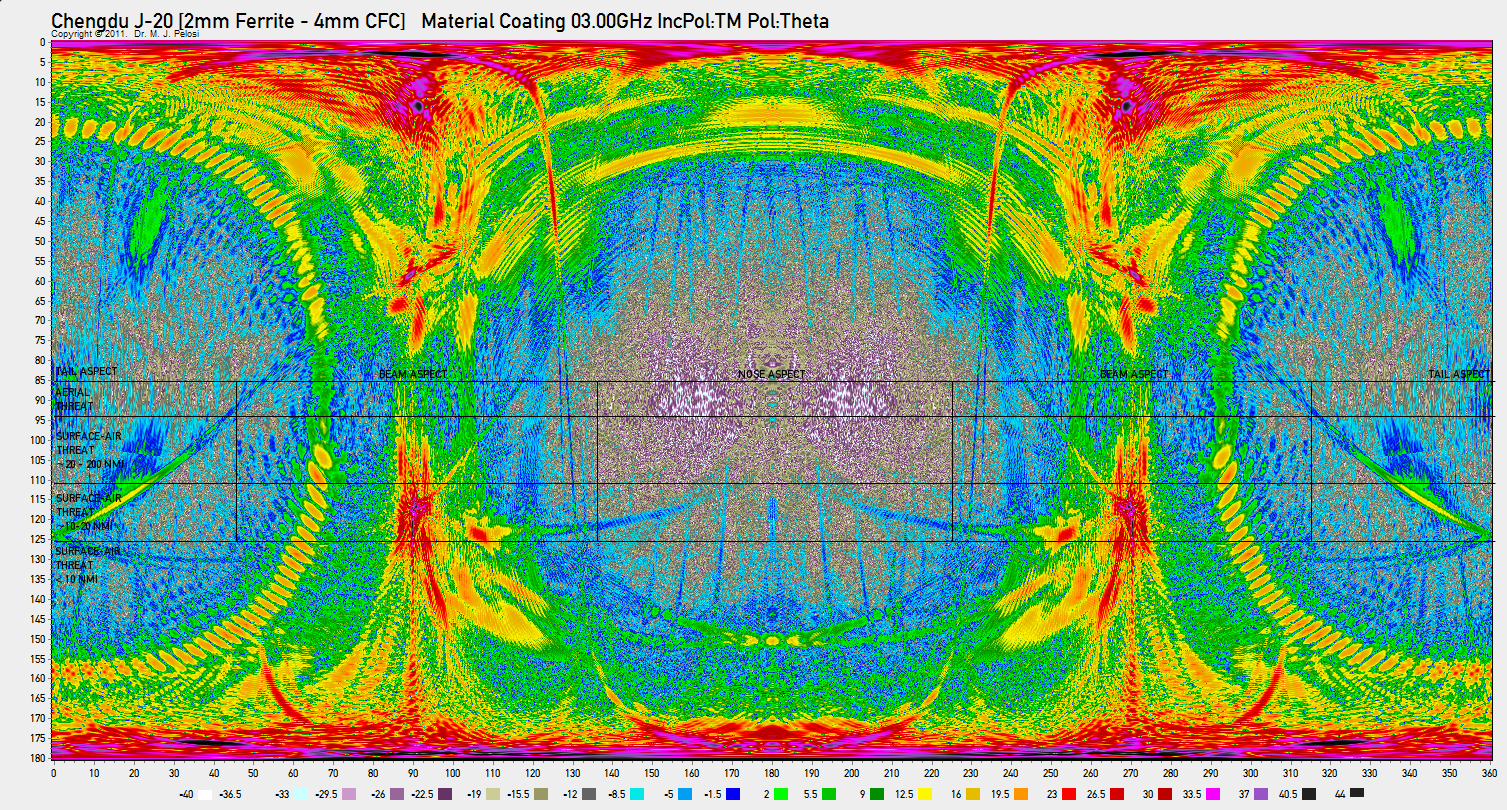
| | 6.0 GHz | 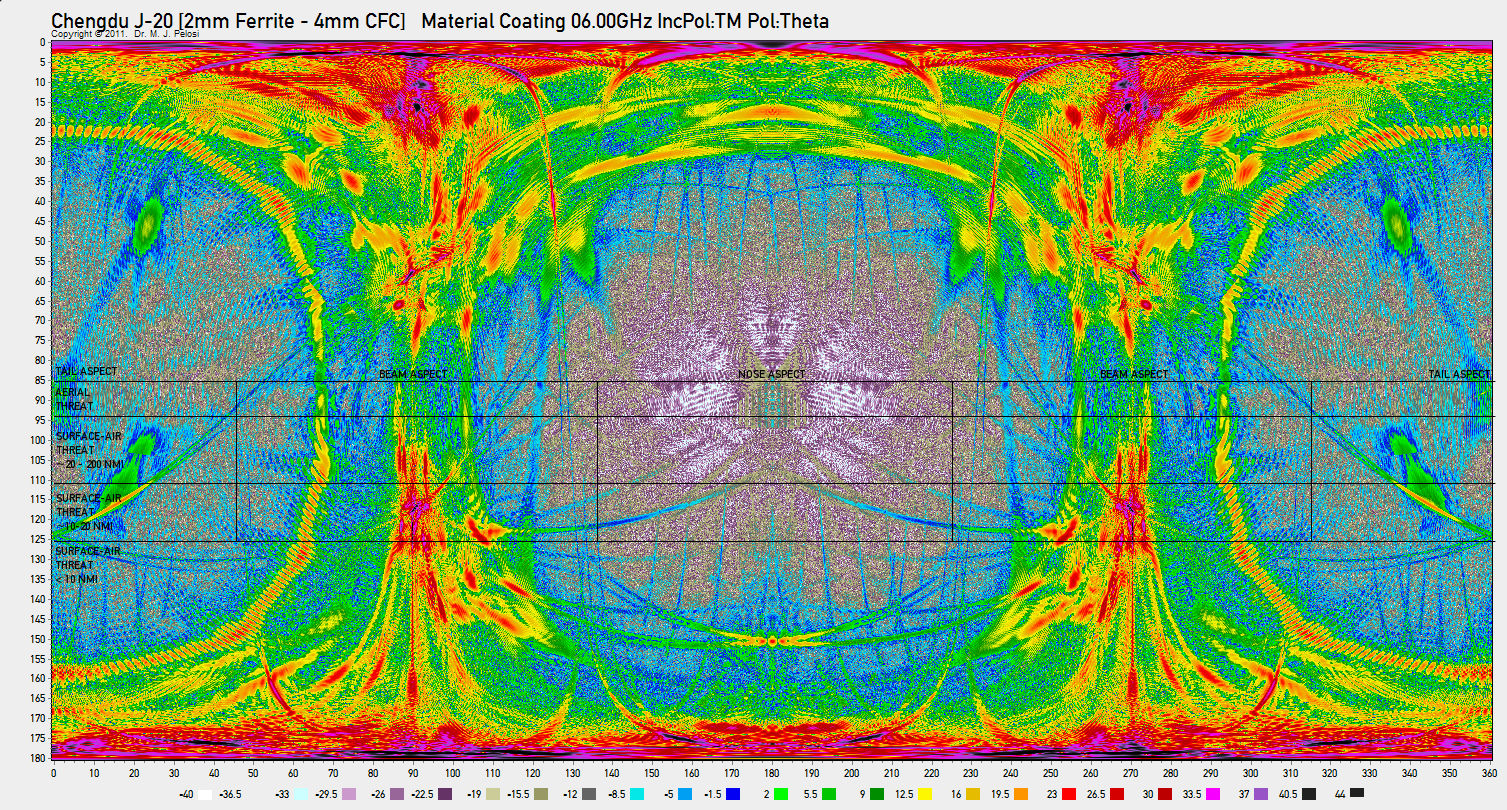
| | 8.0 GHz | 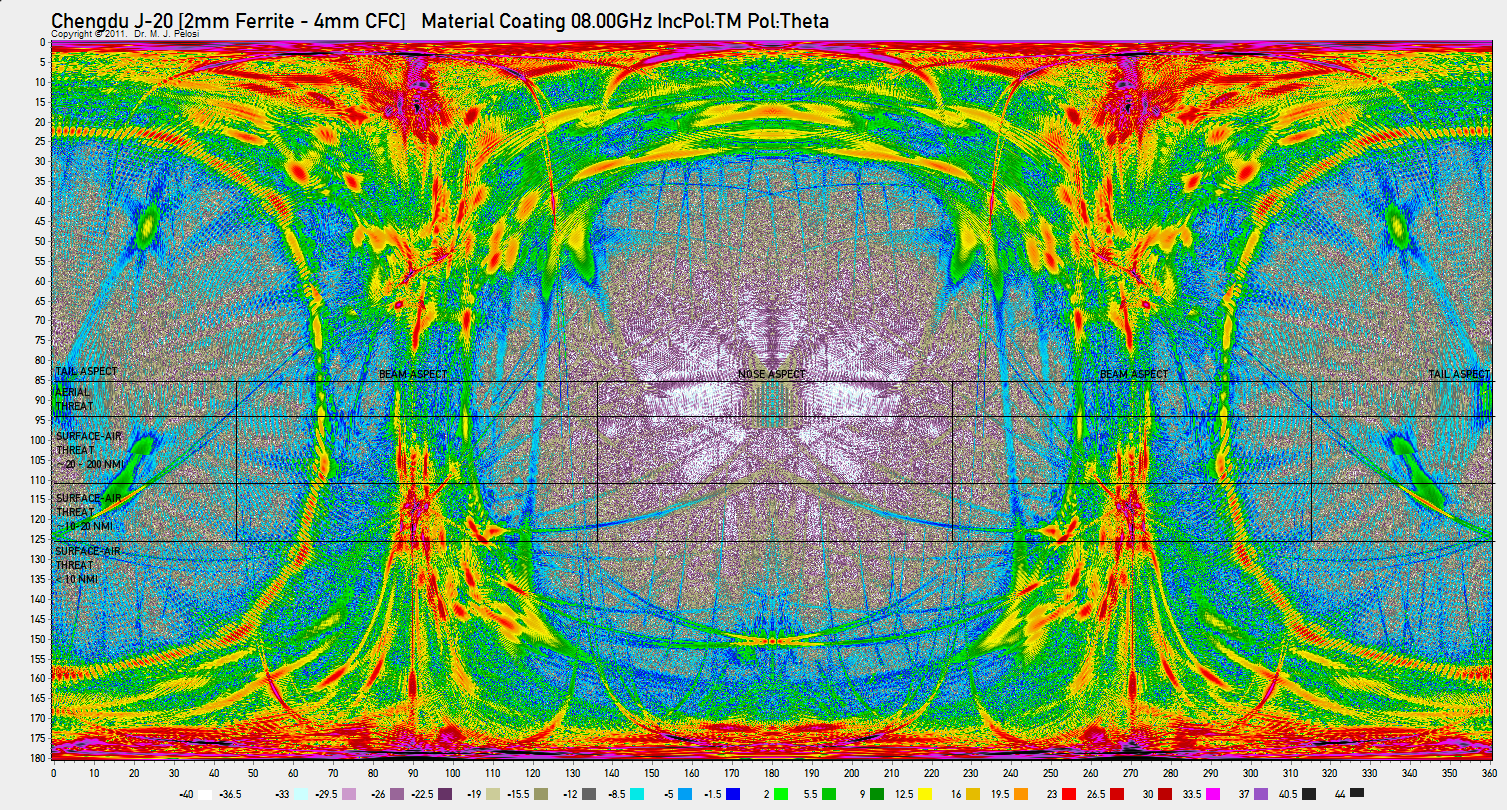
| | 12.0 GHZ | 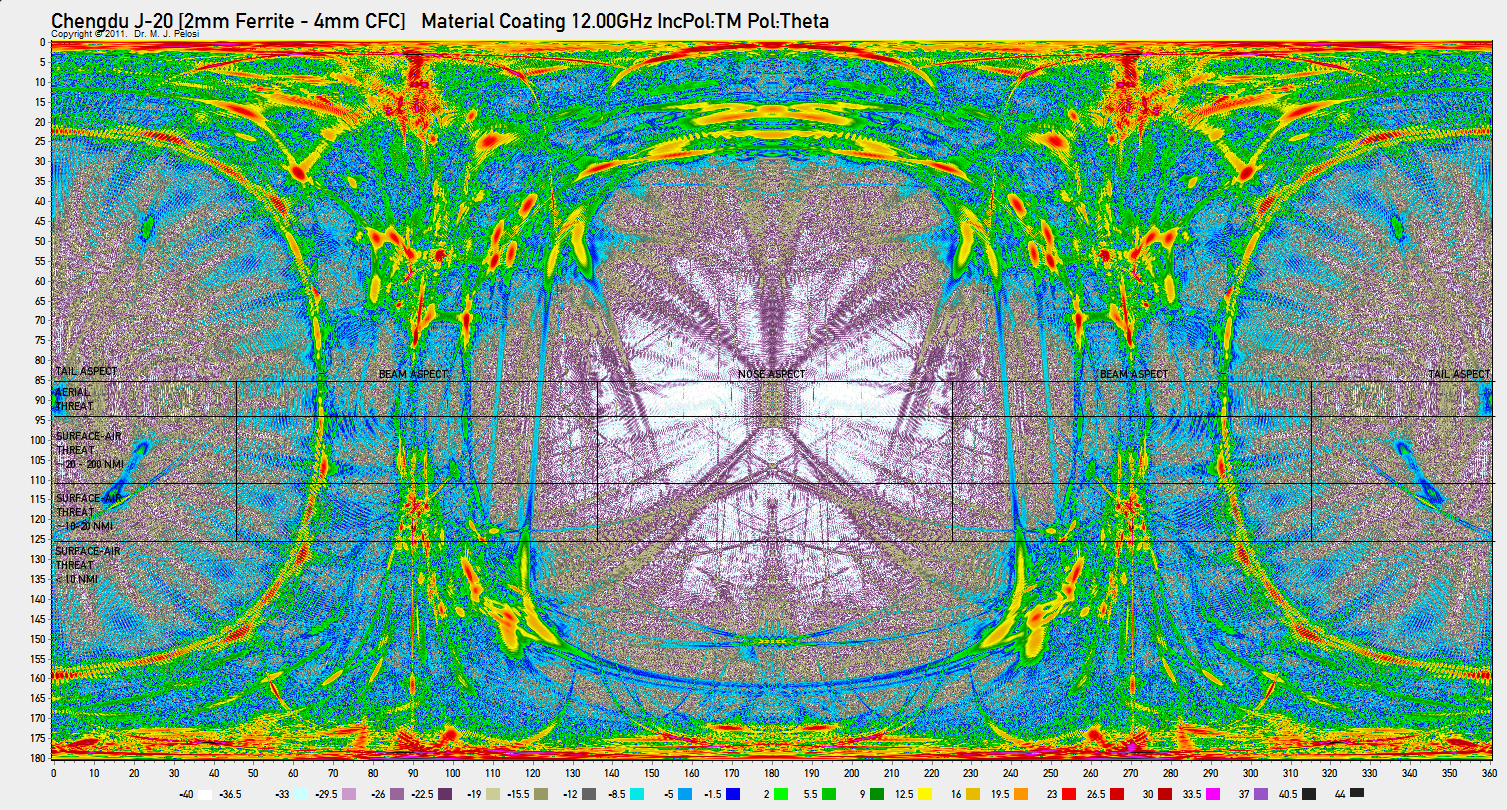
| | 16.0 GHz | 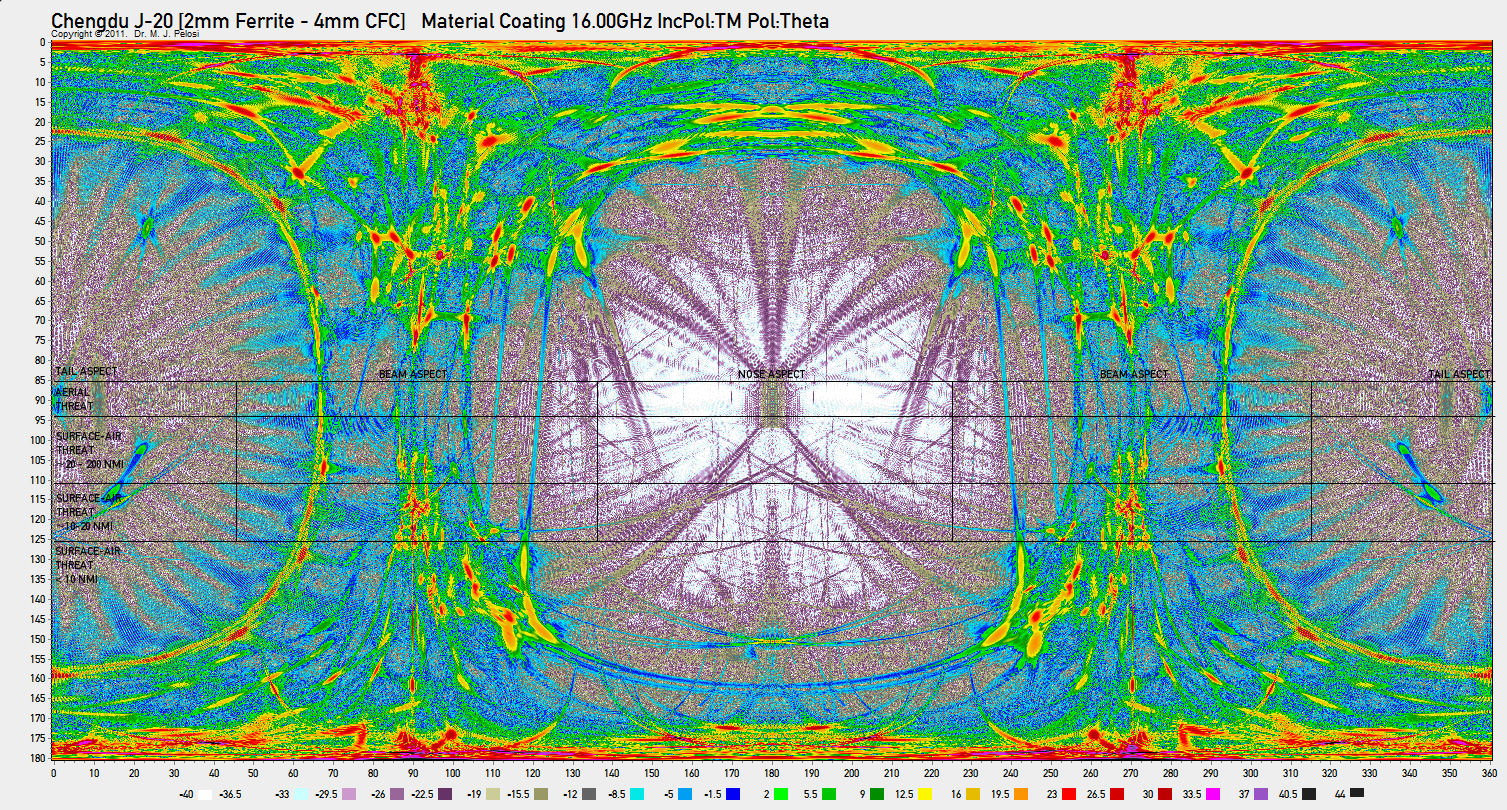
|
| | Table 4 Legend: |
|
| | NOSE ASPECT | Azimuthal Sector | 90° centred on aircraft nose | | TAIL ASPECT | Azimuthal Sector | 90° centred on aircraft tail | | BEAM ASPECT | Azimuthal Sector | 90° centred on aircraft side | AERIAL THREAT
| Depression Angle Ring | -5° - 3.7° aircraft at similar altitudes
| SURFACE-AIR THREAT ~20 - 200 NMI
| Depression Angle Ring | ~3.7° - 20° SAM at 200 down to 20 NMI
| | SURFACE-AIR THREAT ~10 - 20 NMI | Depression Angle Ring | ~20° - 36° SAM at 20 down to 10 NMI | | SURFACE-AIR THREAT <10 NMI | Depression Angle Ring
| ~36° SAM inside 10 NMI | Assumptions:
A.Distant threats CRPL exponential refractive atmospheric model;
B.Near threats SBF refractive atmospheric model;
C.Spherical earth model;
D.Assumed aircraft altitude 36 kft;
E.For higher aircraft altitudes the depression angles increase for nearer threats.
|
|
Table 5. Representative RAM and Material Properties
| Material
| Thickness
d [mm]
| Frequency
f [GHz]
| Resistivity
ρ [Ω·m]
| Permittivity
εr [-]
| Permeability
μr [-]
| Real
εr
| Loss
Tangent
δ
| Real
μr'
| Imaginary
μr"
| | A CNT/Epoxy1 | 1.0
|
|
|
|
|
|
|
|
| 0.1502
|
| 14.0
| 0.42
| 1.02
| 0.08
|
|
| 0.6002
|
| 14.0 | 0.42 | 1.02 | 0.08 |
|
| 1.2
|
| 14.0 | 0.42 | 1.02 | 0.08 |
|
| 2.0
|
| 14.0
| 0.42 | 1.02
| 0.08
|
|
| 3.0
|
| 14.0 | 0.42 | 1.02 | 0.08 |
|
| 6.0
|
| 14.0 | 0.43
| 1.05
| 0.09
|
|
| 8.0
|
| 14.0 | 0.435
| 1.08
| 0.10
|
|
| 12.0
|
| 14.0 | 0.443
| 1.11
| 0.105
|
|
| 16.0 |
| 14.0 | 0.45
| 1.14
| 0.11
|
|
| 28.0
|
| 14.0 | 0.58
| 1.1
| 0.01
| | B Ferrite/Epoxy3 | 2.0-3.0
|
|
|
|
|
|
|
|
| 1.24 |
| 4.7
| 0.064 | 1.15
| 1.2
|
|
| 3.04 |
| 4.7
| 0.064 | 1.1
| 0.80
|
|
| 6.0 |
| 4.6
| 0.065 | 0.90
| 0.38
|
|
| 8.0 |
| 4.9
| 0.061 | 0.8
| 0.20
|
|
| 12.0 |
| 5.0
| 0.060 | 0.95
| 0.08
|
|
| 16.04 |
| 5.0
| 0.060 | 0.95 | 0.08 | | C Ferrite/Epoxy/CFC3 | 6.0 (CFC)
|
|
|
|
|
|
|
|
| 1.24 |
| 25.0 | 0.12 | 1.15
| 1.2
|
|
| 3.04 |
| 25.0
| 0.12
| 1.1
| 0.80
|
|
| 6.0 |
| 22.0
| 0.18 | 0.90
| 0.38
|
|
| 8.0 |
| 23.0
| 0.30
| 0.8
| 0.20
|
|
| 12.0 |
| 15.0
| 0.53
| 0.95
| 0.08
|
|
| 16.04 |
| 7.50
| 1.46
| 0.95 | 0.08 | Carbon Fibre Composite5
| -
|
|
|
|
|
|
|
|
| 4.0 |
| 25.0
| 0.12
| 1.0
| 0.0 |
|
| 6.0 |
| 20.0
| 0.18
| 1.0
| 0.0 |
|
| 8.0 |
| 20.0
| 0.25
| 1.0
| 0.0 |
|
| 12.0 |
| 15.0
| 0.50
| 1.1
| 0.0 |
|
|
|
|
|
|
|
| Silver/Epoxy
| 0.2
| 0.15 - 28.0
| ~1.59×10−8 | N/A | N/A | 0.99998 | 0.0 | Aluminium
| 3.0
| 0.15 - 28.0 | 2.82×10−8 | N/A | N/A | 1.000022 | 0.0 | Epoxy Matrix
| 0.2
| 0.15 - 28.0 | Very High
| 4.6 - 3.0
| 0.01 | 1.0 | 0.0 | | Notes: |
|
|
|
|
|
|
| 1 - Zhang et al, 2009.
2 - Extrapolated from Zhang et al.
3 - Kim et al, 1997, KST, 2(b) Ni-Zn ferrite filler, ~3 mm loaded epoxy and ~3 mm CFC skin.
4 - Extrapolated from Kim et al, 1997, 2(b), using Ni-Zn ferrite frequency dependency properties for εr and μr.
5 - Kim et al, 2007.
|
|
Conclusions
This study has explored the specular Radar Cross Section of the Chengdu J-20 prototype aircraft shaping design. Simulations using a Physical Optics simulation algorithm were performed for frequencies of 150 MHz, 600 MHz, 1.2 GHz, 3.0 GHz, 6.0 GHz, 8.0 GHz, 12.0 GHz, 16.0 GHz and 28 GHz without an absorbent coating, and for frequencies of 1.2 GHz, 3.0 GHz, 6.0 GHz, 8.0 GHz, 12.0 GHz, 16.0 GHz with an absorbent coating, covering all angular aspects of the airframe.
In addition, the performance of a range of Chinese developed radar absorbers was modelled, based on a reasonable survey of unclassified Chinese research publications in the area. None of the surveyed materials were found to be suitable for use as impedance matched specular radar absorbers.
If the production J-20 retains the axisymmetric nozzles and smoothly area ruled sides, the aircraft could at best deliver robust Very Low Observable performance in the nose aspect angular sector.
If the production J-20 introduces a rectangular faceted nozzle design, and refinements to fuselage side shaping, the design would present very good potential for robust Very Low Observable performance in the S-band and above, for the nose and tail aspect angular sectors, with good performance in the beam aspect angular sector.
In conclusion, this study has established through Physical Optics simulation across nine frequency bands, that no fundamental obstacles exist in the shaping design of the J-20 prototype, which would preclude its development into a genuine Very Low Observable design.
|
|
Endnotes, References and Bibliography:
1 Knott, E.F., Schaeffer, J.F. and Tuley, M.T., Radar Cross Section, First Edition, Artech House, 1986; Knott, E.F., Schaeffer, J.F. and Tuley, M.T., Radar Cross Section, Second Edition, Artech House, 1993.
2 Kopp, C. and Goon, P.A., Assessing the Sukhoi PAK-FA; Sukhoi/KnAAPO T-50/I-21/Article 701 PAK-FA; Перспективный Авиационный Комплекс Фронтовой Авиации, APA Analyses APA-2010-1, Vol. VII APA-2010-01, Feb 2010, URI: http://www.ausairpower.net/APA-2010-01.html.
3 Kopp, C., Assessing Joint Strike Fighter Defence Penetration Capabilities, Air Power Australia Analysis 2009-01, 7th January 2009, URI: http://www.ausairpower.net/APA-2009-01.html
4 Kopp, C. and Goon, P.A., Chengdu J-20 Stealth Fighter Prototype; A Preliminary Assessment, Technical Report APA-TR-2011-0101, January 2011, URI: http://www.ausairpower.net/APA-J-XX-Prototype.html.
5 Chatzigeorgiadis, F., DEVELOPMENT OF CODE FOR A PHYSICAL OPTICS RADAR CROSS SECTION PREDICTION AND ANALYSIS APPLICATION, M.S. Thesis, NAVAL POSTGRADUATE SCHOOL, MONTEREY, CALIFORNIA, September 2004; Garrido, E.E. Jr, GRAPHICAL USER INTERFACE FOR A PHYSICAL OPTICS RADAR CROSS SECTION PREDICTION CODE, M.S. Thesis, NAVAL POSTGRADUATE SCHOOL, MONTEREY, CALIFORNIA, September 2000; Chatzigeorgiadis, F. and Jenn, D.C., “A MATLAB Physical Optics Prediction Code,” IEEE Antennas and Propagation Magazine, Vol. 46, No. 4, pp. 137-139, August 2004.
6 Gao, Z.H. and Wang, M.L., An Efficient Algorithm for Calculating Aircraft RCS Based on the Geometrical Characteristics, Chinese Journal of Aeronautics, Volume 21, Issue 4, August 2008, Pages 296-303.
7 Jiang, L.Y. et al., Design of high performance multilayer microwave absorbers using fast Pareto genetic algorithm,
Science in China Series E: Technological Sciences, Volume 52, Number 9, 2749-2757, DOI: 10.1007/s11431-009-0145-x, Springer Verlag, 2009.
8 Cao, M.S. et al., Computation design and performance prediction towards a multi-layer microwave absorber, Materials & Design, Volume 23, Issue 6, September 2002, Pages 557-564.
9 Chai, H.N., Electrical Property of Carbon Nanotube/PMMA/PVAc Composite Film, Advanced Materials Research(Volumes 11 - 12), February, 2006.
10 Che, R.C. et al., Microwave Absorption Enhancement and Complex Permittivity and Permeability of Fe Encapsulated within Carbon Nanotubes. Advanced Materials, 16: 401–405. doi: 10.1002/adma.200306460, 2004.
11 Du J.H et al, The present status and key problems of carbon nanotube based polymer composites, eXPRESS Polymer Letters Vol.1, No.5 (2007) 253–273.
12 Gan, Y.X., Permeability and permittivity measurement and reflectivity calculation for a microwave-absorbing composite material containing a resonator and an electromagnetic loss substance, Composites, Volume 23, Issue 6, November 1992, Pages 435-439.
13 Gui, X.C. et al., Optimization of electromagnetic matching of Fe-filled carbon nanotubes/ferrite composites for microwave absorption, J. Phys. D: Appl. Phys. 42 (2009), 075002, IOP Publishing Ltd, 2009.
14 Gui, X.C. et al., Microwave absorbing properties and magnetic properties of different carbon nanotubes, Science in China Series E: Technological Sciences, Volume 52, Number 1, 227-231, DOI: 10.1007/s11431-009-0020-9, June 2009, Springer Verlag.
15 Han, M.G. et al., Microwave Absorbing Properties of Amorphous FeCuNbSiB Microwires Multilayer Composites,ELECTROMAGNETIC MATERIALS, Proceedings of the Symposium P (ICMAT 2007), SUNTEC, Singapore, 1 - 6 July 2007.
16 Li, Q.H. et al., Study on the Microwave Permeability of the CNT Complex in 2-18 GHz, Applied Physics Research Vol. 2, No. 2; Canadian Center of Science and Education, November 2010.
17 Li, B.W. et al., Enhanced microwave absorption in nickel/hexagonal-ferrite/polymer composites, Appl. Phys. Lett. 89, 132504 (2006); doi:10.1063/1.2357565, September, 2006.
18 Liu, Z. et al., Microwave Absorption of Single-Walled Carbon Nanotubes/Soluble Cross-Linked Polyurethane Composites, J. Phys. Chem., 111, 13696-13700, American Chemical Society.
19 Qing, Y.C. et al., Electromagnetic and Absorbing Properties of Multi-walled Carbon Nanotubes/Epoxy-silicone Coatings, Journal of Inorganic Materials, 2010-02, (Abstract).
20 Zhang, X.F., High permittivity from defective carbon-coated Cu nanocapsules, Nanotechnology 18 275701, doi: 10.1088/0957-4484/18/27/275701, 2007.
21 Zhang, X. et al., Microwave Permittivity and Permeability of Activated Carbon Fibers Imbedded in Paraffin Wax, Conference Proceedings, American Carbon Society, Lexington, KY, July 14-19, 2001.
22 Zhang, Z. et al., Absorption properties of radar absorbing structure laminate composites filled with carbon nanotubes, Carbon – Sci. Tech. 3 (2009) 117 - 119, Applied Science Innovations Pvt. Ltd., India.
23 Zhao, D.L., COMPLEX PERMITTIVITY AND PERMEABILITY OF NI-COATED CARBON NANOTUBE / POLYMER COMPOSITES, Proceedings of the 35th ISTC, Dayton, Ohio, September 28, Society for the Advancement of Material and Process Engineering, October 2, 2003.
24 Zhao, D.L., et al., Formation Mechanism and Microwave Permittivity of Carbon Nanotubes Filled with Metallic Silver Nanowires, Key Engineering Materials, 334-335, 685, 2007.
25 Zhao, D.L., COMPLEX PERMITTIVITY AND PERMEABILITY OF CARBON NANOTUBES AT 26-40GHZ, Conference Proceedings, American Carbon Society, Brown University, Providence, RI, July 11-16, 2004.
26 Zhao, D.L. et al., Preparation of Carbon Nanotube Reinforced Epoxy Resin Coating and its Microwave Characteristics, Key Engineering Materials, Vol. 334-335, 677, March, 2007.
27 Zhao, D.L. et al., Microwave Permittivity and Permeability of Ni-Coated Carbon Nanotube / Polymer Composites, Key Engineering Materials, 334-335, 681, March, 2007.
28 Zhao, D.L. et al., Formation Mechanism and Microwave Permittivity of Carbon Nanotubes Filled with Metallic Silver Nanowires, Key Engineering Materials, 334-335, 685, March, 2007.
29 Yan, L.G. et al., Broadband and thin microwave absorber of nickel–zinc ferrite/carbonyl iron composite, Journal of Alloys and Compounds, Volume 487, Issues 1-2, 13 November 2009, Pages 708-711, Elsevier B.V., 2009.
30 Yuping, D. et al., The microwave electromagnetic characteristics of manganese dioxide with different crystallographic structures, Physica B: Condensed Matter, Volume 405, Issue 7, 1 April 2010, Pages 1826-1831, Elsevier B.V.
31 Wang, M. et al., Absorption properties of carbonyl-iron/carbon black double-layer microwave absorbers , Journal of Magnetism and Magnetic Materials, Volume 321, Issue 20, October 2009, Pages 3442-3446, Elsevier B.V.
32 Kim, S.S., Cheong, G.M. and Yoon, B.I., Ferrite-Epoxy Absorber on Carbon Fiber Composite Substrate, J. PHYS IV FRANCE 7 ( 1997), Colloque C1, Supplement au Journal de Physique 111 de mars 1997, EDP Sciences; also Kim S.H. et al, Double-layered microwave absorbers composed of ferrite and carbon fiber composite laminates, phys. stat. sol. (c) 4, No. 12, 4602–4605 (2007) / DOI 10.1002/pssc.200777374, WILEY-VCH Verlag GmbH & Co. KGaA, Weinheim.
33 Saville, P., A review of optimisation techniques for layered radar absorbing materials, Technical memorandum 2005-003, Defence R&D Canada; and Saville, P.. 2005. Review of Radar Absorbing Materials. DRDC Atlantic TM 2005-003, DRDC Atlantic.
34 Tuley, M.T. in Ch.8 (1).
35 Yuzcelik, C.K, Radar Absorbing Material Design, M.S.Thesis, Naval Postgraduate School, Monterey, California, September, 2003.
36 Schaeffer, J.F. in Ch.14 (1).
37 Kim, S.H. et al., Double-layered microwave absorbers composed of ferrite and carbon fiber composite laminates, phys. stat. sol. (c) 4, No. 12, 4602–4605 (2007) / DOI 10.1002/pssc.200777374, WILEY-VCH Verlag GmbH & Co. KGaA, Weinheim, December, 2007.
38 Barton, D.K. and Leonov, S.A., Editors, Radar Technology Encyclopedia, Artech House, Massachussetts, 1998, 0-89006-893-3.
39 Mitzner, K.M., Incremental Length Diffraction Coefficients, Technical Report AFAL-TR-73-296, Air Force Avionic Laboratory, Air Force Systems Command, WPAFB, April, 1974.
40 Stroobandt, S., The Characterization of Surface Waves on Low-Observable Structures, MSc Thesis, University of Hull, August, 1997.
|
|
Annex A Scales, Bands, Geometries, and Representative Threats
dBSM
| 30
| 20
| 10
| 0
| -10
| -20
| -30
| -40
| -50
|
|
| m2
| 1,000.0
| 100.0
| 10.0
| 1.0
| 0.1
| 0.01
| 0.001
| 0.0001
| 0.00001
|
|
| Table A.1 Conversion of RCS Values [dBSM] vs [m2]
|

Table A.2: US DoD Band Allocation Chart

Figure A.3: Threat depression angles as a function of type and missile kinematic range, for various contemporary and legacy SAMs of Russian/Soviet manufacture (C. Kopp).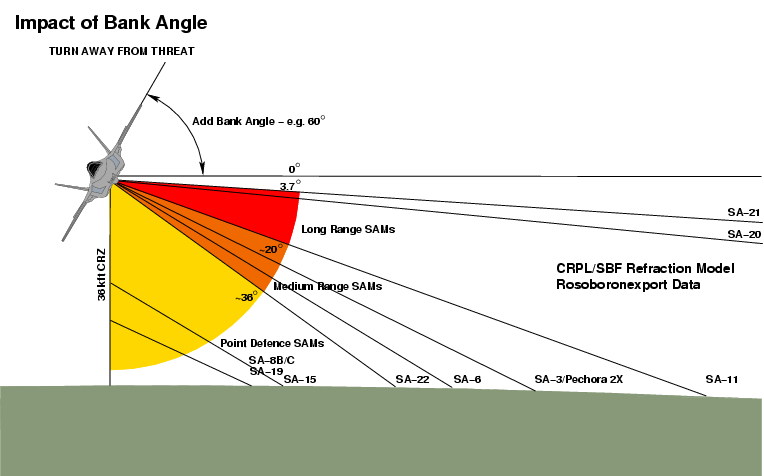
Figure A.4: The impact of bank angles on threat depression angles as a function of type and missile kinematic range, for various contemporary and legacy SAMs of Russian manufacture (C. Kopp).
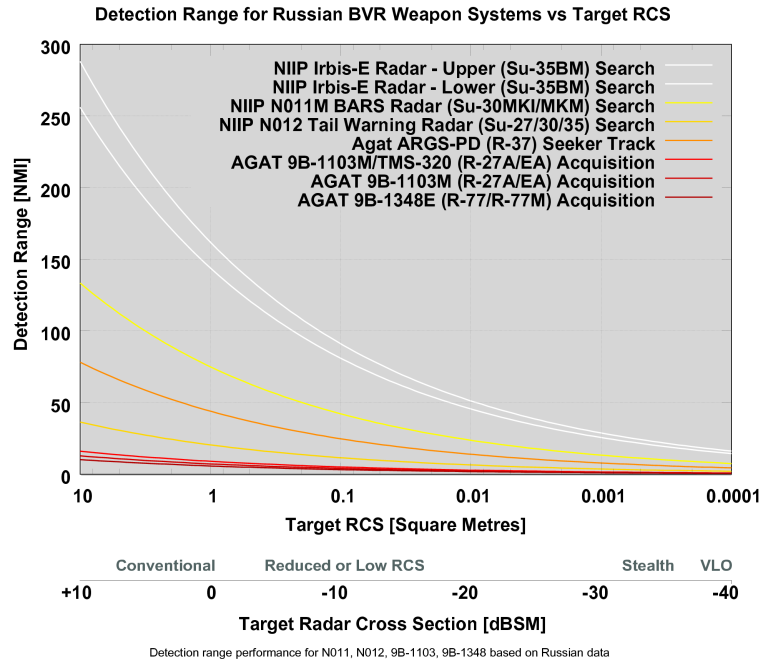
Figure A.5: Performance of representative Russian fighter radars and missile seekers (C. Kopp).
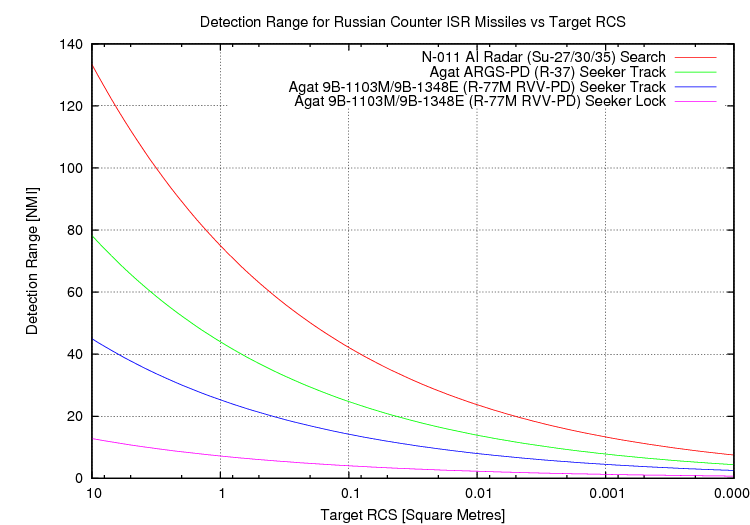
Figure A.6: Performance of representative Russian counter-ISR missile seekers (C. Kopp).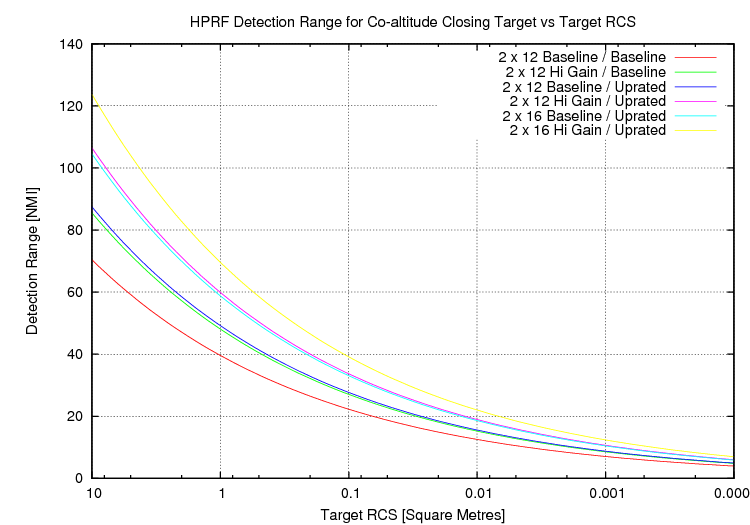
Figure A.7: Performance of NIIP L-Band AESA developed for Su-30MK/Su-35S (C. Kopp).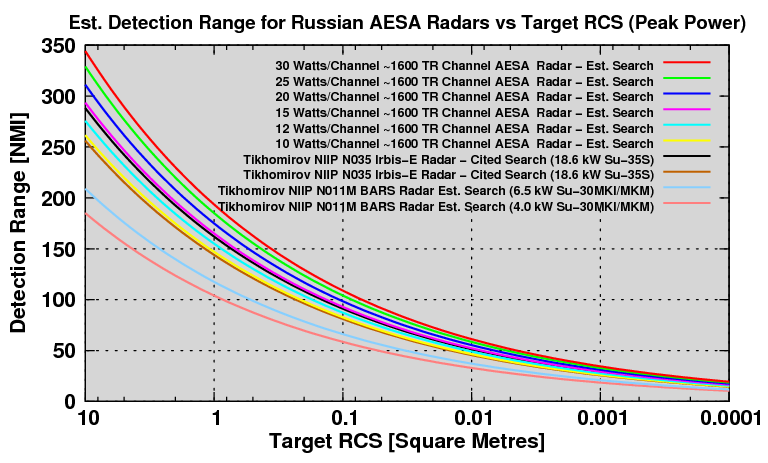
Figure A.8: Estimated detection range chart for variants of a Flanker sized AESA equipped with a range of Transmit Receive Module power ratings per channel. The detection range performance of the 10 and 12 Watt module equipped AESA is similar to the Tikhomirov NIIP Irbis-E hybrid ESA in the Su-35S, and much superior to the N011M BARS. The performance of AESA if equipped with modules rated above 15 Watts is superior to the Irbis E. Receiver noise figure and effective aperture area are assumed to be similar. N011M performance is based on parametric data and is better than NIIP cited figures (C. Kopp, 2008).
|
Annex B Basic Concepts in Absorbent Coatings Technology
The conventional approach to the design of absorbent coatings for controlling specular reflections is well documented, and good example of the principles is detailed by Kim et al32.
To minimise the reflection of impinging radar signals, the absorbent coating over the aircraft's skin must present an electrical characteristic impedance identical to the air surrounding it, which has an impedance very close to that of free space at 376.730313 Ω, usually approximated as Z0~377 Ω.
For any material to have an impedance of Z0 ≈ 377 Ω, its dielectric permittivity εr and magnetic permeability μr must be very similar in magnitude. This is because:
Z = √ jωμ/(σ + jωε) ; for very small conductivity σ, the impedance can be approximated as Z ≈ √μ/ε, where ω is angular frequency 2πf. If a material has this property and is infinitely thick, the impinging wave will be wholly trapped by the material, without a reflection. The captured wave propagating through the material will be attenuated over distance due to the dielectric and magnetic losses in the material, determined by the complex impedance properties of the material, ε"r and μ"r or the respective material loss tangents taneδ and tanmδ.
If we assume a conductive aircraft skin, such as a metal alloy panel, or structural epoxy composite treated with a conductive coating, or even an untreated structural epoxy composite, covered with an absorbent material coating of finite thickness, the behaviour observed is more complicated.
The wave propagating through the absorber will attenuate with depth, until it hits the impedance discontinuity of the aircraft's skin, where it will reflect. The reflected wave then propagates outward, attenuating with distance, until it hits the boundary between the absorbent coating and air upon which it is reradiated. The magnitude of the reradiated wave is determined by the lossiness of the material, as the wave passes through the material twice.
The attenuation of the wave as it penetrates into the absorber is given by33:
A(d) = A0e-αd
where α = – (μ0 ε0)1/2 ω (a2 + b2)1/4 sin [(1/2) tan−1 (–a/b)] and
a = (εr μr – εi μi ) and b = (εr μi – εi μr )
Tuley employs the term “electrical thickness” to describe the reduction of the wavelength of the penetrating wave as a result of the higher permittivity and permeability of the material, compared to free space, aiding the loss mechanisms34.
The angle of incidence of the wave will impact absorbing behaviour. At angles other than the broadside case (above) the pathlength through the absorber is necessarily increased, due to basic geometry. In addition, because the absorber is a medium of greater density than air, Snell's Law will apply, and the refractive index n = √μrεr of the material will alter the angle at which the absorber is being penetrated by the wave. In practical terms, an impedance matched absorber coating will perform better at shallower than broadside angles of incidence due to the increased pathlength through the absorber.
The “ideal” absorbent coating for controlling specular reflections would have a Zc ≈ 377 Ω, and be capable of infinitely attenuating all impinging waves at all frequencies of interest in an infinitesimally thin coating. Real materials cannot achieve such performance due to bounds in the magnitude of permittivity, permeability, and loss tangents. Dielectrics and ferrites developed for the electronics industry are indeed typically designed for as low a loss tangent as possible.
A well known difficulty with coatings for controlling specular reflections is in finding materials, or combinations of materials, in which both high permittivities and permeabilities exist, and in which these do not change significantly across a useful band of frequencies, or with environmental conditions, such as temperature.
Dielectric materials with very high permittivities have been developed for electronic component applications, which can be employed to load an epoxy matrix. CNT powders embedded in an epoxy matrix can yield permittivities of ~14.
The principal difficulty arises with the provision of materials to provide high permeability, such as ferrites, as these frequently have high intrinsic permittivities, which subject to the dielectric mixing equation, add in proportion to the permittivity of the epoxy matrix, which is itself typically of the order of εr ≈ 3.0 - 4.6 in the microwave bands, with loss tangents taneδ ≈ 0.01.
This strategy for absorber design is usually termed the “matched characteristic impedance” approach. It is not the only strategy available for achieving an impedance match.
Where the substrate is a material such as a carbon fibre composite panel, which has a complex impedance, the alternative strategy is the choice of a coating or outer panel layer which possesses a complex impedance, such that the combined effect of both layers is an impedance match. This strategy is usually termed the “matched wave impedance” approach35.
Kim et al define the impedance problem in this manner, in terms of impedance mismatch at the air to absorber boundary, where the effective impedance seen by the impinging wave at the air to absorber boundary is determined by the electrical properties of the absorber, its thickness, and the electrical properties of the aircraft skin beneath it. In this instance, an absorber which heavily attenuates the wave produces effective impedance close to Z0, while a less effective absorber exposes the reflection from the aircraft skin, and thus presents as an impedance mismatch at the boundary between the coating and the air.
Yuzcelik includes an example, detailed in Equations 4.27 and 4.2735, for a carbon fibre composite, but the complex permittivity value employed is slightly below measured values32, 35, 37.
Nevertheless, the solution computed by Yuzcelik, Figure 2035, would produce a viable result. Satisfying the necessary equalities for a thin coating will require materials with very high permeability.
In conclusion, the control of specular reflections is only part of a designer's task in applying absorbent materials to an aircraft. Control of edge currents, and surface travelling waves, may require materials with other properties, such as resistive coatings, or strongly magnetic coatings.
|
Annex C Axisymmetric Nozzle RCS Performance
The use of axisymmetric nozzles in aircraft intended to have VLO characteristics is a poor design practice. Such nozzles have been employed on the prototypes of the T-50 PAK-FA, J-20, and are intended for the production F-35 configurations.
Axisymmetric nozzles are a direct adaption of the conventional convergent/divergent nozzle designs initially developed during the 1960s to provide a variable nozzle cross-section with an afterburning gas turbine engine. The nozzle shroud is constructed using multiple petals, which slide in the manner of an iris to smoothly change the cross-section of the nozzle aperture, controlled by the engine control system to provide the best aperture for the engine's instantaneous operating conditions.
The RCS of such a nozzle comprises several discrete components36:
A specular return from the outer shroud of the nozzle, which produces a “doughnut-shaped” symmetrical mainlobe, the peak of which is normal to the face of each petal; the position of the nozzle alters the direction and magnitude of this mainlobe peak; A diffractive return from the nozzle aperture rim, approximated as σrim ≈ πr2 where r is the nozzle aperture radius; this return is also rotationally symmetric, but dependent on incident polarisation with the strongest returns resulting from rim components approximately parallel to the electric field. A cavity return from the tailpipe of the engine, which varies with aspect angle and nozzle position, and is often approximated as σtailpipe ≈ 2πr2 where r is the nozzle aperture radius; random internal bounces are assumed.
A more accurate model for the tailpipe cavity RCS which accounts for aperture foreshortening is σtailpipe ≈ πr2cos2θ, where r is the nozzle aperture radius and θ the angle off the nozzle axis of symmetry. This model is depicted below. For representative diameters, the tailpipe RCS is of the order of 0.5 [m2].
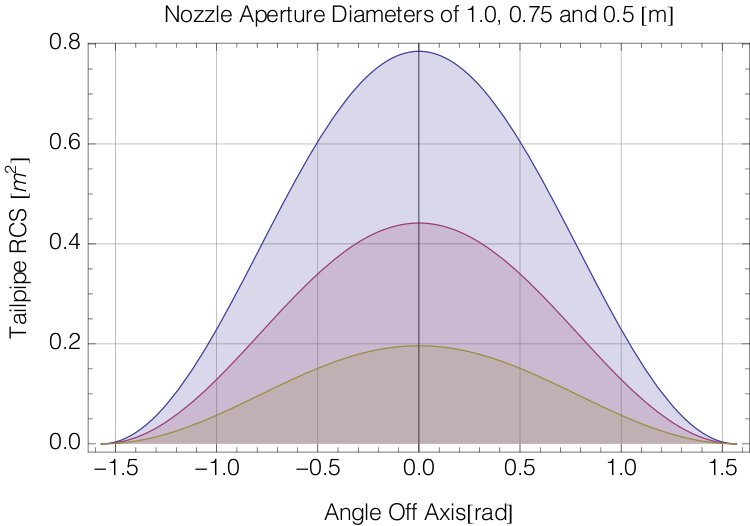
Example untreated tailpipe model, for nozzle aperture diameters of 0.5, 0.75, and 1.0 metres. The angular range depicted is the whole aft hemisphere, with rotational symmetry about the nozzle axis, and a peak RCS from directly behind the aircraft. The resulting magnitudes qualify neither as Very Low Observable or Low Observable, but could be reduced by tailpipe treatments (C Kopp).
Two adaptations have been employed to reduce axisymmetric nozzle RCS in comparison with designs of two decades ago.
The first adaptation is the use of flat petals to form the nozzle shroud segments, removing single or double curvatures. This is intended as a form of faceting, to concentrate the specular return from each petal into a single narrow mainlobe. For typical nozzle dimensions, this technique provides some effect, but only in the upper X-band and Ku/K-bands. Where the wavelength is greater than or comparable to the dimensions of facets, the specular return approximates that of a smooth conical frustrum.
The second adaptation is the use of a serrated nozzle rim, typically using a symmetrical or near symmetrical triangular serration. This technique is also limited in effect to wavelengths where the serration edge length can form a discrete mainlobe. At such frequencies, the serrations produce a conical pattern of discrete narrow mainlobes. For typical nozzle dimensions, this technique provides some effect, but only in the upper X-band and Ku/K-bands. Where the wavelength is greater than or comparable to the dimensions of serrations, the diffractive return approximates that of a smooth circular rim.
The diffractive rim return is an unavoidable byproduct of the axisymmetric nozzle geometry, and in bands where the serrations are ineffective, yields for typical dimensions a return of the order of σrim ≈ 0.5 - 0.8 m2 or -0.9 to -3 dBSM. Such magnitudes qualify neither as Very Low Observable or Low Observable.
In practical terms the axisymmetric nozzle is incompatible with Very Low Observable, or indeed Low Observable, capabilities, and at best yields effects only in the upper bands where active radar homing missile seekers and some missile engagement radars operate. The effect of the shaping adaptations for specular and diffractive rim returns will be that of changing a stable return to a strongly scintillating return. How effective this might be in defeating a missile seeker would depend to a large extent on the design of the seeker and its ability to track such a strongly scintillating return. A more sophisticated seeker would defeat this technique.
The axisymmetric nozzle design is not viable for aircraft intended to penetrate an IADS, as the aircraft will frequently be painted in the aft hemisphere by radars operating across a wide range of bands. In fighter air combat, this strategy is not compatible with any tailchase geometry, as the evading aircraft is pointing its high signature aft hemisphere at the pursuing threat. The survivability of the aircraft will then be determined primarily by the closure rate of the threat, and defaults to the scenarios observed with engagements between aircraft lacking low observability characteristics.
A Physical Optics simulation of the RCS of external shroud of an axisymmetric nozzle was produced to capture the behaviour of the specular component of the nozzle exterior signature. This Physical Optics simulation model does not include a diffractive rim backscatter contribution, or a tailpipe cavity backscatter contribution, both of which are additive to the specular backscatter from the nozzle external skin, and typically dominant from the aft aspects. The observed behaviour in the simulation reflects theoretical predictions for the nozzle very closely.
A strong mainlobe of the order of 12 dBSM is observed at the normal to each petal in the nozzle, with pronounced and periodic axial sidelobes between -8.5 dBSM, -5 dBSM, -1.5 dBSM and 2 dBSM, with angular periodicity reflecting the ratio between feature size and wavelength. Plotted results are in Tables C.1 and C.2.
If we consider -10 dBSM as a reasonable upper bound for compromising the performance of a threat radar in the X-band, the dense sidelobe structure occupies a rotational angular volume from the plane of the nozzle out to almost 45° off the axis of nozzle symmetry.
Behaviour was better in the Ku-band, as the mainlobe and sidelobe width was narrower, concentrating backscatter into a much smaller number of more pronounced lobes.
At S-band and below, the backscatter from overlapping sidelobes forms large regions with strong and stable returns.
A simulation performed using a pair of nozzles separated by a distance identical to that in the J-20 prototype produced an almost identical lobing structure, but with more complex fine structure reflecting in and out of phase additions of backscatter from the respective nozzles.
As noted previously, the overall RCS of the nozzle must also include a tailpipe cavity component, of the order of σtailpipe ≈ 0.5 - 0.8 m2 in magnitude, and a diffractive component produced by the aperture rim, of the order of σrim ≈ 0.5 - 0.8 m2 in magnitude, with a periodic mainlobe and sidelobe structure in the latter forming at wavelengths where serrations produce effect, and rim facets producing discrete specular returns. The Physical Optics simulation indicates that this lobing structure will become prominent at 6 to 8 GHz and above.
The results of the simulation effort validate the theoretical prediction that the axi-symmetric nozzle design does not quality as a Very Low Observable, or indeed Low Observable design in most bands of operational interest.
Table C.1. Axisymmetric Nozzle Specular RCS Model Results PEC [V-Pol]
[Click Thumbnail to Enlarge]
| Frequency
| 150
MHz
| 600
MHz
| 1.2
GHz
| 3.0
GHz
| 6.0
GHz
| 8.0
GHz
| 12.0
GHZ
| 16.0
GHz
| 28.0
GHz
| | θ | Φ | PEC Skin [Baseline]
| | 090 | 180 | ![J-20-Axisymmetric-Serrated-Nozzle.mdb-00.15GHz-Rs0000-IncPol-TM-Pol-Theta-[E=090.0-A=180.0] J-20-Axisymmetric-Serrated-Nozzle.mdb-00.15GHz-Rs0000-IncPol-TM-Pol-Theta-[E=090.0-A=180.0]](http://www.ausairpower.net/PLA-VLO/Nozzle/.thumb_J-20-Axisymmetric-Serrated-Nozzle.mdb-00.15GHz-Rs0000-IncPol-TM-Pol-Theta-%5BE=090.0-A=180.0%5D.png) | ![J-20-Axisymmetric-Serrated-Nozzle.mdb-00.60GHz-Rs0000-IncPol-TM-Pol-Theta-[E=090.0-A=180.0] J-20-Axisymmetric-Serrated-Nozzle.mdb-00.60GHz-Rs0000-IncPol-TM-Pol-Theta-[E=090.0-A=180.0]](http://www.ausairpower.net/PLA-VLO/Nozzle/.thumb_J-20-Axisymmetric-Serrated-Nozzle.mdb-00.60GHz-Rs0000-IncPol-TM-Pol-Theta-%5BE=090.0-A=180.0%5D.png) | ![J-20-Axisymmetric-Serrated-Nozzle.mdb-01.20GHz-Rs0000-IncPol-TM-Pol-Theta-[E=090.0-A=180.0] J-20-Axisymmetric-Serrated-Nozzle.mdb-01.20GHz-Rs0000-IncPol-TM-Pol-Theta-[E=090.0-A=180.0]](http://www.ausairpower.net/PLA-VLO/Nozzle/.thumb_J-20-Axisymmetric-Serrated-Nozzle.mdb-01.20GHz-Rs0000-IncPol-TM-Pol-Theta-%5BE=090.0-A=180.0%5D.png) | ![J-20-Axisymmetric-Serrated-Nozzle.mdb-03.00GHz-Rs0000-IncPol-TM-Pol-Theta-[E=090.0-A=180.0] J-20-Axisymmetric-Serrated-Nozzle.mdb-03.00GHz-Rs0000-IncPol-TM-Pol-Theta-[E=090.0-A=180.0]](http://www.ausairpower.net/PLA-VLO/Nozzle/.thumb_J-20-Axisymmetric-Serrated-Nozzle.mdb-03.00GHz-Rs0000-IncPol-TM-Pol-Theta-%5BE=090.0-A=180.0%5D.png) | ![J-20-Axisymmetric-Serrated-Nozzle.mdb-06.00GHz-Rs0000-IncPol-TM-Pol-Theta-[E=090.0-A=180.0] J-20-Axisymmetric-Serrated-Nozzle.mdb-06.00GHz-Rs0000-IncPol-TM-Pol-Theta-[E=090.0-A=180.0]](http://www.ausairpower.net/PLA-VLO/Nozzle/.thumb_J-20-Axisymmetric-Serrated-Nozzle.mdb-06.00GHz-Rs0000-IncPol-TM-Pol-Theta-%5BE=090.0-A=180.0%5D.png) | ![J-20-Axisymmetric-Serrated-Nozzle.mdb-08.00GHz-Rs0000-IncPol-TM-Pol-Theta-[E=090.0-A=180.0] J-20-Axisymmetric-Serrated-Nozzle.mdb-08.00GHz-Rs0000-IncPol-TM-Pol-Theta-[E=090.0-A=180.0]](http://www.ausairpower.net/PLA-VLO/Nozzle/.thumb_J-20-Axisymmetric-Serrated-Nozzle.mdb-08.00GHz-Rs0000-IncPol-TM-Pol-Theta-%5BE=090.0-A=180.0%5D.png) | ![J-20-Axisymmetric-Serrated-Nozzle.mdb-12.00GHz-Rs0000-IncPol-TM-Pol-Theta-[E=090.0-A=180.0] J-20-Axisymmetric-Serrated-Nozzle.mdb-12.00GHz-Rs0000-IncPol-TM-Pol-Theta-[E=090.0-A=180.0]](http://www.ausairpower.net/PLA-VLO/Nozzle/.thumb_J-20-Axisymmetric-Serrated-Nozzle.mdb-12.00GHz-Rs0000-IncPol-TM-Pol-Theta-%5BE=090.0-A=180.0%5D.png) | ![J-20-Axisymmetric-Serrated-Nozzle.mdb-16.00GHz-Rs0000-IncPol-TM-Pol-Theta-[E=090.0-A=180.0] J-20-Axisymmetric-Serrated-Nozzle.mdb-16.00GHz-Rs0000-IncPol-TM-Pol-Theta-[E=090.0-A=180.0]](http://www.ausairpower.net/PLA-VLO/Nozzle/.thumb_J-20-Axisymmetric-Serrated-Nozzle.mdb-16.00GHz-Rs0000-IncPol-TM-Pol-Theta-%5BE=090.0-A=180.0%5D.png) | ![J-20-Axisymmetric-Serrated-Nozzle.mdb-28.00GHz-Rs0000-IncPol-TM-Pol-Theta-[E=090.0-A=180.0] J-20-Axisymmetric-Serrated-Nozzle.mdb-28.00GHz-Rs0000-IncPol-TM-Pol-Theta-[E=090.0-A=180.0]](http://www.ausairpower.net/PLA-VLO/Nozzle/.thumb_J-20-Axisymmetric-Serrated-Nozzle.mdb-28.00GHz-Rs0000-IncPol-TM-Pol-Theta-%5BE=090.0-A=180.0%5D.png) | | 090 | 270 | ![J-20-Axisymmetric-Serrated-Nozzle.mdb-00.15GHz-Rs0000-IncPol-TM-Pol-Theta-[E=090.0-A=270.0] J-20-Axisymmetric-Serrated-Nozzle.mdb-00.15GHz-Rs0000-IncPol-TM-Pol-Theta-[E=090.0-A=270.0]](http://www.ausairpower.net/PLA-VLO/Nozzle/.thumb_J-20-Axisymmetric-Serrated-Nozzle.mdb-00.15GHz-Rs0000-IncPol-TM-Pol-Theta-%5BE=090.0-A=270.0%5D.png) | ![J-20-Axisymmetric-Serrated-Nozzle.mdb-00.60GHz-Rs0000-IncPol-TM-Pol-Theta-[E=090.0-A=270.0] J-20-Axisymmetric-Serrated-Nozzle.mdb-00.60GHz-Rs0000-IncPol-TM-Pol-Theta-[E=090.0-A=270.0]](http://www.ausairpower.net/PLA-VLO/Nozzle/.thumb_J-20-Axisymmetric-Serrated-Nozzle.mdb-00.60GHz-Rs0000-IncPol-TM-Pol-Theta-%5BE=090.0-A=270.0%5D.png) | ![J-20-Axisymmetric-Serrated-Nozzle.mdb-01.20GHz-Rs0000-IncPol-TM-Pol-Theta-[E=090.0-A=270.0] J-20-Axisymmetric-Serrated-Nozzle.mdb-01.20GHz-Rs0000-IncPol-TM-Pol-Theta-[E=090.0-A=270.0]](http://www.ausairpower.net/PLA-VLO/Nozzle/.thumb_J-20-Axisymmetric-Serrated-Nozzle.mdb-01.20GHz-Rs0000-IncPol-TM-Pol-Theta-%5BE=090.0-A=270.0%5D.png) | ![J-20-Axisymmetric-Serrated-Nozzle.mdb-03.00GHz-Rs0000-IncPol-TM-Pol-Theta-[E=090.0-A=270.0] J-20-Axisymmetric-Serrated-Nozzle.mdb-03.00GHz-Rs0000-IncPol-TM-Pol-Theta-[E=090.0-A=270.0]](http://www.ausairpower.net/PLA-VLO/Nozzle/.thumb_J-20-Axisymmetric-Serrated-Nozzle.mdb-03.00GHz-Rs0000-IncPol-TM-Pol-Theta-%5BE=090.0-A=270.0%5D.png) | ![J-20-Axisymmetric-Serrated-Nozzle.mdb-06.00GHz-Rs0000-IncPol-TM-Pol-Theta-[E=090.0-A=270.0] J-20-Axisymmetric-Serrated-Nozzle.mdb-06.00GHz-Rs0000-IncPol-TM-Pol-Theta-[E=090.0-A=270.0]](http://www.ausairpower.net/PLA-VLO/Nozzle/.thumb_J-20-Axisymmetric-Serrated-Nozzle.mdb-06.00GHz-Rs0000-IncPol-TM-Pol-Theta-%5BE=090.0-A=270.0%5D.png) | ![J-20-Axisymmetric-Serrated-Nozzle.mdb-08.00GHz-Rs0000-IncPol-TM-Pol-Theta-[E=090.0-A=270.0] J-20-Axisymmetric-Serrated-Nozzle.mdb-08.00GHz-Rs0000-IncPol-TM-Pol-Theta-[E=090.0-A=270.0]](http://www.ausairpower.net/PLA-VLO/Nozzle/.thumb_J-20-Axisymmetric-Serrated-Nozzle.mdb-08.00GHz-Rs0000-IncPol-TM-Pol-Theta-%5BE=090.0-A=270.0%5D.png) | ![J-20-Axisymmetric-Serrated-Nozzle.mdb-12.00GHz-Rs0000-IncPol-TM-Pol-Theta-[E=090.0-A=270.0] J-20-Axisymmetric-Serrated-Nozzle.mdb-12.00GHz-Rs0000-IncPol-TM-Pol-Theta-[E=090.0-A=270.0]](http://www.ausairpower.net/PLA-VLO/Nozzle/.thumb_J-20-Axisymmetric-Serrated-Nozzle.mdb-12.00GHz-Rs0000-IncPol-TM-Pol-Theta-%5BE=090.0-A=270.0%5D.png) | ![J-20-Axisymmetric-Serrated-Nozzle.mdb-16.00GHz-Rs0000-IncPol-TM-Pol-Theta-[E=090.0-A=270.0] J-20-Axisymmetric-Serrated-Nozzle.mdb-16.00GHz-Rs0000-IncPol-TM-Pol-Theta-[E=090.0-A=270.0]](http://www.ausairpower.net/PLA-VLO/Nozzle/.thumb_J-20-Axisymmetric-Serrated-Nozzle.mdb-16.00GHz-Rs0000-IncPol-TM-Pol-Theta-%5BE=090.0-A=270.0%5D.png) | ![J-20-Axisymmetric-Serrated-Nozzle.mdb-28.00GHz-Rs0000-IncPol-TM-Pol-Theta-[E=090.0-A=270.0] J-20-Axisymmetric-Serrated-Nozzle.mdb-28.00GHz-Rs0000-IncPol-TM-Pol-Theta-[E=090.0-A=270.0]](http://www.ausairpower.net/PLA-VLO/Nozzle/.thumb_J-20-Axisymmetric-Serrated-Nozzle.mdb-28.00GHz-Rs0000-IncPol-TM-Pol-Theta-%5BE=090.0-A=270.0%5D.png) | | 045 | 225 | ![J-20-Axisymmetric-Serrated-Nozzle.mdb-00.15GHz-Rs0000-IncPol-TM-Pol-Theta-[E=045.0-A=225.0] J-20-Axisymmetric-Serrated-Nozzle.mdb-00.15GHz-Rs0000-IncPol-TM-Pol-Theta-[E=045.0-A=225.0]](http://www.ausairpower.net/PLA-VLO/Nozzle/.thumb_J-20-Axisymmetric-Serrated-Nozzle.mdb-00.15GHz-Rs0000-IncPol-TM-Pol-Theta-%5BE=045.0-A=225.0%5D.png) | ![J-20-Axisymmetric-Serrated-Nozzle.mdb-00.60GHz-Rs0000-IncPol-TM-Pol-Theta-[E=045.0-A=225.0] J-20-Axisymmetric-Serrated-Nozzle.mdb-00.60GHz-Rs0000-IncPol-TM-Pol-Theta-[E=045.0-A=225.0]](http://www.ausairpower.net/PLA-VLO/Nozzle/.thumb_J-20-Axisymmetric-Serrated-Nozzle.mdb-00.60GHz-Rs0000-IncPol-TM-Pol-Theta-%5BE=045.0-A=225.0%5D.png) | ![J-20-Axisymmetric-Serrated-Nozzle.mdb-01.20GHz-Rs0000-IncPol-TM-Pol-Theta-[E=045.0-A=225.0] J-20-Axisymmetric-Serrated-Nozzle.mdb-01.20GHz-Rs0000-IncPol-TM-Pol-Theta-[E=045.0-A=225.0]](http://www.ausairpower.net/PLA-VLO/Nozzle/.thumb_J-20-Axisymmetric-Serrated-Nozzle.mdb-01.20GHz-Rs0000-IncPol-TM-Pol-Theta-%5BE=045.0-A=225.0%5D.png) | ![J-20-Axisymmetric-Serrated-Nozzle.mdb-03.00GHz-Rs0000-IncPol-TM-Pol-Theta-[E=045.0-A=225.0] J-20-Axisymmetric-Serrated-Nozzle.mdb-03.00GHz-Rs0000-IncPol-TM-Pol-Theta-[E=045.0-A=225.0]](http://www.ausairpower.net/PLA-VLO/Nozzle/.thumb_J-20-Axisymmetric-Serrated-Nozzle.mdb-03.00GHz-Rs0000-IncPol-TM-Pol-Theta-%5BE=045.0-A=225.0%5D.png) | ![J-20-Axisymmetric-Serrated-Nozzle.mdb-06.00GHz-Rs0000-IncPol-TM-Pol-Theta-[E=045.0-A=225.0] J-20-Axisymmetric-Serrated-Nozzle.mdb-06.00GHz-Rs0000-IncPol-TM-Pol-Theta-[E=045.0-A=225.0]](http://www.ausairpower.net/PLA-VLO/Nozzle/.thumb_J-20-Axisymmetric-Serrated-Nozzle.mdb-06.00GHz-Rs0000-IncPol-TM-Pol-Theta-%5BE=045.0-A=225.0%5D.png) | ![J-20-Axisymmetric-Serrated-Nozzle.mdb-08.00GHz-Rs0000-IncPol-TM-Pol-Theta-[E=045.0-A=225.0] J-20-Axisymmetric-Serrated-Nozzle.mdb-08.00GHz-Rs0000-IncPol-TM-Pol-Theta-[E=045.0-A=225.0]](http://www.ausairpower.net/PLA-VLO/Nozzle/.thumb_J-20-Axisymmetric-Serrated-Nozzle.mdb-08.00GHz-Rs0000-IncPol-TM-Pol-Theta-%5BE=045.0-A=225.0%5D.png) | ![J-20-Axisymmetric-Serrated-Nozzle.mdb-12.00GHz-Rs0000-IncPol-TM-Pol-Theta-[E=045.0-A=225.0] J-20-Axisymmetric-Serrated-Nozzle.mdb-12.00GHz-Rs0000-IncPol-TM-Pol-Theta-[E=045.0-A=225.0]](http://www.ausairpower.net/PLA-VLO/Nozzle/.thumb_J-20-Axisymmetric-Serrated-Nozzle.mdb-12.00GHz-Rs0000-IncPol-TM-Pol-Theta-%5BE=045.0-A=225.0%5D.png) | ![J-20-Axisymmetric-Serrated-Nozzle.mdb-16.00GHz-Rs0000-IncPol-TM-Pol-Theta-[E=045.0-A=225.0] J-20-Axisymmetric-Serrated-Nozzle.mdb-16.00GHz-Rs0000-IncPol-TM-Pol-Theta-[E=045.0-A=225.0]](http://www.ausairpower.net/PLA-VLO/Nozzle/.thumb_J-20-Axisymmetric-Serrated-Nozzle.mdb-16.00GHz-Rs0000-IncPol-TM-Pol-Theta-%5BE=045.0-A=225.0%5D.png) | ![J-20-Axisymmetric-Serrated-Nozzle.mdb-28.00GHz-Rs0000-IncPol-TM-Pol-Theta-[E=045.0-A=225.0] J-20-Axisymmetric-Serrated-Nozzle.mdb-28.00GHz-Rs0000-IncPol-TM-Pol-Theta-[E=045.0-A=225.0]](http://www.ausairpower.net/PLA-VLO/Nozzle/.thumb_J-20-Axisymmetric-Serrated-Nozzle.mdb-28.00GHz-Rs0000-IncPol-TM-Pol-Theta-%5BE=045.0-A=225.0%5D.png) |
Paired Axisymmetric Nozzle Specular RCS Model Results PEC [V-Pol]
| | 090 | 180 | ![J-20_Axisymmetric_Serrated_Nozzle_[Dual].mdb-00.15GHz-Rs0000-IncPol-TM-Pol-Theta-[E=090.0_A=180.0] J-20_Axisymmetric_Serrated_Nozzle_[Dual].mdb-00.15GHz-Rs0000-IncPol-TM-Pol-Theta-[E=090.0_A=180.0]](http://www.ausairpower.net/PLA-VLO/Nozzle/.thumb_J-20_Axisymmetric_Serrated_Nozzle_%5BDual%5D.mdb-00.15GHz-Rs0000-IncPol-TM-Pol-Theta-%5BE=090.0_A=180.0%5D.png) | ![J-20-Axisymmetric-Serrated-Nozzle-[Dual].mdb-00.60GHz-Rs0000-IncPol-TM-Pol-Theta-[E=090.0-A=180.0] J-20-Axisymmetric-Serrated-Nozzle-[Dual].mdb-00.60GHz-Rs0000-IncPol-TM-Pol-Theta-[E=090.0-A=180.0]](http://www.ausairpower.net/PLA-VLO/Nozzle/.thumb_J-20-Axisymmetric-Serrated-Nozzle-%5BDual%5D.mdb-00.60GHz-Rs0000-IncPol-TM-Pol-Theta-%5BE=090.0-A=180.0%5D.png) | ![J-20-Axisymmetric-Serrated-Nozzle-[Dual].mdb-01.20GHz-Rs0000-IncPol-TM-Pol-Theta-[E=090.0-A=180.0] J-20-Axisymmetric-Serrated-Nozzle-[Dual].mdb-01.20GHz-Rs0000-IncPol-TM-Pol-Theta-[E=090.0-A=180.0]](http://www.ausairpower.net/PLA-VLO/Nozzle/.thumb_J-20-Axisymmetric-Serrated-Nozzle-%5BDual%5D.mdb-01.20GHz-Rs0000-IncPol-TM-Pol-Theta-%5BE=090.0-A=180.0%5D.png) | ![J-20-Axisymmetric-Serrated-Nozzle-[Dual].mdb-03.00GHz-Rs0000-IncPol-TM-Pol-Theta-[E=090.0-A=180.0] J-20-Axisymmetric-Serrated-Nozzle-[Dual].mdb-03.00GHz-Rs0000-IncPol-TM-Pol-Theta-[E=090.0-A=180.0]](http://www.ausairpower.net/PLA-VLO/Nozzle/.thumb_J-20-Axisymmetric-Serrated-Nozzle-%5BDual%5D.mdb-03.00GHz-Rs0000-IncPol-TM-Pol-Theta-%5BE=090.0-A=180.0%5D.png) | ![J-20-Axisymmetric-Serrated-Nozzle-[Dual].mdb-06.00GHz-Rs0000-IncPol-TM-Pol-Theta-[E=090.0-A=180.0] J-20-Axisymmetric-Serrated-Nozzle-[Dual].mdb-06.00GHz-Rs0000-IncPol-TM-Pol-Theta-[E=090.0-A=180.0]](http://www.ausairpower.net/PLA-VLO/Nozzle/.thumb_J-20-Axisymmetric-Serrated-Nozzle-%5BDual%5D.mdb-06.00GHz-Rs0000-IncPol-TM-Pol-Theta-%5BE=090.0-A=180.0%5D.png) | ![J-20-Axisymmetric-Serrated-Nozzle-[Dual].mdb-08.00GHz-Rs0000-IncPol-TM-Pol-Theta-[E=090.0-A=180.0] J-20-Axisymmetric-Serrated-Nozzle-[Dual].mdb-08.00GHz-Rs0000-IncPol-TM-Pol-Theta-[E=090.0-A=180.0]](http://www.ausairpower.net/PLA-VLO/Nozzle/.thumb_J-20-Axisymmetric-Serrated-Nozzle-%5BDual%5D.mdb-08.00GHz-Rs0000-IncPol-TM-Pol-Theta-%5BE=090.0-A=180.0%5D.png) | ![J-20-Axisymmetric-Serrated-Nozzle-[Dual].mdb-12.00GHz-Rs0000-IncPol-TM-Pol-Theta-[E=090.0-A=000.0] J-20-Axisymmetric-Serrated-Nozzle-[Dual].mdb-12.00GHz-Rs0000-IncPol-TM-Pol-Theta-[E=090.0-A=000.0]](http://www.ausairpower.net/PLA-VLO/Nozzle/.thumb_J-20-Axisymmetric-Serrated-Nozzle-%5BDual%5D.mdb-12.00GHz-Rs0000-IncPol-TM-Pol-Theta-%5BE=090.0-A=000.0%5D.png) | ![J-20-Axisymmetric-Serrated-Nozzle-[Dual].mdb-16.00GHz-Rs0000-IncPol-TM-Pol-Theta-[E=090.0-A=180.0] J-20-Axisymmetric-Serrated-Nozzle-[Dual].mdb-16.00GHz-Rs0000-IncPol-TM-Pol-Theta-[E=090.0-A=180.0]](http://www.ausairpower.net/PLA-VLO/Nozzle/.thumb_J-20-Axisymmetric-Serrated-Nozzle-%5BDual%5D.mdb-16.00GHz-Rs0000-IncPol-TM-Pol-Theta-%5BE=090.0-A=180.0%5D.png) | ![J-20-Axisymmetric-Serrated-Nozzle-[Dual].mdb-28.00GHz-Rs0000-IncPol-TM-Pol-Theta-[E=090.0-A=180.0] J-20-Axisymmetric-Serrated-Nozzle-[Dual].mdb-28.00GHz-Rs0000-IncPol-TM-Pol-Theta-[E=090.0-A=180.0]](http://www.ausairpower.net/PLA-VLO/Nozzle/.thumb_J-20-Axisymmetric-Serrated-Nozzle-%5BDual%5D.mdb-28.00GHz-Rs0000-IncPol-TM-Pol-Theta-%5BE=090.0-A=180.0%5D.png) |  |
Table C.2. Axisymmetric Nozzle Specular RCS Model Results PEC [V-Pol]
[Click Chart to Enlarge]
| | 150 MHz | 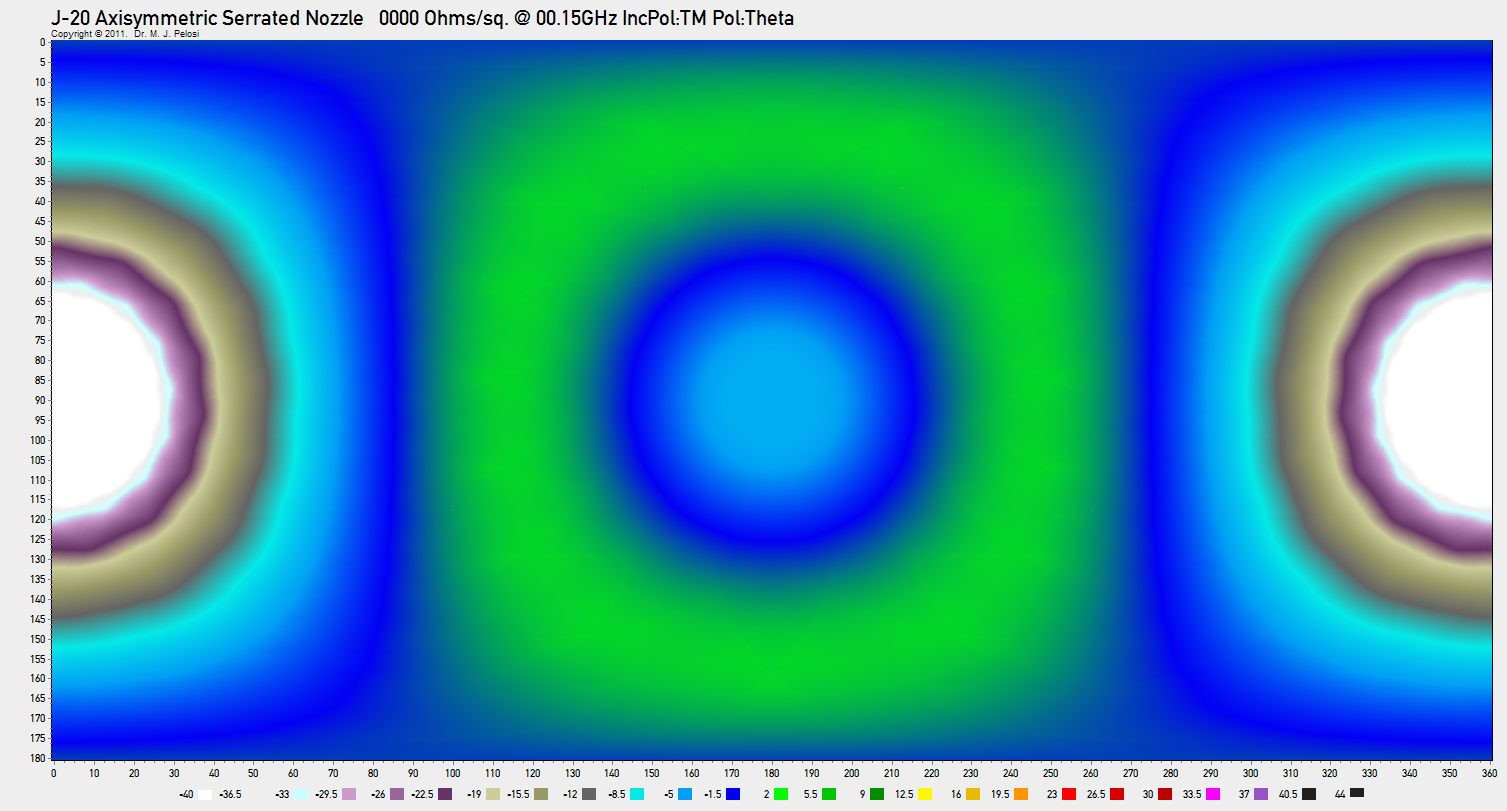
| | 600 MHz | 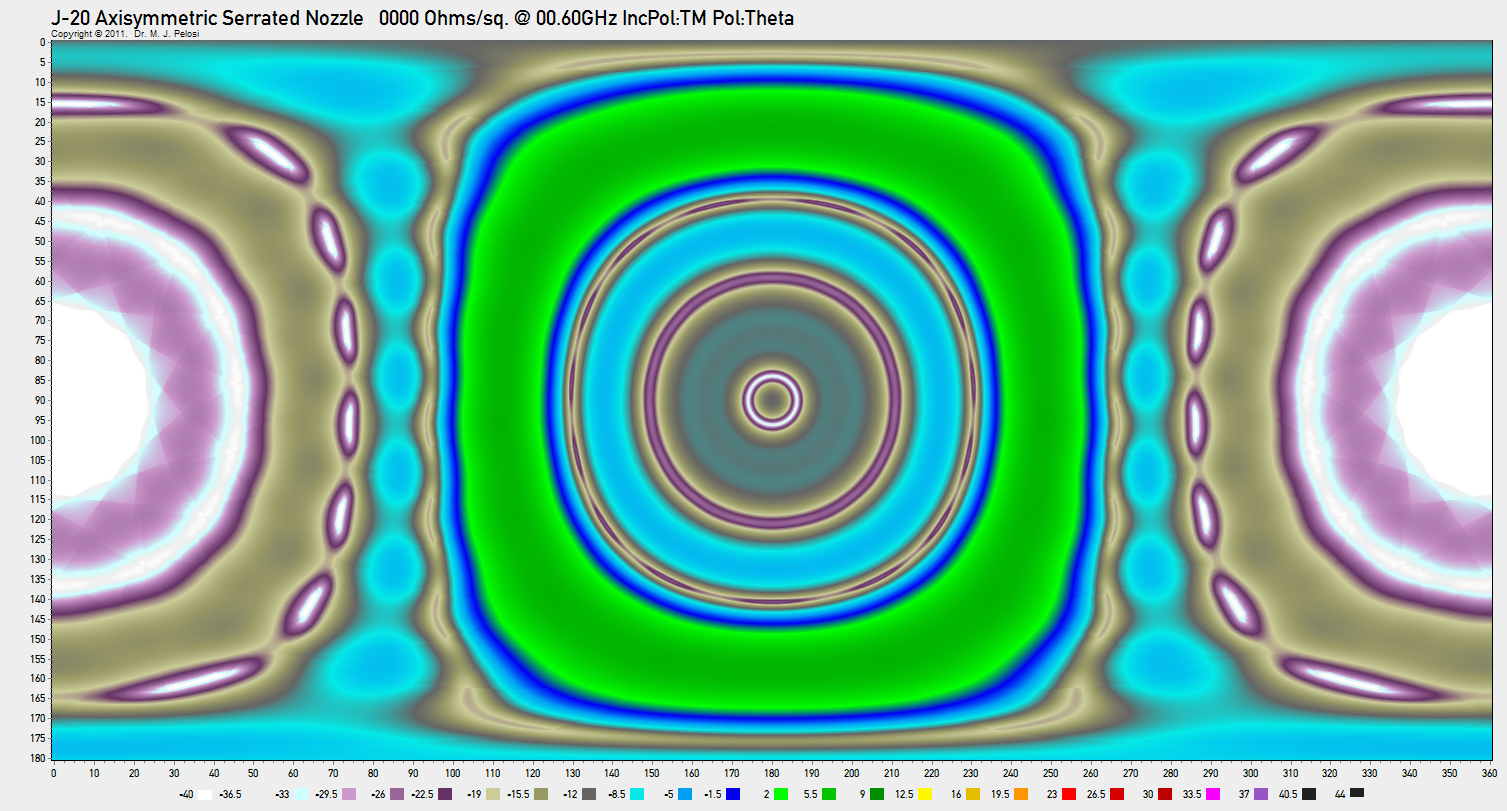
| | 1.2 GHz | 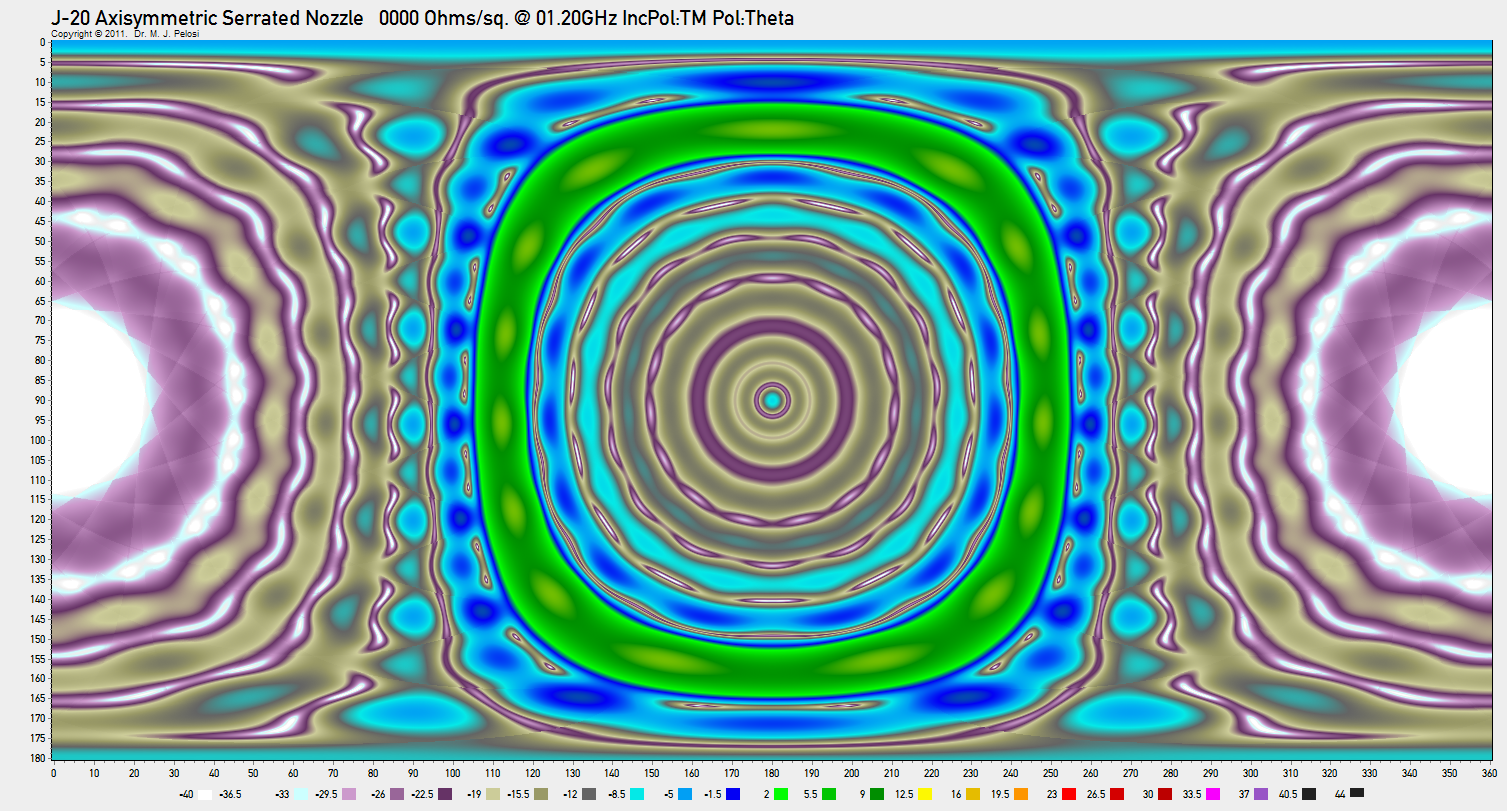
| | 3.0 GHz | 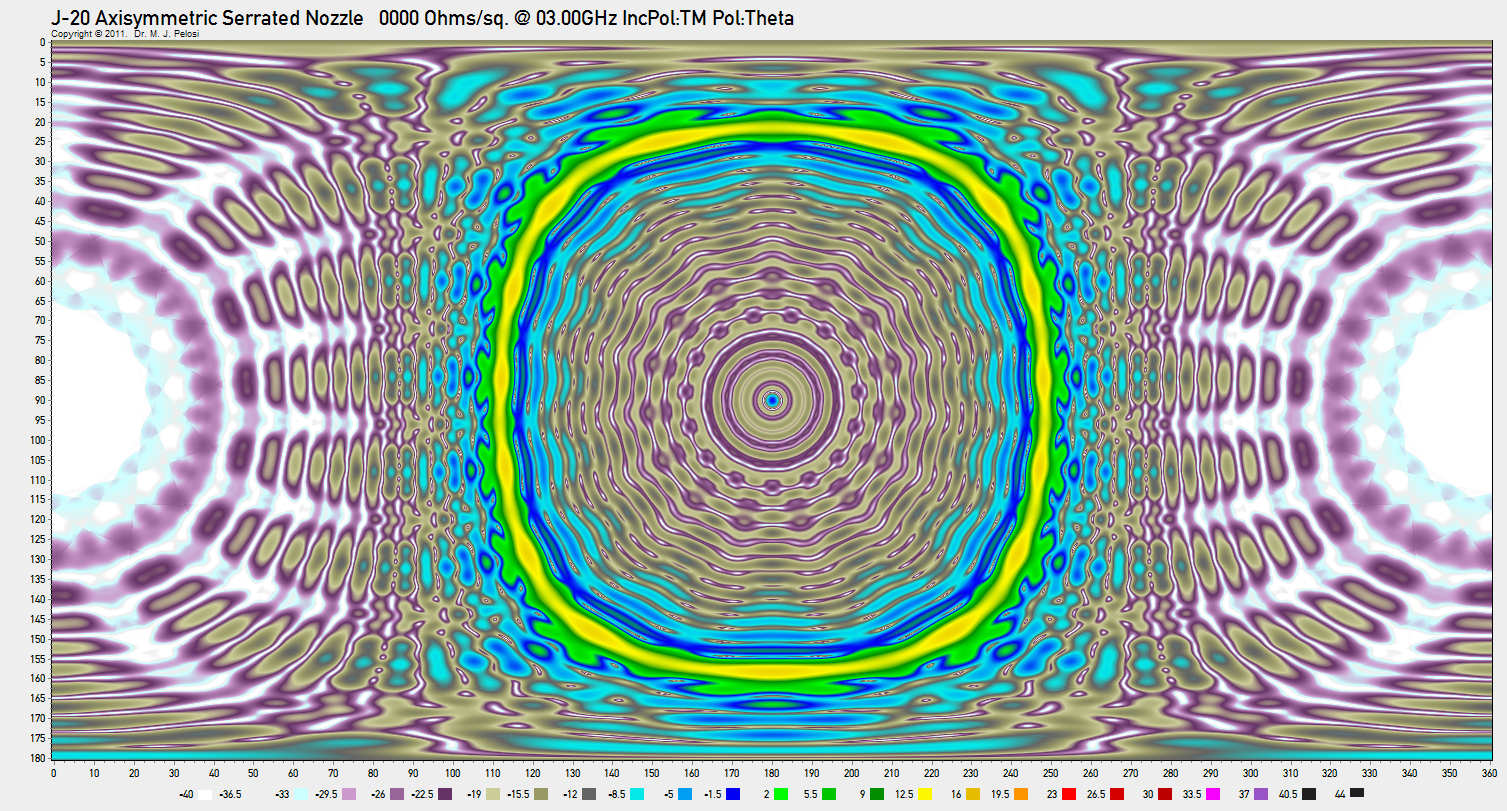
| | 6.0 GHz | 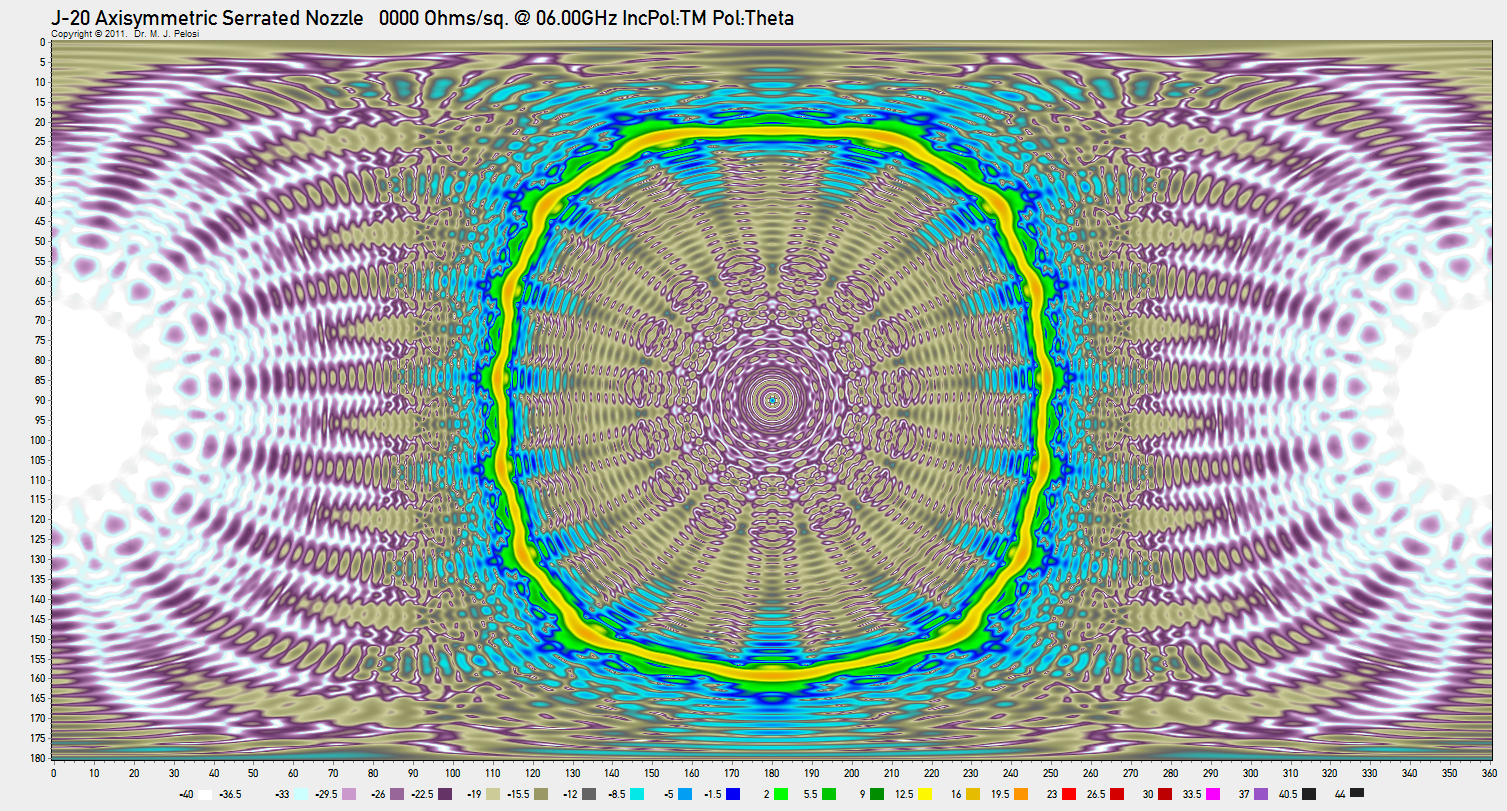
| | 8.0 GHz | 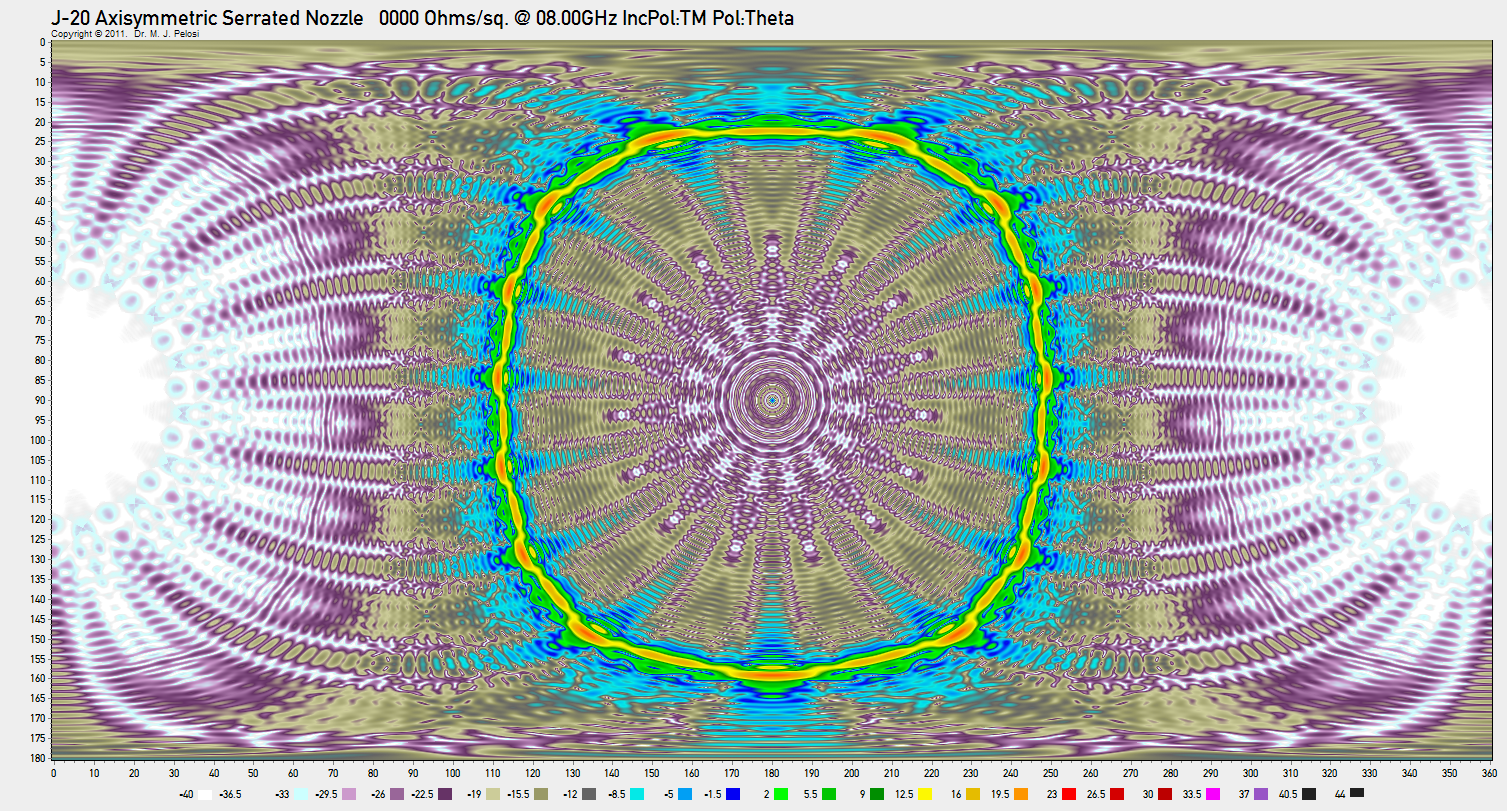
| | 12.0 GHZ | 
| | 16.0 GHz | 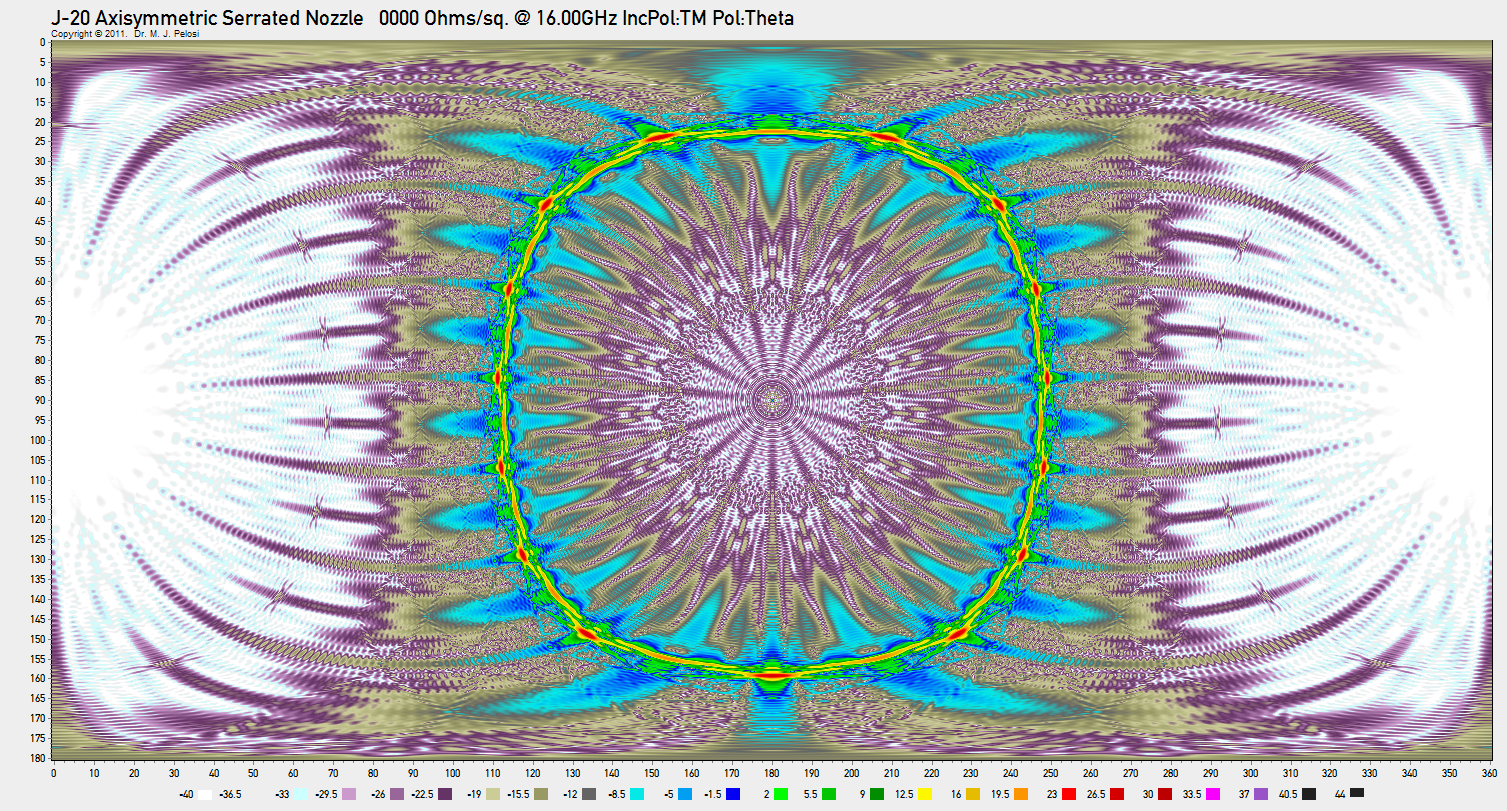
| | 28.0 GHz | 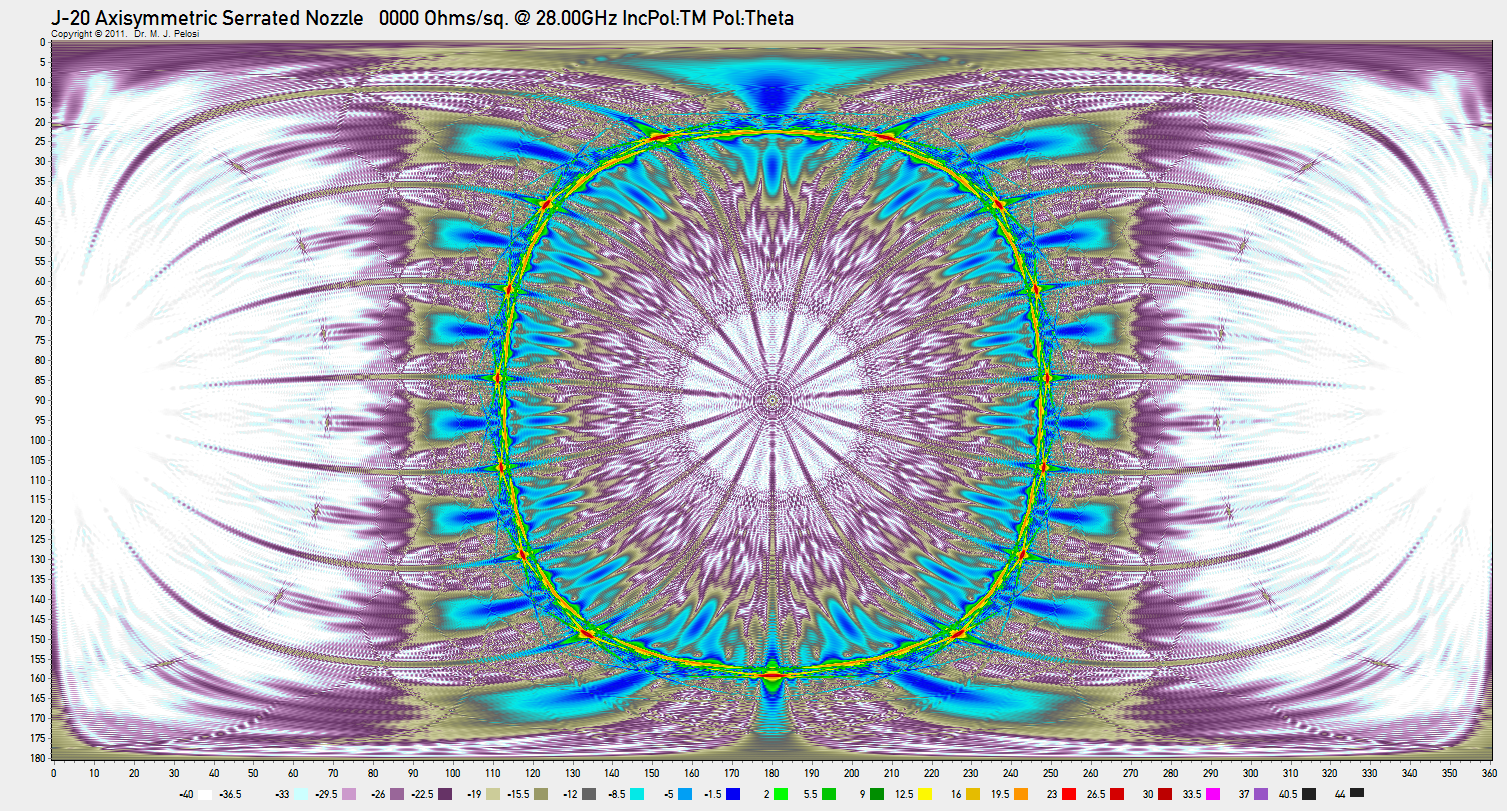
|
|
Notes: for angles off the axis of symmetry between 0° - 80° and 290° - 360°, the dominant contributions are the specular sidelobes produced by the nozzle petal shroud skins; the model employed did not include a PEA base. |
|
Annex D Viewing RCS Plots
Radar Cross Section plots in this document are represented in two formats, PCSR and PCPR. Both were devised with the intention of providing an easily interpreted graphical representation which can display information with much greater density than the traditional polar plots of RCS.
The use of PCSR and PCPR thus permits a significantly greater volume of data to be presented, compared to polar plots, but with some loss of resolution in magnitude due to the coarse quantisation of the colour scale. This quantisation error is acceptable given the logarithmic scale for RCS magnitude employed.
As this document is published in HTML, it permits easy viewing at a number of resolutions, determined by the browser employed.
All PCSR and PCPR plots are set up with HTML links to the original plots, which are PNG files with respective resolutions of 1000 x 1000 pixels and 1507 x 810 pixels. Clicking on the plot will display it in a user's browser window, or in a separate tab.
Different browsers display PNG graphics differently. Some, like Firefox, Chrome or Safari will initially display the plot scaled to fit the window size. If the window size is smaller than the graphic, clicking on the graphic will enlarge it to its native size on the user display.
It was intended that detailed viewing of PCSR and PCPR plots be performed in the latter fashion, and text font sizes have been set accordingly. A portion of a PCPR plot at native resolution is below.
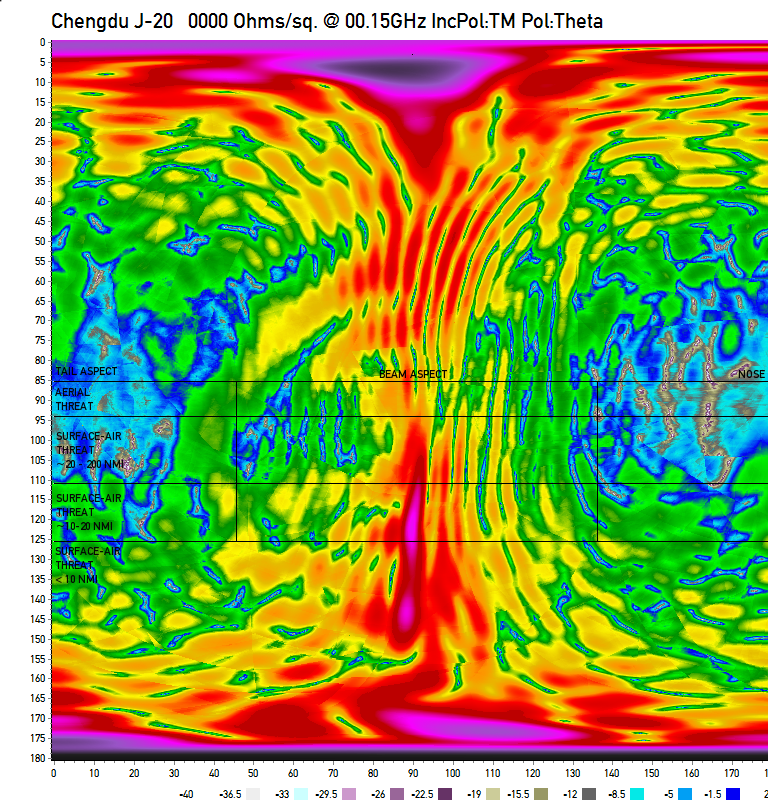
|
Annex E Glossary of Terms
2D TVC / Two Dimensional Thrust Vector Control: A TVC arrangement which can control the direction of the engine thrust in a single geometrical plane, typically in the pitching axis.
3D TVC / Three Dimensional Thrust Vector Control: A TVC arrangement which can control the direction of the engine thrust in two mutually orthogonal geometrical planes. AESA: Active Electronically Steered [Scanned] Array. A phased array antenna in which each element includes a solid state transmitter, receiver, and phase or delay beamsteering control component.
Azimuth Angles: The angle at which an illuminating emitter is seen in the plane of flight of the aircraft, relative to some datum such as the direction of flight.
CoG / Centre of Gravity: The center of gravity is a geometric property of any object. The center of gravity is the average location of the weight of an object [NASA GRC].
Carbon Nano-Tube (CNT): A CNT is one of eight allotropes of carbon, where the molecule is formed as a single or multiple walled tube, the walls of which are formed by connected hexagonal rings; sometimes CNTs are termed buckytubes.
CNT/Epoxy Absorbers: A RAM comprising an epoxy resin matrix loaded with Carbon Nanotube powder. dBSM: deciBels with reference to a square metre; a logarithmic measure of RCS computed by multiplying the logarithm to the base of ten of the RCS in square metres by ten.
Depression Angle: The angle at which an illuminating emitter is seen below the plane of flight of the aircraft. DSI (Diverterless Supersonic Inlet): A DSI is an inlet configuration where the inboard edge usually employed for boundary layer control is replaced by a blister shaped protrusion; in stealth design this is intended to remove the diffractive backscatter from the inboard inlet leading edge.
Elevation Angle: The angle at which an illuminating emitter is seen above the plane of flight of the aircraft. EO (Electro-Optical) Apertures: a cover usually intended to protect an electro-optical sensor from the effects of its physical environment without degrading its optical performance; the optical mirror or lens system which focusses photons on to an optical detection device such as an imaging chip.
Ferrite/Epoxy Absorbers: A RAM comprising an epoxy resin matrix loaded with a ferrite powder. Gap Treatment: An absorber material or shaping arrangement employed to reduce the RCS of a gap between two skin panels, or a movable surface or door and fixed skin panel.
Geometrical Diffraction: A method of computing RCS that is an extension of geometric optics that accounts for diffraction [Barton & Leonov]. Lossy Surface Coating: A type of RAM which is designed to produce electrical losses, but is not designed to necessarily suppress specular reflections.
Low Observable (LO): Early literature: any stealth aircraft; recent literature: a stealth aircraft with limited signature reduction, usually with an RCS between -10 and -30 dBSM. Matlab Language: An interpreted computer language for mathematical expressions used by the Matlab code.
NPS POFacets Code: A Physical Optics RCS simulator program designed and implemented at the Naval Postgraduate School in Monterey, California. Optics Scattering Regime: A scattering regime where the wavelength is smaller or very much smaller than the size of the object or shape scattering the wave. Panel Serration: A serration is a repetitive triangular pattern used along an edge and intended to scatter surface travelling waves in directions other than the normal to the line of the edge.
PCPR Format (PCPR): PolyChromatic Planar Representation (PCPR) is such a representation in which a rectangular area is divided into tiles by aspect angle pair {θ, Φ}. The colour of each tile represents the RCS from the angular direction determined by the path between the tile and the centroid of the aircraft. PCSR Format (PCSR): PolyChromatic Spherical Representation (PCSR) is such a representation in which a translucent sphere is rendered around a two-dimensional rendering of the aircraft, where the surface of the sphere is divided into tiles by aspect angle pair {θ, Φ}. The colour of each tile represents the RCS from the angular direction determined by the path between the tile and the centroid of the aircraft. Perfect Electrical Absorber (PEA): A material with a characteristic impedance equal to that of free space and an infinite loss for all wavelengths of interest.
Perfect Electrical Conductor (PEC): A material with a characteristic impedance of zero for all wavelengths of interest; an idealised conductive metal.
Physical Optics (PO): A method of computing RCS for which the local current density at
each point on the illuminated portion of the body is assumed to be identical to the current density that would flow at that point on an infinite tangent plane [Barton & Leonov]. Phased Array: “array antenna whose beam direction or radiation pattern is controlled primarily by the relative phases of the excitation coefficients of the radiating elements.” [Barton & Leonov]. Radar Absorber: The term absorber refers to a radar absorbing structure or material (RAS or RAM), the purpose of which is to soak up incident energy and reduce the energy reflected back to the radar [Barton & Leonov]. Radar Absorbent Materials (RAM): A material, such as a coating, employed as a radar absorber.
Radar Absorbent Structures (RAS): A structural component, such as a leading edge, employed as a radar absorber. Radar Cross Section (RCS): is “a measure of the reflective strength of a radar target.” The usual notation is σ. It is defined as σ = 4π Ps/Pi, where Ps is the power per unit solid angle scattered in a specific direction and Pi is the power per unit area in a plane wave incident on a scatterer from a specified direction [Barton & Leonov]. Radome: A radome is “a cover usually intended to protect an antenna from the effects of its physical environment without degrading its electrical performance.” [Barton & Leonov].
Raleigh Scattering Regime: A scattering regime where the wavelength is greater than the size of the object or shape scattering the wave; in Raleigh scattering, the backscatter is proportional to the inverse fourth power of the wavelength σ ∝ λ−4. Resonant Scattering Regime: A scattering regime where the wavelength is equal to or similar to the size of the object or shape scattering the wave. Specular RCS: RCS produced due to specular scattering effects only.
Specular Scattering: Scattering where a mirror-like reflection is produced by the scattering object or shape; usually the wavelength is smaller than the size of the object or shape scattering the wave. Thrust Vector Control (TVC): Any gas turbine or rocket propulsion exhaust nozzle arrangement which permits the direction of the exhaust efflux and thus thrust to be controlled. Common arrangements include steerable nozzles, vanes or paddles.
Very Low Observable (VLO): a stealth aircraft with very good signature reduction, usually with an RCS smaller than -30 dBSM.
|
|
|
|




